Motorola Mobility T6EE1 Licensed Portable w/ Bluetooth User Manual Exhibit 8 Users Manual
Motorola Mobility LLC Licensed Portable w/ Bluetooth Exhibit 8 Users Manual
Contents
- 1. Exhibit 8 Users Manual
- 2. Exhibit 8a Users Manual
- 3. Supplemental Users Manual Response to TC4252 and TC4253
Exhibit 8 Users Manual

APPLICANT: MOTOROLA, INC. FCC ID: IHDT6EE1
INSTRUCTION MANUAL
An English version preliminary draft copy of the Users Manual follows:
EXHIBIT 8

ENGLISH
1
Introduction
Introduction
Congratulations on being the owner of a brand new Motorola mobile phone.
In addition to making calls, MMS, Email, and Internet access, you can use a good many other
functions just like those of a Multimedia Palm, such as multifunction Address Book, Date Book,
Note Pad, Audio Recorder, Camera, Paint, Media Center, My Document (File Manager),
Bluetooth, Modem and Data Synchronizer. Wireless GPRS downloading will extend your phone
functions and close up to your life.
The product brings innovative concepts to mobile communication with its colorful touch screen
and graphic interfaces, which offer streamlined operation, enhanced functionality, and "One-
Touch" information acquisition and processing.
It is designed with a unique open display window to deliver you more careful consideration and
make your info fetching more convenient and rapid.
Either in office or at home, you'll feel more delighted with a distinct function that sends your
Date Book in short messages.
You'll enjoy your creativeness by composing pictures, photos, animations, and musical pieces in
your individual style with the Paint and distributing them in short messages.
The new Media Center will provide you with audio and video refreshment in your spare time.
The unique Camera function makes it possible to share wonderfulness with your friends any-
where and anytime, by taking pictures simply and easily.
Although the product is excellently designed for wonderfulness, you can only make perfect use
of it with your understanding and imagination. Look into the manual and see how you can enter
a splendid world of communication.
Introduction

ENGLISH
Introduction
2Introduction
Copyright Description
1. Java and all other Java-based logos are all trademarks or registered trademarks of
SUN Corporation in America or other countries.
2. The product adopts "iType" technology and font of Agfa Monotype Corporation.
3. Refer to the Appendix for GNU copyright information.
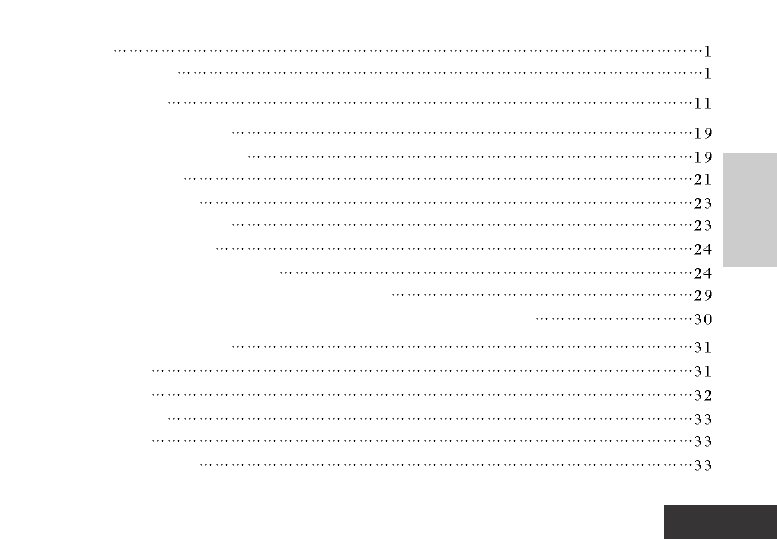
ENGLISH
3
Contents
Contents
Contents
Introduction
Congratulations
Safety Information
Chapter 1 Getting Started
Functions of External Keys
SIM Card, Battery
Charging the Battery
Turning on Your Phone
Turning off Your Phone
Screen Display and Operation
Functions of External Display (when flip closed)
About terms and pictures used in the manual to describe operations
Chapter 2 Entry Methods
Handwriting
Pinyin Board
English Board
Numeric Pad
Functional Buttons

ENGLISH
Contents
4Contents
Chapter 3 Phone Function
Sending a Phone Call
Dialing an Emergency Number
Receiving a Phone Call
Dialing an International Call
Directly Dialing Extension or Voicemail
Dialing an Extension Number
In-Call Functions
Turbo Dial
Dialing a Number Stored in SIM Card
Multiparty Conversation (Making a Conference Call)
Transferring a Call
Calls Record
Call Cost
My Tel. Number
Network Setup
Chapter 4 Address Book
Showing Address Book List
Adding New Contacts
Copying Contact Data Information
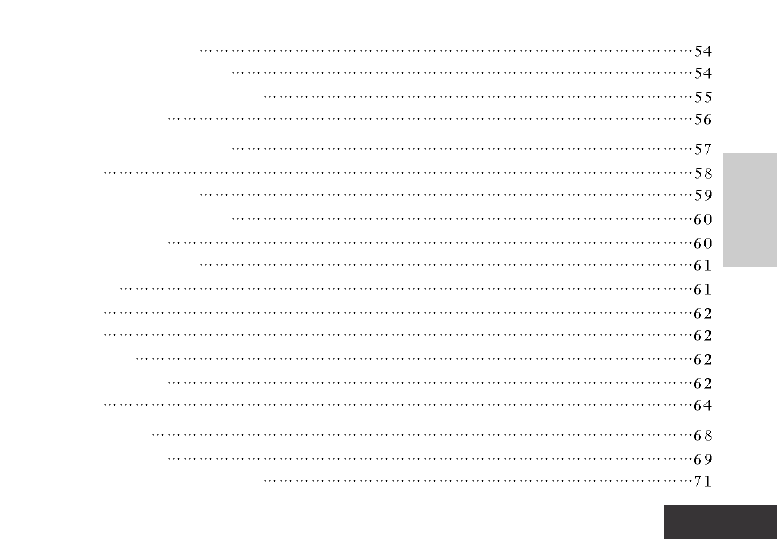
ENGLISH
5
Contents
Contents
Deleting a Contact
Searching for a Contact
Viewing Owner's Information
Sending Vcards
Chapter 5 Message Center
Inbox
Viewing Messages
Writing a Short Message
Signature Setup
Sending a Message
Outbox
Drafts
Trash
SIM Card
Private Folder
MMS
Chapter 6 Email
Mailbox Setup
Writing and Sending Emails

ENGLISH
Contents
6Contents
Receiving, Viewing, Reading a Mail or Sorting Mails
Private Folder
Chapter 7 Browser
Activating WAP Browser
Browsing Information and Using Access Function
Downloading Files
Chapter 8 Camera
View-Finding
Shoot
Preview or Delete Video or Photo
Effects
Setup Options
Chapter 9 Media Center
Playing Audio and Video Files
Chapter 10 Picsel Browser
View
Special Functions
Preferred Setting
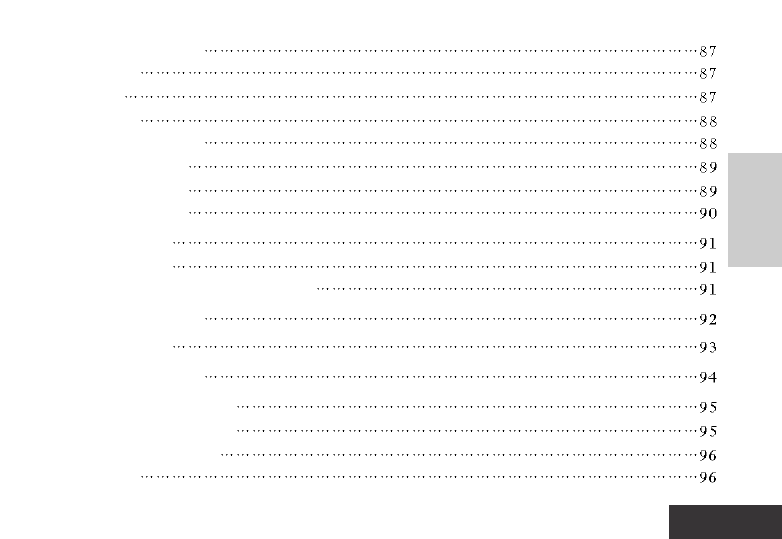
ENGLISH
7
Contents
Contents
Chapter 11 Date Book
Month View
Day View
Week View
Adding a New Event
Editing an Event
Deleting an Event
Date Book Setup
Chapter 12 Tasks
Viewing Tasks
Creating, Editing, and Saving a Task
Chapter 13 Note Pad
Chapter 14 Paint
Chapter 15 Recorder
Chapter 16 My Document
Editing Files and Folders
Creating a New Folder
Viewing by
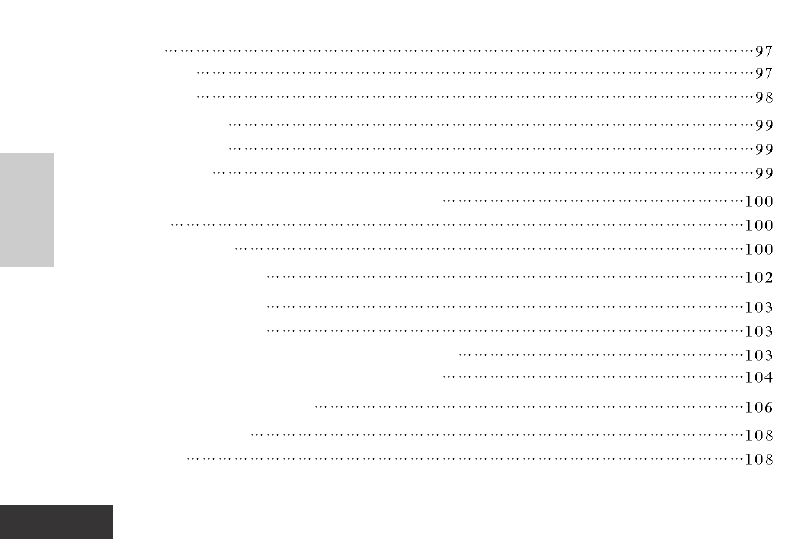
ENGLISH
Contents
8Contents
Sorting
Searching
Folder Tree
Chapter 17 Share
Receiving Data
Sending Data
Chapter 18 Alarm Clock and Worldwide Clock
Alarms
Worldwide Clock
Chapter 19 Calculator
Chapter 20 Bluetooth
Turning on Bluetooth
Viewing, Adding, and Setting Bluetooth Devices
Using Bluetooth for Information Transmission
Chapter 21 STK Application
Chapter 22 Network
Network
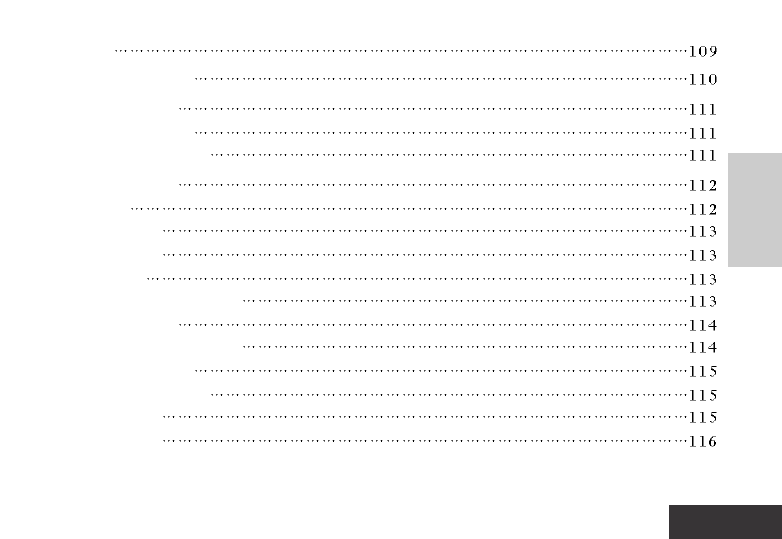
ENGLISH
9
Contents
Contents
Profiles
Chapter 23 Security
Chapter 24 Theme
Selecting a theme
Configuring a theme
Chapter 25 Setup
Language
Time and Date
Volume Setup
Entry Setup
Touch Screen Calibration
Backlight Setup
Voice Recognition Setup
Infrared Receiving
Power Management
Master Reset
Master Clear

ENGLISH
Contents
10 Contents
Chapter 26 Voice Instruction
Loading Voice Recognition
Using Voice Recognition
Reciting
List of Voice Instruction and Functions
Chapter 27 Data Synchronization
Chapter 28 Modem
Chapter 29 VPN (Virtual Private Network)
Creating New Policy
Logging into the VPN
Chapter 30 Troubleshooting
Chapter 31 Specific Absorption Rate
This model phone meets the international requirements for exposure to radio waves.
Chapter 32 Appendix
Note:The functions available on this mobile phone may vary in different regions and nations. Please contact
your local customer service centers, agencies or retailers if you have any question about the mobile phone
functions. Motorola reserves all rights to revise and change this user's manual without obligation to notify
any person of such revisions or changes.

11
Safety Information
Safety Information
IMPORTANT INFORMATION ON SAFE AND EFFICIENT OPERATION. READ THIS INFOR-
MATION BEFORE USING YOUR PHONE.
The information provided in this document supersedes the general safety information in user
guides published prior to December 1, 2002.
Exposure To Radio Frequency (RF) Energy
Your phone contains a transmitter and a receiver. When it is ON, it receives and transmits RF
energy. When you communicate with your phone, the system handling your call controls the
power level at which your phone transmits.
Your Motorola phone is designed to comply with local regulatory requirements in your country
concerning exposure of human beings to RF energy.
Operational Precautions
To assure optimal phone performance and make sure human exposure to RF energy is within
the guidelines set forth in the relevant standards, always adhere to the following procedures.
External Antenna Care
Use only the supplied or Motorola-approved replacement antenna. Unauthorised antennas,
modifications, or attachments could damage the phone.
Do NOT hold the external antenna when the phone is IN USE. Holding the external antenna
affects call quality and may cause the phone to operate at a higher power level than needed. In
addition, use of unauthorised antennas may result in non-compliance with the local regulatory
Safety and General Information
ENGLISH

ENGLISH
Safety Information
12 Safety Information
requirements in your country.
Phone Operation
When placing or receiving a phone call, hold your phone as you would a wireline telephone.
Body-Worn Operation
To maintain compliance with RF energy exposure guidelines, if you wear a phone on your body
when transmitting, always place the phone in a Motorola-supplied or approved clip, holder, hol-
ster, case, or body harness for this phone, if available. Use of accessories not approved by
Motorola may exceed RF energy exposure guidelines. If you do not use one of the body-worn
accessories approved or supplied by Motorola, and are not using the phone held in the normal
use position, ensure the phone and its antenna are at least 1 inch (2.5 centimetres) from your
body when transmitting.
Data Operation
When using any data feature of the phone, with or without an accessory cable, position the
phone and its antenna at least 1 inch (2.5 centimetres) from your body.
Approved Accessories
Use of accessories not approved by Motorola, including but not limited to batteries and antenna,
may cause your phone to exceed RF energy exposure guidelines. For a list of approved
Motorola accessories, visit our website at www.Motorola.com.
RF Energy Interference/Compatibility

13
Safety Information
Safety Information
Note: Nearly every electronic device is susceptible to RF energy interference from external
sources if inadequately shielded, designed, or otherwise configured for RF energy compatibility.
In some circumstances your phone may cause interference.
Facilities
Turn off your phone in any facility where posted notices instruct you to do so. These facilities
may include hospitals or health care facilities that may be using equipment that is sensitive to
external RF energy.
Aircraft
When instructed to do so, turn off your phone when on board an aircraft. Any use of a phone
must be in accordance with applicable regulations per airline crew instructions.
Medical Devices
Pacemakers
Pacemaker manufacturers recommend that a minimum separation of 6 inches (15 centimetres)
be maintained between a handheld wireless phone and a pacemaker.
Persons with pacemakers should:
•
ALWAYS keep the phone more than 6 inches (15 centimetres) from your pacemaker when
the phone is turned ON.
•
NOT carry the phone in the breast pocket.
ENGLISH

ENGLISH
Safety Information
14 Safety Information
•
Use the ear opposite the pacemaker to minimise the potential for interference.
•
Turn OFF the phone immediately if you have any reason to suspect that interference is tak-
ing place.
Hearing Aids
Some digital wireless phones may interfere with some hearing aids. In the event of such inter-
ference, you may want to consult your hearing aid manufacturer to discuss alternatives.
Other Medical Devices
If you use any other personal medical device, consult the manufacturer of your device to deter-
mine if it is adequately shielded from RF energy. Your GP may be able to assist you in obtaining
this information.
Use While Driving
Check the laws and regulations on the use of phones in the area where you drive. Always obey
them.
When using your phone while driving, please:
•
Give full attention to driving and to the road.
•
Use hands-free operation, if available.
•
Pull off the road and park before making or answering a call if driving conditions so require.

ENGLISH
15
Safety Information
Safety Information
Operational Warnings
For Vehicles With an Air Bag
Do not place a phone in the area over an air bag or in the air bag deployment area. Air bags
inflate with great force. If a phone is placed in the air bag deployment area and the air bag
inflates, the phone may be propelled with great force and cause serious injury to occupants of
the vehicle.
Potentially Explosive Atmospheres
Turn off your phone prior to entering any area with a potentially explosive atmosphere, unless it
is a phone type especially qualified for use in such areas and certified as "Intrinsically Safe." Do
not remove, install, or charge batteries in such areas. Sparks in a potentially explosive atmos-
phere can cause an explosion or fire resulting in bodily injury or even death.
Note: The areas with potentially explosive atmospheres referred to above include fuelling areas
such as below decks on boats, fuel or chemical transfer or storage facilities, areas where the air
contains chemicals or particles, such as grain, dust, or metal powders. Areas with potentially
explosive atmospheres are often but not always posted.
Blasting Caps and Areas
To avoid possible interference with blasting operations, turn OFF your phone when you are near
electrical blasting caps, in a blasting area, or in areas posted "Turn off electronic devices." Obey
all signs and instructions.
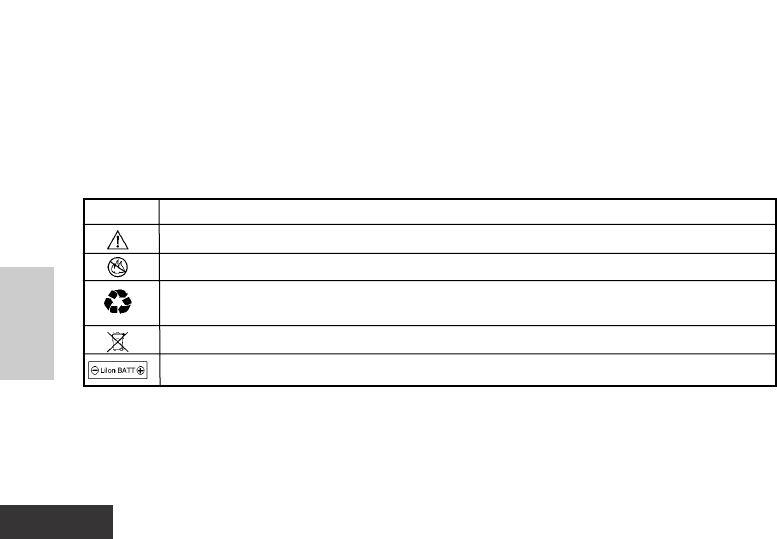
ENGLISH
Safety Information
16 Safety Information
Batteries
Batteries can cause property damage and/or bodily injury such as burns if a conductive material
such as jewellery, keys, or beaded chains touch exposed terminals. The conductive material
may complete an electrical circuit (short circuit) and become quite hot. Exercise care in handling
any charged battery, particularly when placing it inside a pocket, bag, or other container with
metal objects. Use only Motorola original batteries and chargers.
Your battery or phone may contain symbols, defined as follows:
Symbols Definition
Important safety information will follow.
Your battery or phone should not be disposed of in a fire..
Your battery or phone may require recycling in accordance with local laws. Contact
your local regulatory authorities for more information.
Your battery or phone should not be thrown in the trash.
Your phone contains an internal lithium ion battery.
Seizures/Blackouts
Some people may be susceptible to epileptic seizures or blackouts when exposed to blinking
lights, such as when watching television or playing video games. These seizures or blackouts
may occur even if a person never had a previous seizure or blackout.

ENGLISH
17
Safety Information
Safety Information
If you have experienced seizures or blackouts, or if you have a family history of such occur-
rences, please consult with your doctor before playing video games on your phone or enabling
a blinking-lights feature on your phone. (The blinking-light feature is not available on all prod-
ucts.)
Parents should monitor their children's use of video game or other features that incorporate
blinking lights on the phones. All persons should discontinue use and consult a doctor if any of
the following symptoms occur: convulsion, eye or muscle twitching, loss of awareness, involun-
tary movements, or disorientation.
To limit the likelihood of such symptoms, please take the following safety precautions:
•
Do not play or use a blinking-lights feature if you are tired or need sleep.
•
Take a minimum of a 15-minute break hourly.
•
Play in a room in which all lights are on.
•
Play at the farthest distance possible from the screen.
Repetitive Motion Injuries
When you play games on your phone, you may experience occasional discomfort in your
hands, arms, shoulders, neck, or other parts of your body. Follow these instructions to avoid
problems such as tendonitis, carpal tunnel syndrome, or other musculoskeletal disorders:
•
Take a minimum 15-minute break every hour of game playing.
•
If your hands, wrists, or arms become tired or sore while playing, stop and rest for several
hours before playing again.
•
If you continue to have sore hands, wrists, or arms during or after play, stop playing and see
a doctor.
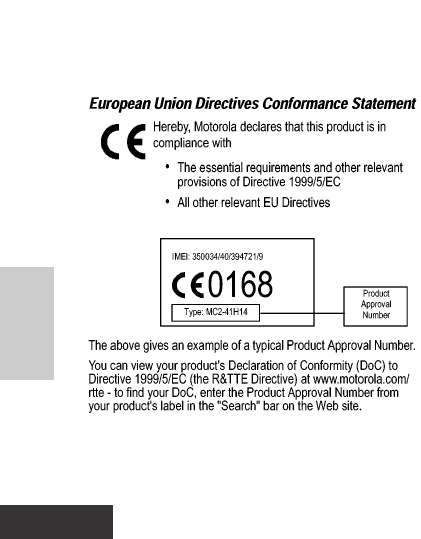
ENGLISH
Safety Information
18 Safety Information
European Union Directives Conformance Statement
The above gives an example of a typical Product
Approval Number.
You can view your product's Declaration of
Conformity (DoC) to Directive 1999/5/EC (the
R&TTE Directive) at www.motorola.com/rtte - to
find your DoC, enter the product Approval
Number from your product's label in the "Search"
bar on the Web site
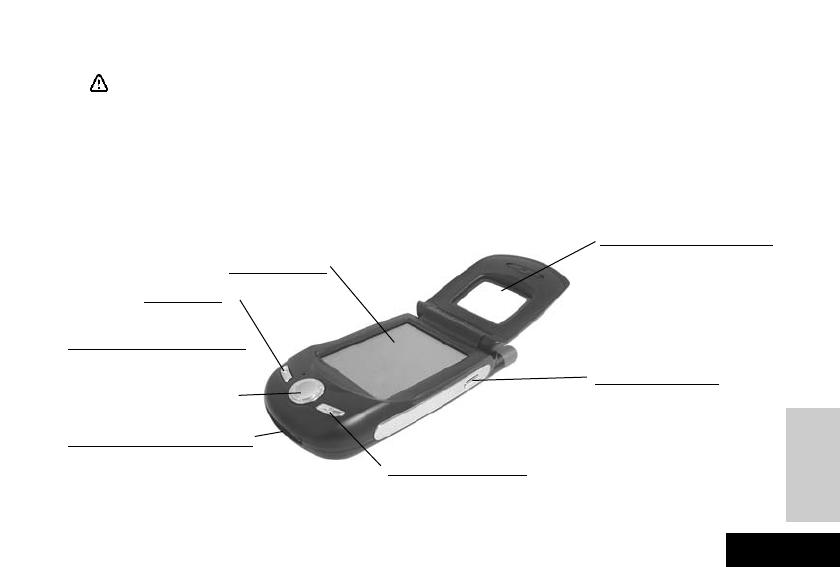
ENGLISH
19
Getting Started
Getting Started
Chapter 1 Getting Started
Note Do not touch the touch screen with sharp objects or dirty stylus. Do not
use the stylus when its point is broken; Otherwise, your touch screen may
be damaged. It is a normal phenomenon that the screen responds slower
in low temperature.
Functions of External Keys
Your phone appears as follows.
Power Key
Up/Down Navigation Key
Scroll the screen to show
the content in the previ-
ous or the next screen.
Touch Screen
Quick Function Key
In most screen status,
press the key to return to
the main screen.
Recorder Softkey
When you are in a call, you
can press the key to start or
terminate recording.
When your phone is idle
and the cover is closed,
you can press the key to
display the time and date.
Transparent Display Window
If the cover is closed,
the prompting message
will be shown in the win-
dow when receiving
incoming calls or short
messages.
Charger slot/Data line slot
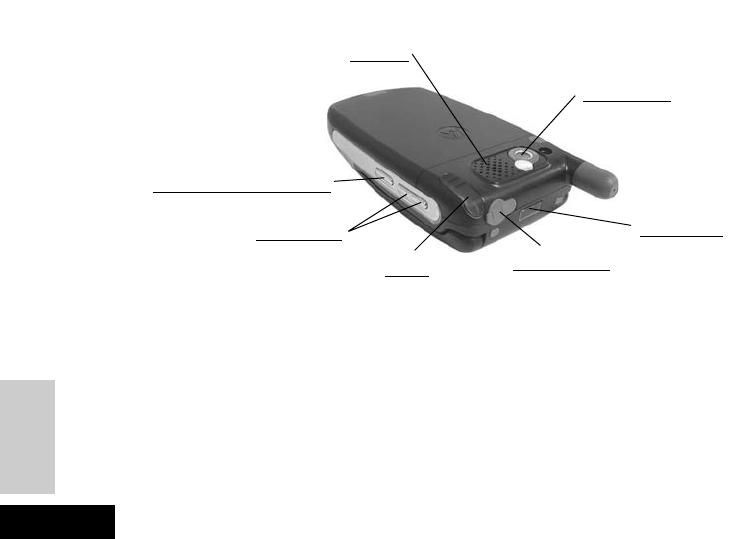
ENGLISH
Getting Started
20 Getting Started
Volume Key
1. Increase/decrease the volume in a call.
2. Navigate through and select various functional symbols on the Main Menu Screen
in combination with the Select Key.
3. Adjust the focus in the Camera function screen.
4. Silence the ringing of an incoming call when the phone cover is closed.
5. Adjust the player volume when playing back audio or video files in the media center.
Speaker
Camera Len
IR Interface
Headset Jack
Volume Key
Stylus
Select Key
(Voice Instruction Key)

ENGLISH
21
Getting Started
Getting Started
Select Key
1. Perform selection function in combination with the Volume Key without touching the screen.
2. Switch between portrait and landscape in the Camera function screen.
3. Press and hold the key to active voice recognition system, enabling the voice dialing function.
SIM Card, Battery
The SIM (Subscriber Identity Module) card is used to store the telephone number
offered by your network operator as well as details on other services. You may also
use it to store frequently-used telephone numbers and information on persons.
Note The SIM card is necessary for wireless communication, such as making a
call or sending a short message. Certain networks allow you to dial emer-
gency numbers using your phone without a SIM card being inserted.
Note Please keep your SIM card with care. Never bend or scratch it. Avoid hav-
ing it exposed to static electricity or water.
Note Power off your phone to replace the battery or remove/install the SIM card.
Operate as follows to install a battery and SIM card (it is unnecessary to remove the
battery when using the phone for the first time):

ENGLISH
Getting Started
22 Getting Started
1. Hold the phone body face-down in your palm;
2. Press the release button and slide down the back cover with the other hand to
remove the cover.
3. Insert the SIM card into the SIM slot. Make sure the corner cutting of the card is
aligned to the notch of the slot and the gold plate of the card faces downward.
4. Insert the battery into the compartment, with the metallic contacts facing down.
5. Push down the other end of the battery until it snaps into the compartment.
6. Replace the back cover and slide it forward completely.
Tips If problems occur on your SIM card, contact your network operator.
Tips
A new battery would reach its best performance after several full charge/dis-
charge cycles. Do not use the battery in extremely low temperature.
Tips Battery performance and maintenance:
1. Always use the batteries and battery chargers approved by Motorola Corporation.
The phone warranty does not cover damage caused by using non-Motorola-
approved batteries and/or battery chargers.

ENGLISH
23
Getting Started
2. Maintain the battery at or near room temperature when charging.
3. Batteries to be left unused for an extended time period should be discharged and
saved in a cold, dark, and dry place.
4. Over extended periods of time, batteries gradually wear down and require longer
charging times. This is normal. If you charge your battery regularly and notice a
decrease in talk time or an increase in charging time, then it is probably time to pur-
chase a new battery.
Charging the Battery
A travel charger may be used to charge the battery equipped in your phone as follows:
1. Ensure your phone is equipped with a battery.
2. Plug the connector of the charger into the bottom slot of your phone.
3. Plug the other end of the travel charger into an appropriate AC outlet.
Note Use a special battery charger designed for A760 ; Make sure the local AC
voltage is accordance with the rated voltage of the charger; Use an
appropriate adapter plug.
4. Your phone emits an alerting tone when the charging is initiated. You may charge
your phone when it is powered on or off.
5. When the charging is completed, disconnect the power supply and unplug the
phone from the charger.
Getting Started
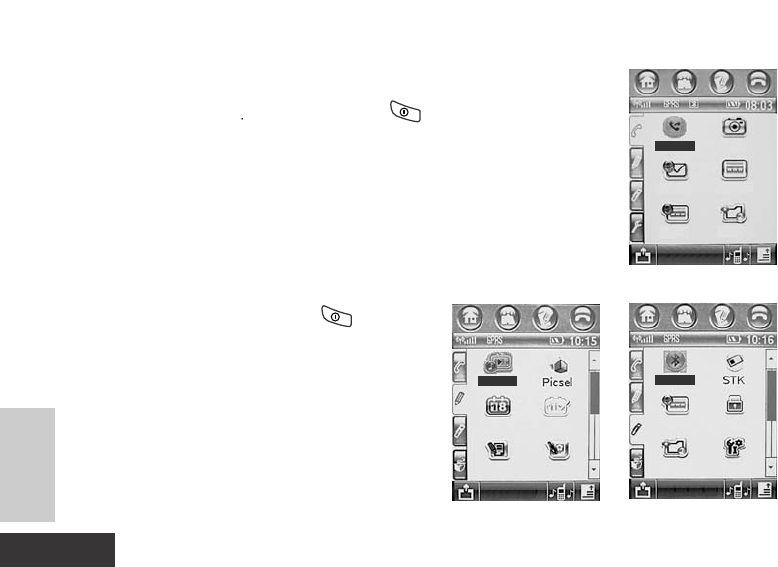
ENGLISH 24 Getting Started
Turning on Your Phone
Open the phone cover Press and hold the key. Your phone starts and
opens the Main Screen.
Additional steps may be required to power on the phone if you enabled SIM PIN
and unlocking code for enhanced security and functional flexibility.
Your phone displays "No SIM Card" if you have inserted no SIM card. In such a
case, two options are available: Antenna Off or Antenna On.
Turning off Your Phone
Open the phone cover in the standby
mode. Press and hold the key for a
while until the phone screen disappears.
Screen Display and Operation
The phone is designed with a brand new con-
cept that combines functionalities of both a
mobile and a Palm PC. You may operate just
like you do on a Palm PC, using a stylus sup-
plied with the phone to touch the transparent
GUI interface on the LCD touch screen for func-
tion selection, writing, drawing, and message
Getting Started
Screen 1
Screen 2 Screen 3
Bluetooth
Theme
Network
Calendar Tasks
Drawing Pad
Note Pad
Security
Setup
Media
Recent Call Camera
Browser
Theme
Email
Network

ENGLISH
25
Getting Started
entry. The WYSIWYG interface combines information display with your operation. Sufficient
information display is available that varies according to the current function. You may proceed
with simple operations just according to screen instructions.
Functions of Internal Display
When you turn on your phone, it displays Main Screen 1, as shown in Figure 1. To access other
three Main Screens, tap the Page label on the left side of the screen and you may navigate
through Main Screen 2, 3, and 4 (see Figure 2, 3, and 4). These screens contain certain func-
tional icons, each of which may be used to access a specific function.
1. The top buttons bar includes:
Main Screen button: Tap the button and the phone will display the Main Screen.
Address Book button: Tap the button and the phone will display the contact list.
Message button: Tap the button to bring the phone into the message function.
Phone Function button: Tap the button and the phone will display the dialpad.
Prompt button: The button will be displayed at the top of the screen when the phone receiv-
ing a missed call or a new message. Tap the button to display a list of relevant information.
2. Icons in the status bar indicate operating mode, including:
Signal Strength Indicator: The indicator shows the signal strength. The more vertical
bars visible, the more intense the signal.
Getting Started
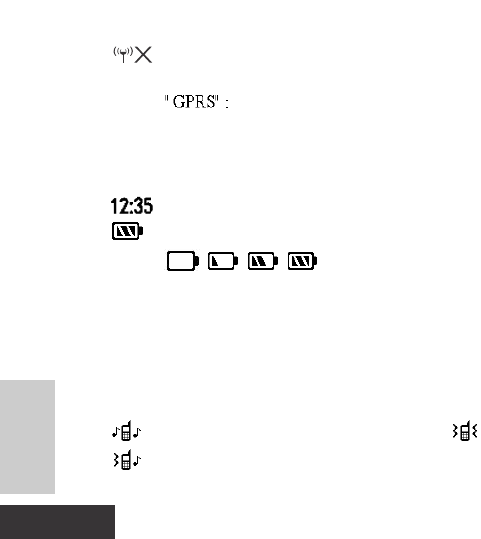
ENGLISH 26 Getting Started
Phone Function Off: Indicates the communication function (such as making calls) is
not available and the phone is in the Palm mode;
GPRS The indicator means your phone is in a network with GPRS support and the
GPRS function of your phone has been enabled. "GPRS" in dark indicates you have
not subscribed for the function or the function is not available right now. If "GPRS" is
highlighted, you have subscribed for the function and the function is available right
now. Contact your network operator for details.
Clock: Your phone shows the time.
Battery Level Indicator:
Shows the amount of charge remained in your battery
from exhausted to full.
Tap on the status bar to list the current device status. You may view the network cur-
rently in use, whether the phone function is turned on or off, or the battery level.
3. Function Bar includes:
Vibration/Ring (See the following icons): Tap the icon to select how your phone would
remind you, vibrating or just ringing.
Ring on an incoming call (message);
Vibrate on an incoming call (message);
Vibrate first and then ring on an incoming call (message);
Getting Started

ENGLISH
27
Getting Started
Keep silence on an incoming call (message).
Network operator symbol: The name of the network operator will be displayed if the
SIM card you have inserted functions normally.
Return button.
Tap the icon to pop up a menu, from which you may select an option. You may
modify how or in what sequence the functional icons would be displayed, down-
load or remove an application, or view the memory status.
4. Function icon: You may tap any of the icons from the function zone to call up a
function screen corresponding to the icon.
Records on calls received, missed, and dialed
To take a picture or record a video;
To view, send, or receive emails;
To open the WAP browser for Internet access;
To set up and connect to the network;
Getting Started
Recent Call
Camera
Email
Browser
Network
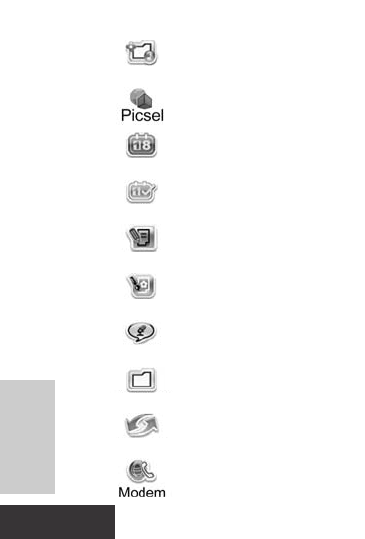
ENGLISH 28 Getting Started
For personalized configuration;
You may view files in PDF, Word, or Excel format;
To show the Date Book and make arrangements;
A memo for daily affairs;
To record your idea anywhere and anytime;
To edit pictures;
To activate the Recorder function for quick and easy information recording;
To list, view, and manage your files;
To activate Data Synchronization for data exchange between your phone and certain devices, i.e. a computer;
Modem;
Getting Started
Theme
Calendar
Tasks
Note Pad
Drawing Pad
Recorder
File Manager
Sync

ENGLISH
29
Getting Started
To playback audio and video files;
An alarm clock to remind you at certain time and date;
To set up and view the time of the main cities in the world;
To use the Calculator function;
To show a list of devices for data transmission;
For security and codes setup;
To completely personalize your phone;
To activate the STK function and show a list of available services;
To connect your phone to VPN (Virtual Private Network)
Functions of External Display(when flip closed)
Getting Started
Media
Alarm Clock
WorldTime
Calculator
Bluetooth
Security
Setup
VPN

ENGLISH 30 Getting Started
Answering a Call
Say you receive a call. If the caller's name and picture are stored in your phone, they will be displayed
on the External Screen; otherwise, only the number of the caller and a default picture displays. Open
the phone cover; press the Answer key to answer the call. You may also answer the call by simply
opening the phone cover, provided that you have enabled the "Open Cover to Answer" to answer,
Receiving Short Messages
When your phone receives a short message, the External Screen prompts you that a new message is received.
Alarm Notification
If you have specified an alarm clock and now it's time you previously specified for alerting, your
phone notifies you and the External Screen shows an alarm clock symbol as well as the time.
Ringer Volume
Press and hold the Volume Key to show a list of ringer volumes on the External
Screen. To navigate through the list, press the Volume +/- Key.
About terms and pictures used in the manual to describe operations
"Tap": Touch the screen using the stylus briefly, on a specific place such as a button or function icon.
"Tap and Hold": Touch the screen using the stylus for a few seconds, on a specific place such
as a button or function icon.
Pictures are given in the manual for functional description purpose only. Displays on your phone
may be different. Refer to your phone for details.
Getting Started
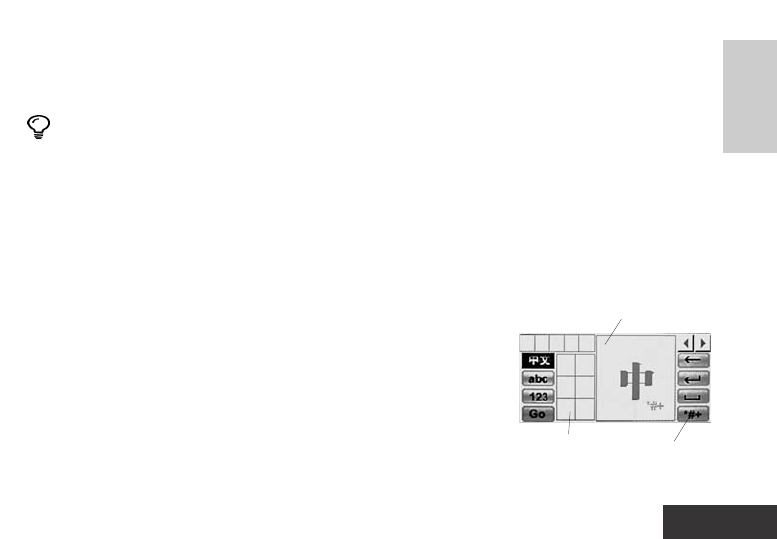
ENGLISH
31
Entry Methods
Entry Methods
Chapter 2 Entry Methods
Your phone offers several easy-to-use text entry methods to help you utilize certain
functions. Generally, you may tap a text entry area where you would enter text to bring
up a text entry box, where you can select from these methods for entry.
Tips 1. To activate an entry method, tap on the area where you want to enter
text. A method is automatically indicated on the text entry box based on
the nature (the entry requirements) of the field. For example, once you
tap on the Number field of your Address Book, a Numeric keypad auto-
matically displays on the entry screen.
2. Sometimes you would like to specify the main Entry Method in the Entry
Setup; otherwise, the latest method you selected will be shown.
3. If you hide the entry method, you may press
the keypad icon appeared at the bottom of
the screen to reselect another method. The
entry box will never cover the part of text
entry field where the cursor locates. When
you have entered considerable amount of
text, you may tap the Up/Down arrow to view
upper or lower text.
Prediction Section
Choice Section Select Numbers
or Symbols
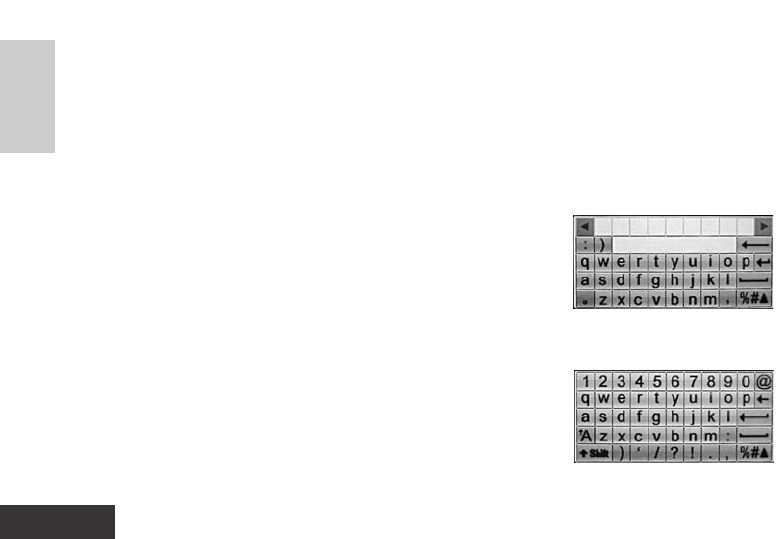
ENGLISH
Entry Methods
32 Entry Methods
Handwriting
As the primary text entry method for your phone, Handwriting pad is available in any function where
text entry is necessary. It employs Motorola's Wisdom Pen - an advanced handwriting recognition
technology - to make it simple and easy for you to enter Chinese characters, English words, and
symbols. To activate the Handwriting pad, tap the Entry Method button in the text entry window and
select Handwriting. A Handwriting pad will be shown at the bottom of screen like that in the figure.
Before entering text with the Handwriting pad, you should determine which type of text you will enter:
Chinese, abc, or 123, by tapping the appropriate symbol. Now you may write in the Writing Pane.
When you finish writing, pause to wait for your phone to select and
put recognized characters into the entry screen. If your phone puts
an undesired character, you may tap another character in the
Choice Section to replace it. The character will be inserted at the
cursor location. The entry method is designed with a predictive func-
tion. In the Prediction Section, a character may be highlighted to
indicate that it can be a second character to combine with the first
word into a common phrase. Tap the character to enter it at the cur-
sor location.
Pinyin Board
If you select Pinyin Keyboard, a simulated Pinyin keyboard
appears on the screen to allow you enter Chinese characters by
using pinyin, as shown in figure 1. To enter a Chinese character,
Figure 2
Figure 1
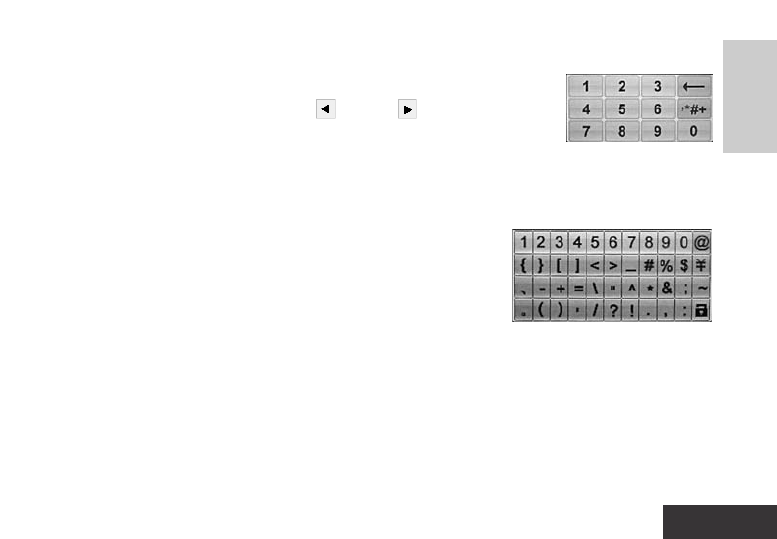
ENGLISH
33
Entry Methods
Entry Methods
tap keyboard letters with your stylus pen, in a sequence to spell the corresponding pinyin. The
letters you enter are displayed in the Pinyin Section and corresponding
Chinese characters are shown in the Choice Section. To see additional
characters for choice, tap the Previous or Next button. Once you
find the right character, tap it to enter it at the flash cursor location on the
entry field.
English Board
If you select English Keyboard, a simulated English key-
board appears, as shown in the right Figure 2. You may
tap the key of a letter or number to enter the letter or num-
ber at the cursor location.
Numeric Pad
The method is mainly used for code entry. You may enter digitals and symbols (typi-
cally used in codes, such as symbol 'P' and '*') quickly and easily.
Select Numeric Pad to show a simulated Numeric Pad (see Figure 1). Tap a Numeric
key to enter a digit at the cursor location.
Figure 2
Figure 1
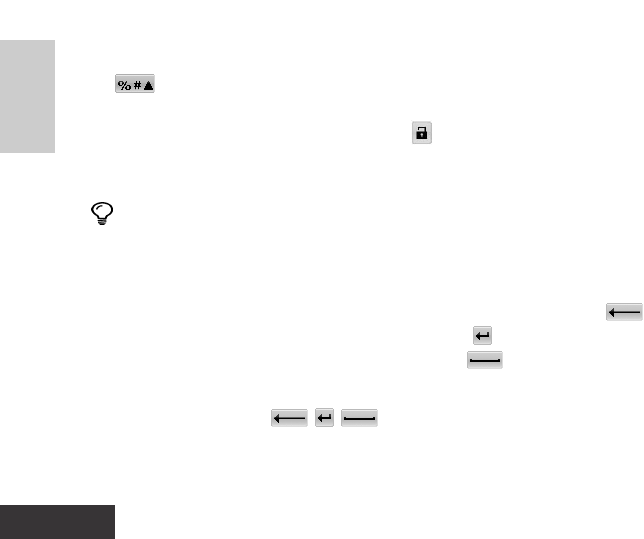
ENGLISH
Entry Methods
34 Entry Methods
Functional Buttons
An icon may be seen in any of the above pads. The icon indicates the Symbol
Pad, as shown in Figure 2. To enter a symbol to the cursor location, tap the key of the
symbol you want on the pad. By tapping ,you may lock or hide the Symbol Pad.
Note:In the text input mode, you should tap the numeric symbol icon on the writepad
to enter the symbol input panel.
Tips The flash cursor indicates the current entry location in the text entry field.
As you tap on the field with your stylus pen, the cursor moves to the
tapped point. Such a feature may be used to insert a new character
between two existing characters or to delete an existing character.
To delete the character just preceding the cursor location, tap . When you are
entering characters, you may tap the Enter Key to move the cursor to the next line.
To insert a blank between two characters, tap . A blank is entered following the
cursor.
Note:Display of icons may vary in different entry pads. Please refer to
Note:your phone for details.
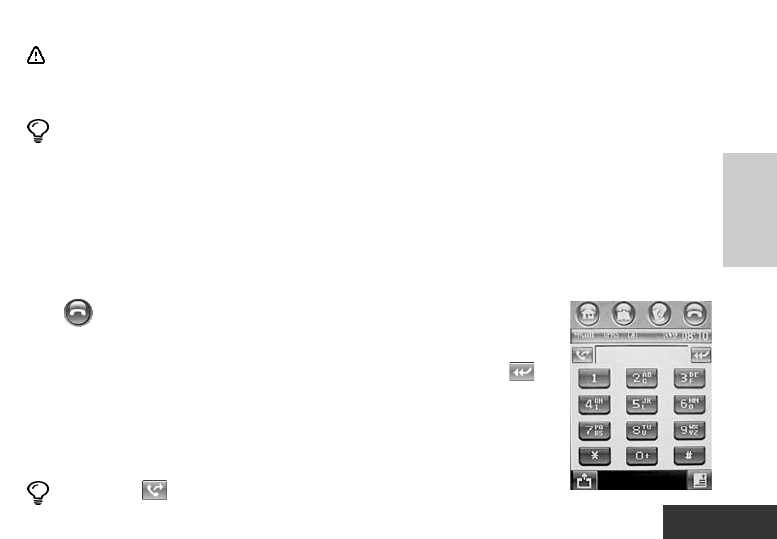
ENGLISH
35
Phone Function
Phone Function
Note
The phone function is available only when you have turned on the Phone
Function (i.e. in the Phone Mode) and your phone is within network coverage.
Sending a Phone Call
Tips
You have many choices to dial a number in addition to those methods you normally use. You
can: dial a number from the Address Book; dial a number stored in your SIM card; pick up and
dial a number from a received message; dial a number from a missed call; and dial a number
from a received call. You may also use the Speed Dialing function to dial specific numbers.
Your phone is equipped with a number of functions such as Call Transfer, Call Divert, and
Conference Call to improve your communication efficiency. It also records the telephone num-
bers of your recently received calls. In control of these functions, you will find that your phone
is powerful in making your work and life more convenient. Please refer to the relevant sections
in the manual for details on how to use these functions.
1.
Tap in the Main Menu Screen to bring up a new screen, as shown in the Figure.
2.
To send a call, tap the digit keys. The number you entered displays in the Number
field, where the last digit before the cursor may be deleted by tapping key.
You may also tap and hold the Number field to pop up the Edit menu;
3.Tap Send to dial the number;
4.When you want to finish the call, tap End or rotate your phone's
cover closed to end it;
Tips
Tap to select a number you want to dial from a list of calls record.
Chapter 3 Phone Function
Send
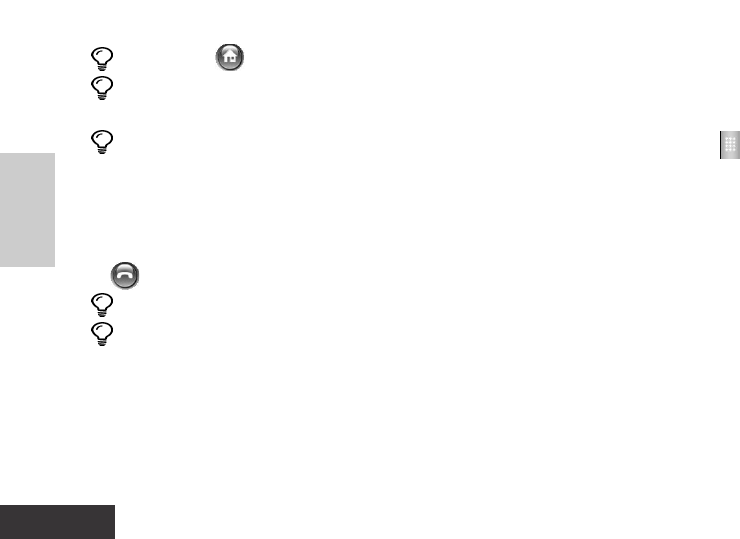
ENGLISH
Phone Function
36 Phone Function
Tips Tap or a shortcut softkey to return to the Main Screen
Tips
You may tap the Redial key to show the last number you dialed during the current power-on of your phone,
provided that no number appears in the Number Field. To dial the telephone number, tap the Send key.
Tips
When you have established a connection to a number successfully, you may tap the Keypad button on the
left side of the screen to open the dialpad screen, on which you may dial an extension number or enter digits.
Dialing an Emergency Number
Your network operator specifies one or more emergency phone numbers (such as 112) that you may dial
under any circumstances. Wherever a network is available, you may dial the emergency number by tapping
the symbol to show up the Dialpad Screen, even when no SIM card is inserted in your phone.
Tips Network support is required to use the function.
Tips
Emergency numbers vary in different countries. Emergency number(s) in your phone
may be unavailable in certain area. Sometimes you cannot make an emergency call
due to network coverage, surrounding environments, and other interferences.
Receiving a Phone Call
When you receive a call, your phone may ring, vibrate, or keep silence, with a screen display as shown
in Figure 1. Tap Answer to answer the call. To finish the call, tap End or close your phone's cover.
Tap Ignore to hang up. Tap Busy to hang up and transmit a busy tone to the caller via the network.
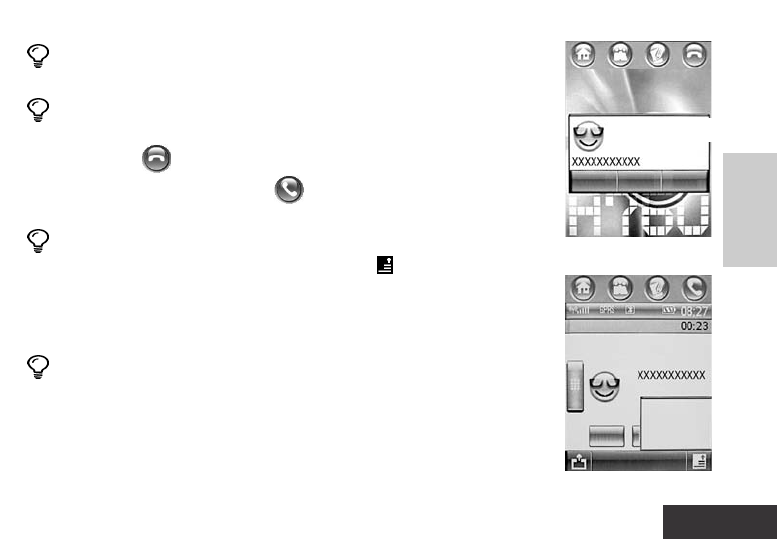
ENGLISH
37
Phone Function
Phone Function
Tips
If "Flip Answer" is enabled (refer to description on "Flip Answer"), you may
receive a phone call by simply opening the cover.
Tips
When you are using the Phone Function, icons for phone functions visible on
the buttons bar on top of the screen may vary depending on the calling status.
The iconindicates that your have not dialed a number or you
are not talking. The icon indicates that your phone is in dialing
or talking.
Tips
Both the display and the function of the functions bar may vary depend-
ing on the calling status. Tap the menu key in the function bar to pop
up a list of functions, as shown in Figure 2. You may tap any other func-
tion displayed on the list. These functions are corresponding to the cur-
rent status. Options in the list also vary depending on the calling status.
Tips
You may press the Receive button on the headset to receive a phone call, provided
that you have inserted a headset equipped with a Receive button into the phone.
Dialing an International Call
To add the international dialing prefix "+", and then tap and hold "0" for several
seconds. Icon "+" displays in the Number Field. Alternatively, you may tap the Menu
Figure 1
Figure 2
Incoming Call...
Busy Ignore Answer
Connected
Hold
New Call
Transfer
My Number
End
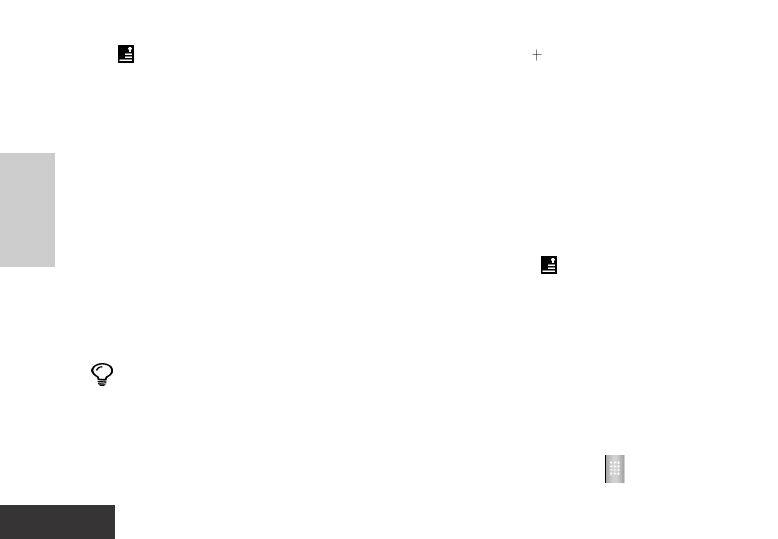
ENGLISH
Phone Function
38 Phone Function
Key and then tap Insert to select Insert International Dialing Prefix . Enter the international access code
for the country to which you are dialing. Enter the phone number. Tap Send to make your international call.
Directly Dialing Extension or Voicemail
The phone allows you to dial an extension or voicemail directly. You may insert a Pause symbol in
digits of a telephone number. When you dial the number, your phone would not dial the digits fol-
lowing the Pause symbol until it receives an answer from the called party. When an answer is
received, the phone proceeds with the extension number. To dial a number with a Pause symbol,
1. Enter the telephone number as normal;
2.
When you need to insert a Pause symbol, tap the menu key and select Insert\Insert Pause
from the popup menu. A symbol 'P' (the Pause symbol) displays in the Number Field.
3. Enter the extension number.
4. When all the digits have been entered, tap Send.
Tips
You may follow the above steps to insert a Wait symbol "W". When your phone dials the digits pre-
ceding the symbol "W", it waits for connecting before it proceeds with digits following the symbol.
Dialing an Extension Number
To dial an extension number during a call, tap the Keypad button to pop up the dial-
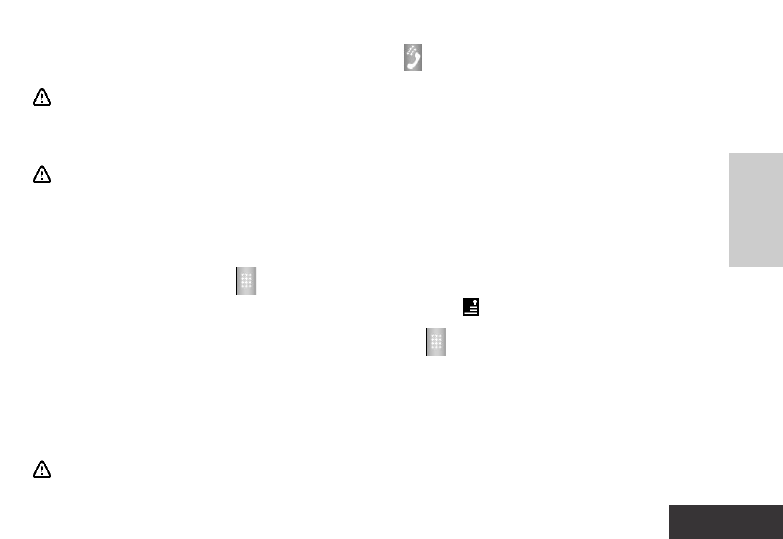
ENGLISH
39
Phone Function
Phone Function
pad. To return to the on-call status screen, Tap .
Note
To dial an extension number, never tap Send at the bottom of the Dial Screen.
In-Call Functions
Note Function availability varies depending on your network operator and your
subscription for the function.
When you are in a call:
Tap Hold to put the current call on hold. Tap Mute to close the speaker and tap Mute again to
resume. Tap Keypad button to switch the screen to the Dialpad screen, on which you may
dial another number or an extension number. Tap Menu key to show a menu containing:
New Call: The option functions just as the Keypad button ; that is, you may dial another number.
Call Transfer: Enter a number via the Dialpad screen. Tap Send again to transfer a
call to the number you entered. Refer to "Transferring a Call" for details.
My Tel. Number: Show your phone number.
Holding a Call and Dialing another Number
Note: Function availability varies depending on your network operator and your
subscription for the function.
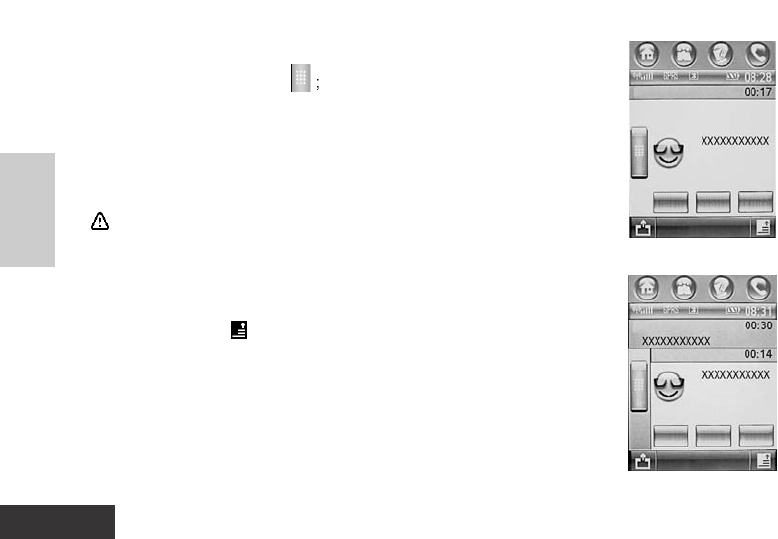
ENGLISH
Phone Function
40 Phone Function
When you are in a call, you see a screen as shown in Figure 1:
1. Tap the Keypad button
2. Enter a new phone number and tap Send to dial it. If you dial
successfully, the first call is brought into "On Holding" and you
may talk with a third party. The screen is as Figure 2.
Switching between two Calls
Note: Function availability varies depending on your network
operator and your subscription for the function.
When a first call is on hold and a second call is in progress, as
shown in Figure 2:
1. Tap Menu key and Switch to put the current active call on
hold and bring the current on-hold one to be active. You can
talk to any of both parties in turn. However, only one of both
parties can hear your voice at a time; the party on hold can
hear nothing from you;
2. Tap End to end the current active call.
Figure 1
Figure 2
Connected
Hold
End
Mute Spkr
Connected
Link Mute Spkr
End
On Hold
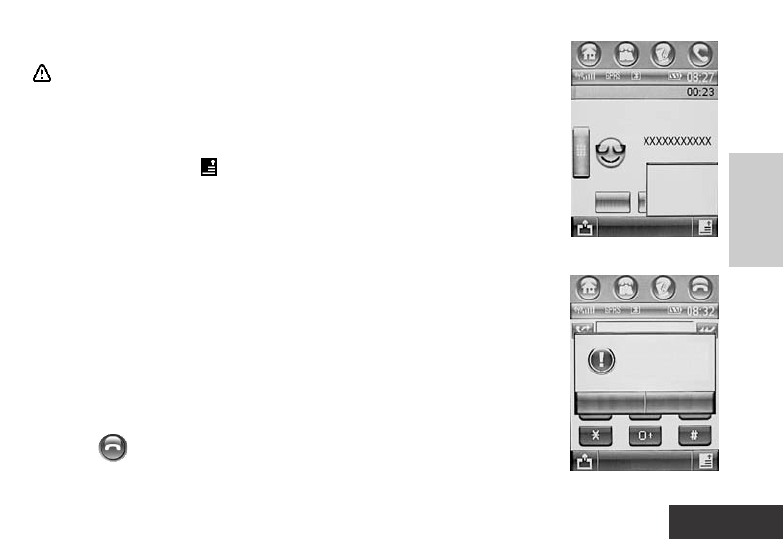
ENGLISH
41
Phone Function
Phone Function
Transferring a Call
Note:
Function availability varies depending on your network operator
and your subscription for the function. The function allows you to
transfer the current active call to a fixed telephone or a handset.
When you are in a call:
1. Tap the menu key as shown in Figure 1. Tap Transfer in the
popup menu to show the Dialpad screen;
2. Enter a number and tap Send to dial it. The call will be trans-
ferred to the number you entered.
Turbo Dial
The Turbo dial function allows you to store up to 9 frequently used numbers
on your phone. You may dial a number anytime, by tapping and holding a
digit key, without entering the number one digit after another. However, you
must store these numbers in the Turbo Dial List beforehand.
The function is very convenient for you to dial frequently used numbers.
Note: The digit "0" is not used for storing Turbo Dial numbers.
1. Press in the Main Screen to show the Dialpad screen;
2. Press and hold a digit key until your phone dials the number
stored in the key (a location).
Figure 1
Figure 2
Connected
Hold
New Call
Transfer
My Number
End
Redial
Turbo Dialing is
not setup. Would
you like to Set it up
now?
Cancel OK
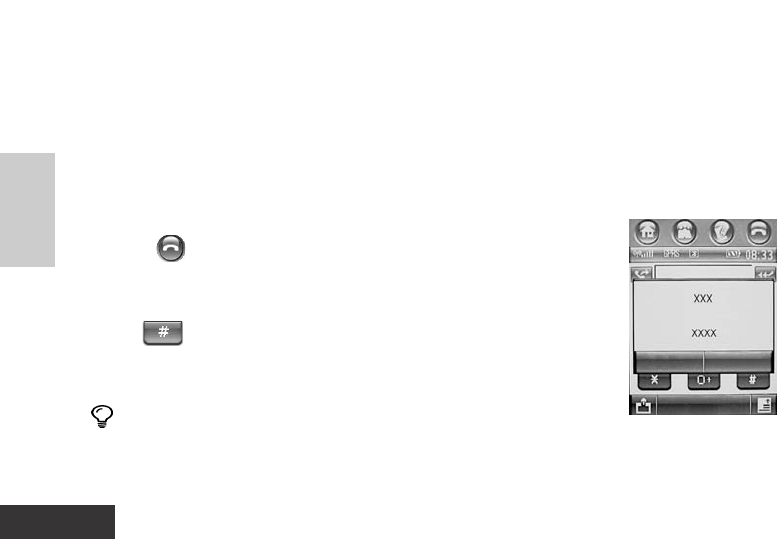
ENGLISH
Phone Function
42 Phone Function
If no number has been stored in the digit key, your phone displays a screen asking you whether
to set up Turbo Dial, as shown in Figure 2. Tap OK to call up the setup program for Turbo Dial.
3. Enter the Turbo dialing number you need for the digit key. Tap Ok to save your setting.
Dialing a Number Stored in SIM Card
You may directly dial numbers stored in your SIM card (Total numbers that may be saved in the SIM
card depends on the SIM card). The function enables you to dial a specific number without entering it
one digit after another.
1. Press in the Main Screen to show the Dialpad screen;
2. Tap the Digit keys to enter the serial number of the location
used to store the number in the SIM card;
3. Tap to show the Confirm screen for SIM card dialing as
shown in the right figure;
4. Tap Send to dial the number.
Tips:
If you have entered a blank location No. (On your SIM
card) where no number has been stored, your phone displays "The SIM entry
is empty".
Multiparty Conversation (Making a Conference Call)
Redial
Cancel Make Call
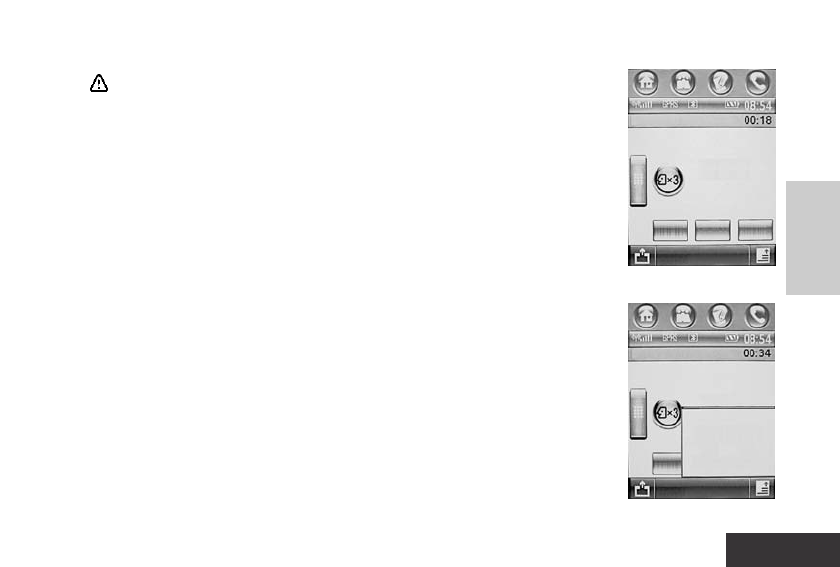
43
Phone Function
Phone Function
Note:
Function availability varies depending on your network oper-
ator and your subscription for the function. The function
allows you to link the current active call and those calls on
holding. You may make a multiparty conversation.
During the conversation, voice of any conference party will be heard by
all other parties. You may also add additional parties to your conference
or split any conference member as appropriately.
Initiating a Multiparty Conversation (Conference Call)
To initiate a multiparty conversation, operate as follows:
1. Dial the first party of the multiparty conversation;
2.
Put the first call on hold and dial another phone number (another party of the multiparty
conversation to be made). Refer to Holding a Call and Dialing another Number for relative infor-
mation;
3.
Tap Link as shown in Figure 1 to establish a multiparty conversation among the current active
party and the party on hold. To add a new member to the multiparty conversation, you may
perform it by making a new call. When you receive a new call, you may answer the incoming
(or waiting) call. However, once the new call is connected, the original multiparty conversa-
tion is put on hold. Tap Link to establish a new multiparty conversation between the new call-
ing party, which is currently active, and the multiparty conversation on hold.
Splitting a Multiparty Conversation (Conference Call) Member
Figure 1
Figure 2
End
End
New Call
End All Calls
Disconnect
My Number
Connected
Connected
Conference
Call
Hold Mute
Spkr
Conference
Call
Hold
ENGLISH
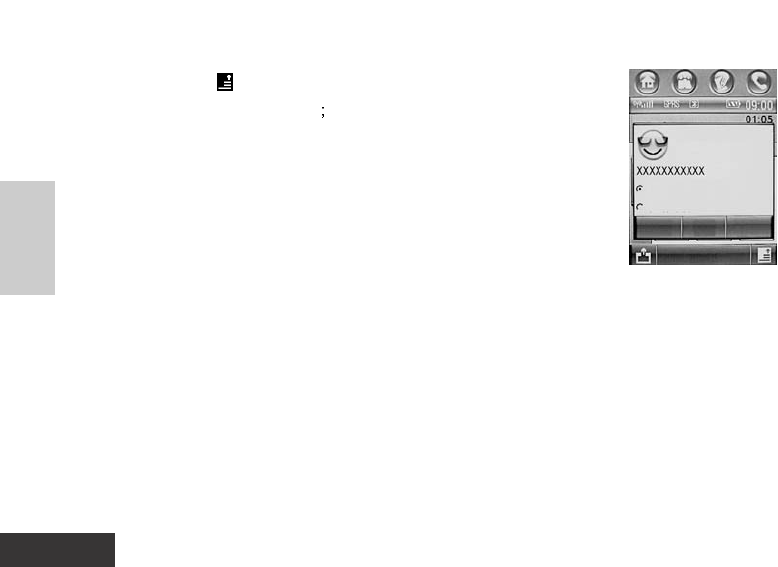
ENGLISH
Phone Function
44 Phone Function
1. Tap Menu Key in the screen as shown in Figure 2 on the multiparty
conversation. Tap Disconnect
2. Select a member (telephone number or name), whom you wish to
split from the multiparty conversation, from the checkbox;
3. Tap Split to split the selected member; and then return to the in-call status;
4.
You may privately talk to the party split from the multiparty conversation
while keeping on hold the multiparty conversation among other parties.
And then the private call may be terminated to re-establish a multiparty
conversation with the original conference temporarily on hold.
Alternatively, you may choose not to terminate the completed private call.
If you do so, tap Link Calls to continue the multiparty conversation.
Handling a Third Incoming Call
Say your phone has an on-holding call and an active call (that is, it has two calls). If you receive
a third call, the screen will be displayed as shown in the Figure. Now, you must terminate either
of both active parties before you may receive calls from the third party:
1. If you select Drop Active Call and tap Answer, you may answer the third incoming call by terminating the
currently active call;
2. If you select Drop hold call and tap Answer, you may answer the third incoming call by terminating the
call previously on hold and putting the currently active call on hold.
3. If you tap Busy, the third incoming call will be terminated and a busy tone will be sent out. Alternatively,
you may temporarily left the third incoming call unhandled and continue your existing calls. In such a
case, the caller of the third incoming call will hear "The call waiting function is available for the other
On Hold
Incoming Call
Drop active call
Drop hold call
End
Busy Ignore Answer
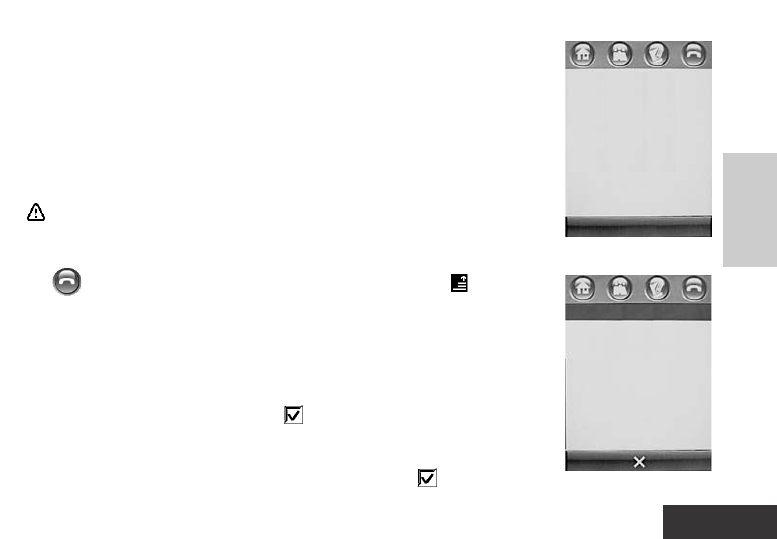
ENGLISH
45
Phone Function
Phone Function
party of the calling" or something alike, provided that you have set the call
waiting status as "On". Actually, when you do this, you just behave as not
answering the third incoming call;
4. When finished the current calling, you may return to the Step 1 to end either of
the existing calls and answer to a third incoming call.
Transferring a Call
Note: Network support is necessary for the function.
The function allows you to transfer the voice, fax, or data calls you receive to
another number. You may set what, where, and when the calls may be transferred.
Tap in the Main Screen to enter into the Dialpad. Tap and select
Setup\Call Divert to open the Transfer Setup Screen, as shown in Figure 1.
1. Select the type of calls to be transferred by tapping Voice Calls, Fax
Calls, and Data Calls;
2. The phone will show a list of options for call Divert if you select Voice
Calls. Select an option. Tap the checkbox preceding Activate Divert at
the center of the screen. An icon appears. Enter the target number
for call Divert. Tap Done.
3. If you select Data Calls or Fax Calls, tap the checkbox preceding the
Activate Divert at the center of the screen. An icon appears. Enter
the target number for call Divert. Tap Done.
Figure 1
Figure 2
Call Divert
Voice Calls
Fax Calls
Data Calls
Cancel All Diverts
Done
Answered Calls (0)
Missed Calls (5)
Dialed Calls (9)
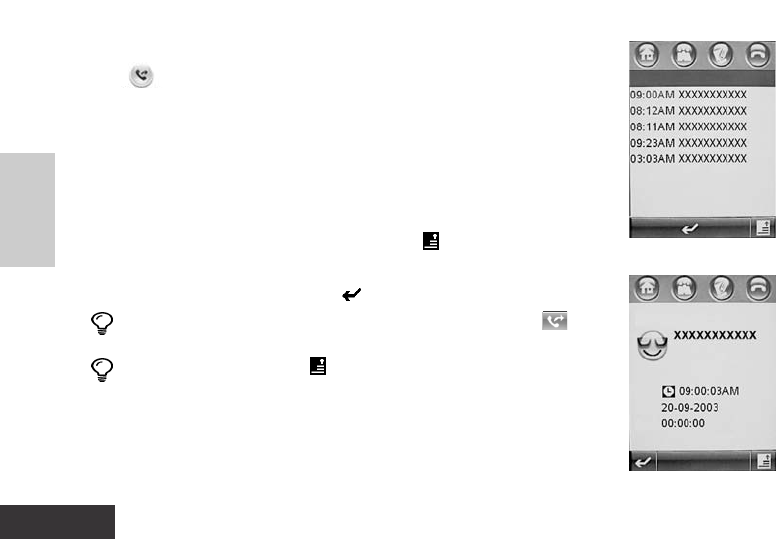
ENGLISH
Phone Function
46 Phone Function
Calls Record
Tap in the Main Screen to show the Calls Record screen, as
shown in Figure 2;
1.
To enter into the relevant function screen, you may tap Answered Calls, Missed Calls
Calls, or Dialed Calls. Take Missed Calls for example, as shown in Figure 1;
2. The phone numbers (or names in your Address Book corresponding
to the numbers) are listed by time and date; you may navigate
through the numbers to find a wished one using the scroll bar. To
delete all these numbers, tap the menu key and Delete All;
3. When you find the number you want, tap it to show its details (see Figure 2);
4. Tap Call to dial the number; Tap to return to the previous screen.
Tips:
You may show the list of Calls Record by tapping in the
Dialpad screen.
Tips:
Tap the menu key in the screen as shown in Figure 2; and
then tap Store (The option is unavailable if the item has been
stored in the Address Book) in the popup menu to store the
number to the Address Book. To delete this Calls Record entry,
tap Delete. If you tap Sending a SMS or Send MMS, you enter
into a screen to compile a new message, with the number in the
Calls Record entry as the recipient.
Figure 1
Figure 2
Missed Calls
Missed Calls
Start:
Date:
Duration:
Dial
Recent Call
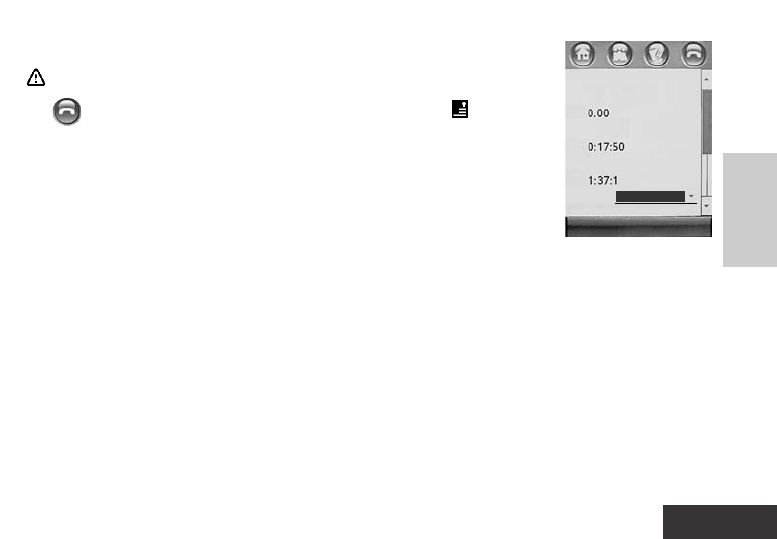
ENGLISH
47
Phone Function
Phone Function
Call Meters
Note: Network support is necessary for the function.
Tap on the Main Screen to enter Dialpad Screen. Tap and select
Setup to enter calls Setup Screen. Tap Call Meters to enter Call Meters
Screen, as shown in the Figure.
1. The "Total Call Cost" shows the Clear Call Cost for the last call
and the total cost for all the calls.
2. The "Total Call Time" shows the Clear Call Time for the last call
and the total duration for all the calls.
3. The "Call Lifetime" shows the total duration for all the calls.
4. Display Setup
In the pull-down box of the Display field, you can select the following displays: Off,
Timer, Cost, Total Cost, and Credit.
5. Audible Timer
You may set a time length. Your phone in call will beep according to your setup.
In the pull-down box of the Audible Timer field, you can select different time length or Off.
Call Meters
Total Call Cost:
Total Call Time:
Call Lifetime:
Display: Off
Audible Timer:
OK

ENGLISH
Phone Function
48 Phone Function
6. Call Cost Setup
In the Call Cost screen, tap Call Cost Setup. Input the PIN2 code and
confirm it to enter into the Setup screen. Select whether to specify a
Limit; Tap the direct line following the Limit and enter a value for the
charge limit in the entry area; Tap buttons below the Charge Type field to
select Unit or Currency, which determines that the cost register displays a
call time (in a time unit) or a charge (in a Currency).
7. Available Credit
Tap it to view the Available Credit
My Number
Use the function to view your phone number. You have to preset your
phone number within the phone. To save your phone number:
1. Tap on Dialpad Screen. Tap Setup from the menu to bring
your phone into the Setup screen;
2. Tap My Number on the Setup Screen to bring your phone to a screen
to enter your phone number, as shown in figure 1. In the screen, you
Figure 1
Figure 2
My SIM Number
Line 1
Name:
Number: XXX
Line 2
Name:
Number:
Done
Current Network
Available Networks
Preferred Networks
Known Networks
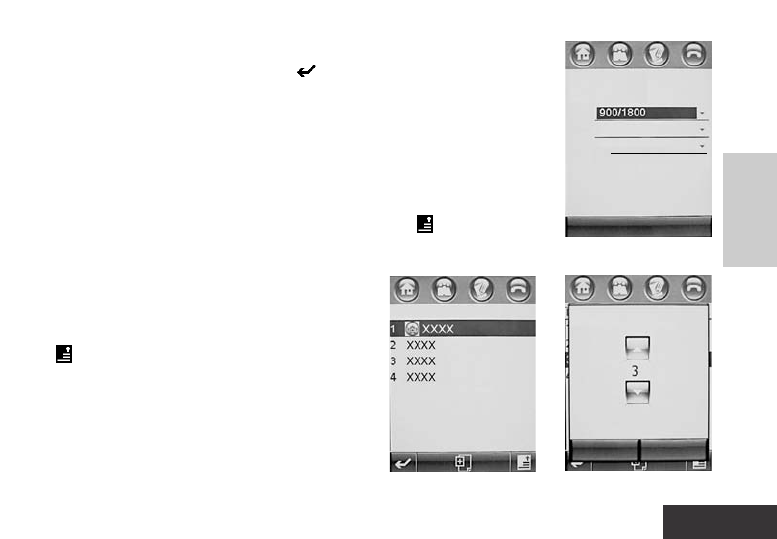
ENGLISH
49
Phone Function
Phone Function
may enter the name and number of the relevant line, and then tap
Done to store the setup. If you tap , you make no modification and
the phone returns to the Setup Screen.
Network Setup
Before you can make calls or send short messages, your phone has to
be registered in a wireless communication network currently available.
To view or configure the network, you should tap in the Dialpad
screen and then select Setup from the menu. Tap Network Setup in the
setup screen to open a new screen as shown in
Figure 2.
Network Search Setup
Tap in the screen as shown in Figure 2 on
the above page and select Search Setup from
the menu. The Network Search Setup screen
appears as in Figure 1.
In the Band field, you may choose one from the
three bands of 900/1800, 900, and 1800.
Figure 1
Figure 3
Figure 2
Search Setup
Search Network By:
Band:
Type: Automatic
Speed: Medium
Done
Preferred Networks Network Priority
Cancel OK
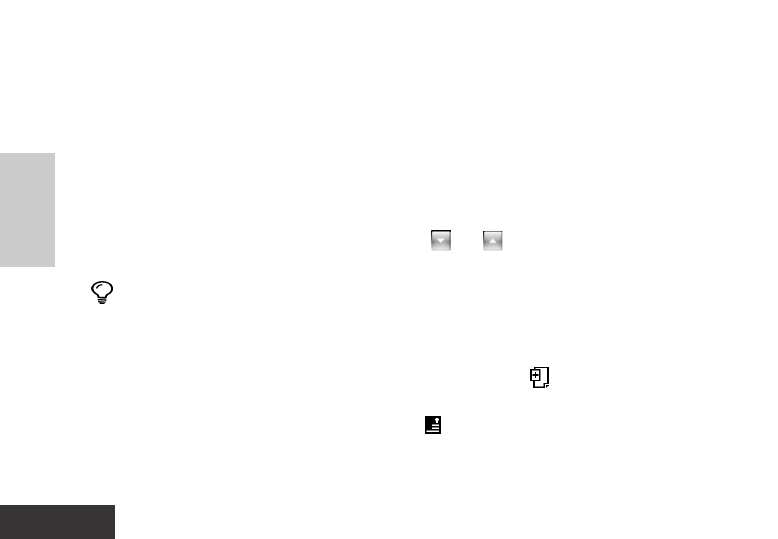
ENGLISH
Phone Function
50 Phone Function
In the Type field, you may determine how the phone will be registered to the network:
Manual or Automatic.
The Speed field allows you choose one from Slow, Medium, Fast, or Continuous.
Preferred Networks
Tap Preferred Network in the screen as shown in Figure 2 of the above page, and then the list
of your preferred networks will be shown in the screen as shown in figure 2. Select any one
non-preferred network. Tap and hold the network name to bring a menu list. Tap reorder to
show the dialog box as shown in figure 3. Tap and to change the priority of the network.
Tap OK. If you tap Cancel, you make no change and your phone returns to the previous screen.
Tips:
To use the
reorder
function, the preferred networks should include at least three items.
If you tap Delete on the menu, a dialog box prompts you to confirm the deleting.
Select Delete, the network is deleted from the list of preferred networks.
To add a new network to the preferred network list, tap to bring a dialog box, where
you may enter a Network ID on the direct line.
To delete all your preferred networks, tap in the Preferred Network List screen. Tap
Delete All to bring a dialog box prompting you to confirm deleting all such networks. If
you tap Delete, all preferred networks (excluding the first one) will be deleted.
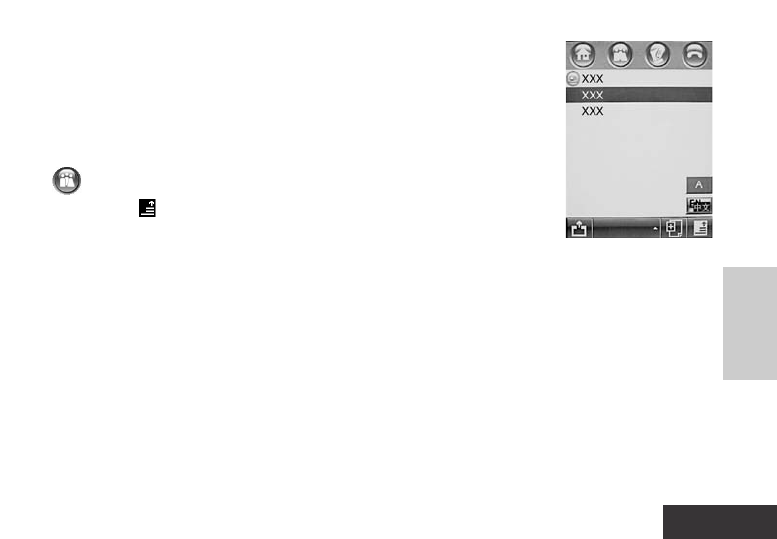
ENGLISH
51
Address Book
Address Book
Chapter 4 Address Book
The Address Book allows you to record various information, includ-
ing names, addresses, phone numbers, fax numbers, and e-mail
address, etc., of persons with whom you want to make contacts. You
may enter such information in your phone and use it to make calls,
send short messages (SMS), or send e-mails, and so on.
Showing Address Book List
Tap in the Main Screen to find the Address Book function as shown in
the Figure. Tap to select List View or Thumbnail View from the popup
menu. Then you may display your contacts list in different mode.
Classifying
Defining categories for your contact details helps you manage your Address Book information.
You can classify your contacts according to your need for communication. Your phone provides
the following basic categories:
All: Lists all contacts from all categories.
Unfiled: Lists contacts that have not been classified. This is the default category setting for all
new contacts.
SIM Card: Lists the contacts information saved in the SIM card.
Note: The categories are given in the manual for information purpose only. Refer to your phone
for details.
All
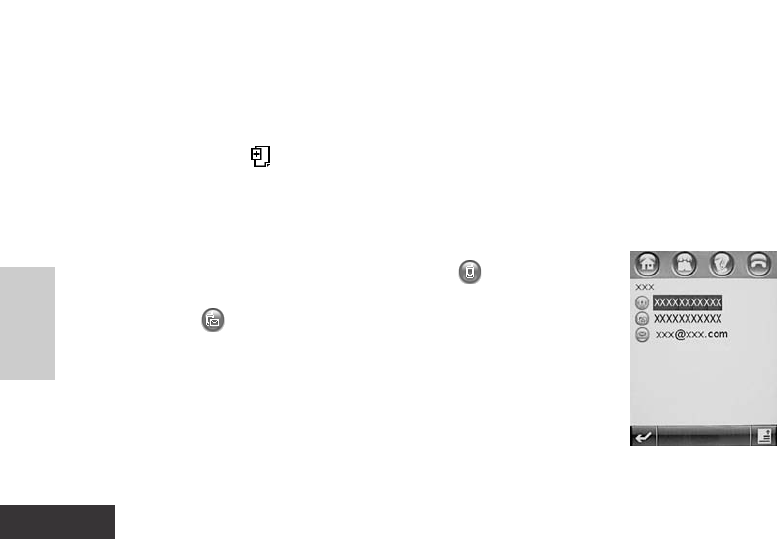
ENGLISH
Address Book
52 Address Book
Grouping
Grouping is defined as classifying some contacts related to each other in a same group (For
example, colleagues working on a project or members of a club). After grouping, you may send
a SMS, MMS, or e-mails to all members of the group at one time.
To create a group, tap from the Address Book list; select a New Group from the menu.
Viewing and Modifying Contact Details
1. When the contact list displays on the screen, you may tap a contact name to show
his/her details, as shown in the Figure.
2. By tapping the phone number following the icon on the details list,
you may dial the number. You may also tap the phone number follow-
ing the icon to send SMS or MMS. If you tap Email address, a
menu appears containing options for sending email and MMS. Tap an
option to perform a corresponding operation.
3. To view the more detailed information about the contact, tap
Edit. The phone shows a detailed list on the contact.
4. To modify the content of a field, tap the direct line following it.
5. When you have finished modifying, tap Done to store your modification and return
to the previous screen.
Edit
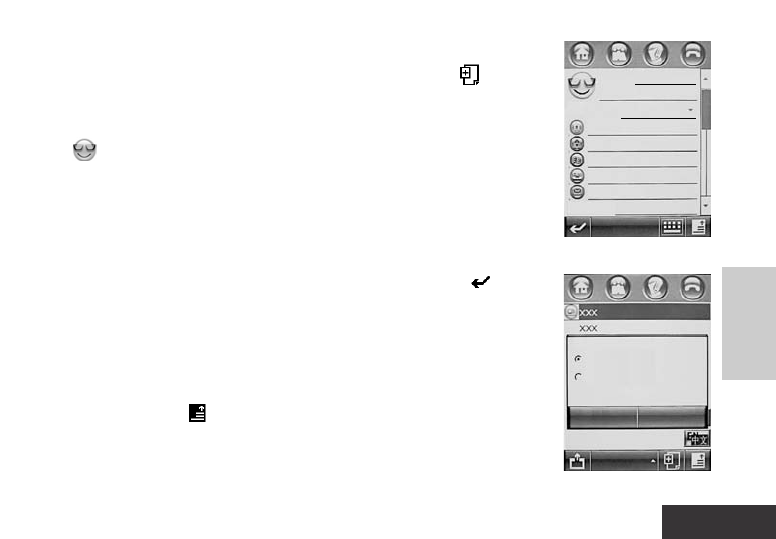
ENGLISH
53
Address Book
Address Book
Adding New Contacts
1. When your Address Book is shown as a list, you may tap and then
select New Contact from the popup menu. The Contacts List screen
appears, as shown in Figure 1.
2.
Tap symbol to specify a picture symbol for the contact. When your
phone receives a call from the contact, your screen displays the symbol.
3. Pull down the right scroll bar on the screen to view additional fields. To
enter data in these fields, tap the direct lines following them one by
one. A screen appears for your entry. You may enter the name, the
category, and etc.
4. Tap Done to store the data you entered. If you tap the icon , a dia-
log box appears asking you whether to exit the current screen. If you
tap OK, your phone returns to the contact list screen.
Copying Contact Data Information
You can copy the data information of the contacts between your phone
and the SIM card. Tap in the address book list screen. Select Copy to
SIM/Phone to enter the copy screen, as shown in Figure 2.
1. Select Phone to SIM or SIM to Phone and then tap OK. Your phone
displays a contact list, from which you may select;
Figure 1
Figure 2
Done
All
Cancel OK
Name:
Category:Unfiled
(Mobile)
(Home)
(Work)
(Fax)
(Email)
IMID:
Copy Number:
Phone to SIM Card
SIM Card to Phone
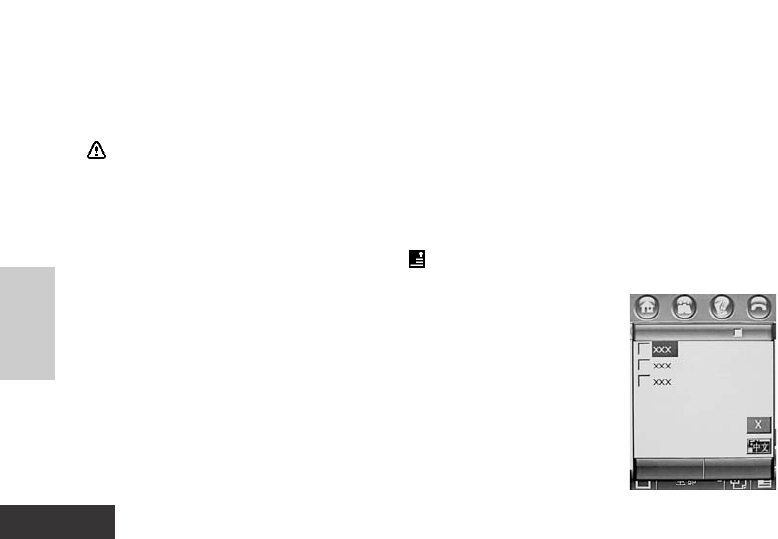
ENGLISH
Address Book
54 Address Book
2. Select numbers you want to copy.
3. If you select SIM to Phone, it is necessary to select the type of the number to be
copied. Tap OK.
4. When you finished copying, the screen returns to the Contacts List screen.
Note:
The amount of the contact entries that may be copied to the SIM card depends on
the capacity of the SIM card. Types of entries that may be copied to the SIM card
may vary depending on the function of the SIM card.
Deleting a Contact
1. On the Address Book List screen, tap and select Delete Contacts from the menu.
The phone will list all your contacts that may be deleted, as
shown in the Figure.
2. Check contacts you want to delete and tap Delete. A dialog box
appears prompting you to confirm the deleting. If you tap OK,
the phone deletes all the contacts you selected. To delete all
the contacts on the list, fist tap All to select them all; then tap
Delete and confirm your the deleting operation.
3. When you finished deleting, the phone will return to the
Address Book list screen.
Cancel Delete
Contacts: All
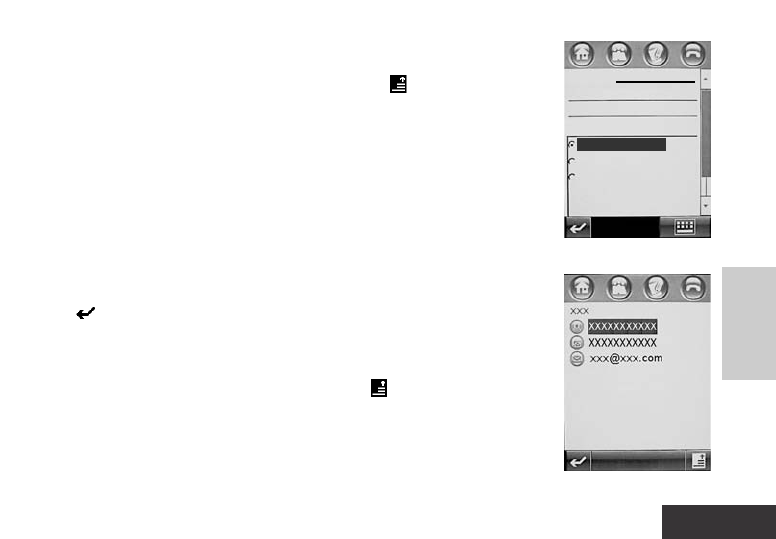
ENGLISH
55
Address Book
Address Book
Searching for a Contact
1. On the Address Book List Screen, tap and select Find
Contacts from the menu. Your phone opens a screen, as
shown in Figure 1;
2. Enter in the Find For field the information relative to the finding
option; Tap Contact's Name, Number, or Other in the finding
option and then tap Find.
3. Your phone will show you the searching result; however, if it
finds nothing, it will prompt you that no result has been found.
4. If you want to continue searching, tap Find New; otherwise,
tap to return to the list screen.
Viewing Owner's Information
On the Address Book List Screen, tap to select Owner's
Information from the menu. The Owner's Information screen dis-
plays as follows:
1. If the information of the owner is available in the phone,
detailed list of the owner will be shown as in Figure 2;
Figure 1
Figure 2
Find
Find For:
Find Options:
Contact's Name
Number(phone, Fax...)
Other
(Email, Address...)
Edit

ENGLISH
Address Book
56 Address Book
2. Tap Edit to bring up the Edit Screen, where you may edit the
owner's information;
3. If no owner's information is stored in the phone, the Owner's
Information Entry Screen appears. In such a case, you may
enter information by tapping direct lines following each field.
When your entry is completed, tap Done.
4. Tap , the phone will return to the Address Book list screen.
Sending Vcards
Your phone is designed with a share function that facilitates data exchanging. You
may send information of any contact as a Vcard to other phones or devices, via
Infrared or Bluetooth connections or in Email/MMS.
1. In the Address Book list screen, tap the name of the contact to be transmitted. The
phone will show a screen listing information on the contact.
2. Tap and select Share Via from the menu. The Share Via screen appears, on which you
may choose how to transfer the contact information, as shown in the right figure.
3. If the method you selected has been set up and is available, tap OK to send Vcards.
Cancel
Share Via:
OK
Bluetooth
IrDA
MMS
Email
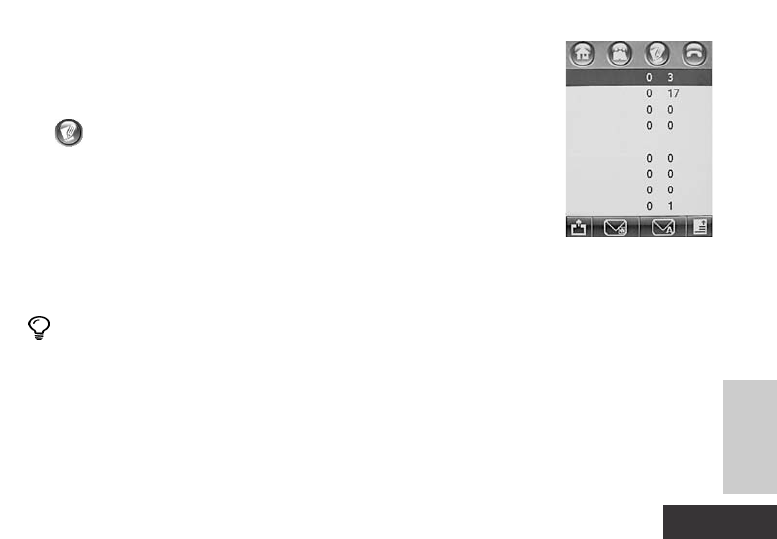
ENGLISH
57
Message Center
Message Center
Chapter 5 Message Center
Your phone is designed with an open window display, super-large
touch screen, and graphical interfaces to deliver convenience for
you to utilize message functions. You can send, receive, view,
and manage various messages simply and easily.
Tap in the Main Screen to enter the message center screen, as
shown in the Figure. The center allows you to process various mes-
sages. Each list item on the screen is called a folder. If you tap a folder
title, a different function screen opens for you to manage a specific type
of message. The first column of numeric value following each title indi-
cates the number of new or unprocessed messages. The second column
of numeric value is the number of existing messages contained in the folder. Each folder is
designed with different functions and operations. The functions of each folder are as follows:
Inbox: The Inbox saves SMS and MMS you have received.
Tips The Inbox function requires network support and is dependent on whether
you have subscribed for it.
SIM Card: Short messages stored in the SIM card, you may save such messages to
other folders as necessary.
WAP msg:WAP messages are stored here.
Voice Mail:
You may specify your phone to automatically transfer incoming calls to your voice mail serv-
ice number once you cannot answer them. In such cases, the callers may have the choice to
leave messages, which will be stored in the voice mail system of your service network. You
Inbox
SIM Card
WAP msg
Voice Mail
Info Service
Drafts
Outbox
Sent Items
Trash
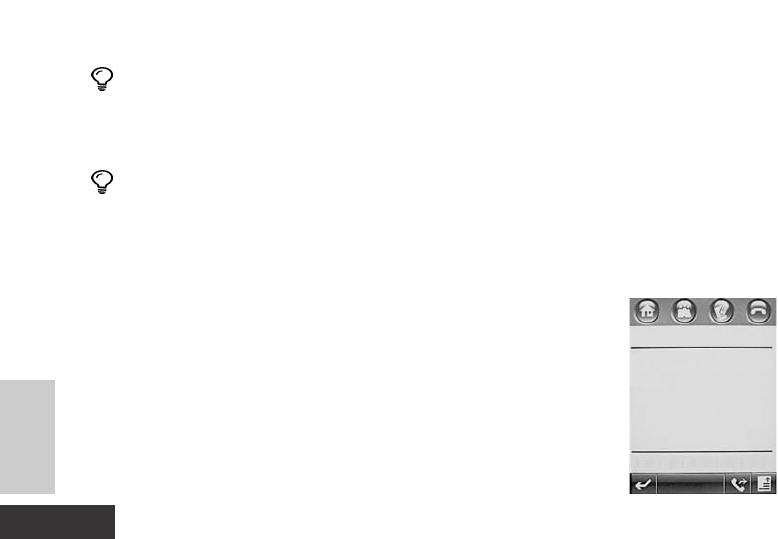
ENGLISH
Message Center
58 Message Center
may access and listen to voice mails contained in the system whenever possible.
Tips The voice mail function requires network support and is dependent on
whether you have subscribed for it.
Info Service (SMS): You may have various messages such as weather forecasts, time
tables, or stock market information sent to your phone.
Tips The info service function requires network support and is dependent on
whether you have subscribed for it.
Drafts: The folder temporarily saves messages you write but not completed.
Outbox: Short messages that have not been successfully sent are saved in the
folder for further modification or sending.
Sent Items: When a short message is successfully sent, it is
automatically saved in the Sent Items folder for
future reference.
Trash: The folder is designed to save messages you have
deleted. If you have not permanently deleted a mes-
sage, you may recover it.
Private Folder: Except for the above folders, you may also cre-
ate your own folder as required. The folder name
may be customized. Then messages may be cate-
gorized in different folders. Reply
From:XXX
The area where you are
does not support this
service.
Time: 02:43PM 17-09-2003
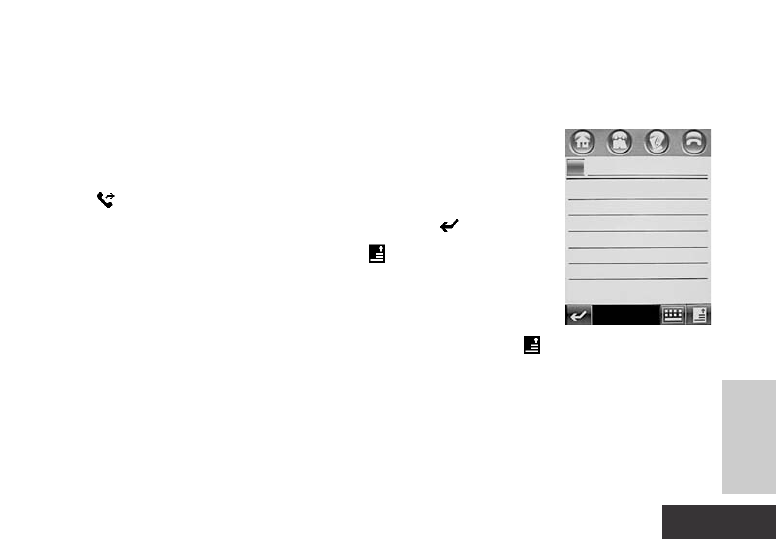
ENGLISH
59
Message Center
Message Center
Inbox
Reading Messages
Tap Inbox on the Message Center screen to list all messages contained in the inbox. To read a
message, tap it, as shown in the Figure. The screen will show you the
sender's name (if you have saved the number of the sender in the
phone) or his/her mobile number, the message content, and the sending
time. Tap to dial the number of the sender; Tap Reply to open an edit
screen, where you can edit your message in reply; Tap to return to
the previous screen without any changes; Tap , a menu pops up for
you to delete the message or save the address.
Forwarding a Message
When you receive a message, you may forward it to other persons. Tap on the message-reading
screen and then select Forward from the menu to open a screen, as shown in the Figure. Tap To: to
select contacts from your Address Book. Alternatively, you may tap the Number Entry field following
the To: to directly enter the phone number of the recipient. Tap Send to forward the message.
Replying a Message
When you receive a message, you may reply it with a MMS or a SMS.
Send
The area where you are
does not support this
service.
To:
texts: 13/1
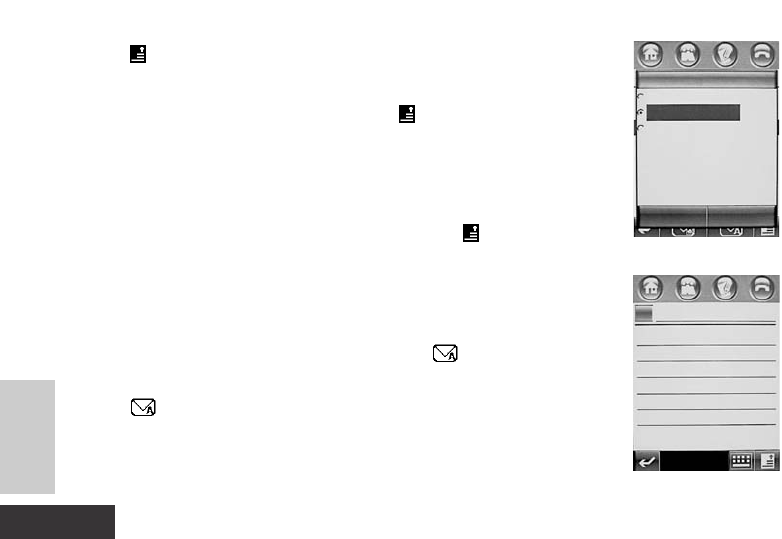
ENGLISH
Message Center
60 Message Center
Press on the message-reading screen and select Reply by a MMS to open a
MMS Editor screen. When you complete your editing, you may send the message.
If you tap Reply, an editor screen for short messages appears. When you complete
editing a short message, you may send it. Tap and select Reply with Content
from the menu. A message editor screen appears, on which you can see the mes-
sage to which you are to reply at the bottom of screen and the sender's information.
Enter your reply message at the cursor and tap Send to send the message.
Viewing Messages
On the Inbox, Outbox, or Trash Screen, you may tap and select View by
from the menu. There are three modes available: Name, Subject and Time.
Choose one item from the menu as shown in Figure 1 on the next page. After
confirming, the screen will show messages as specified by your selection.
Writing a Short Message
You may write a short message by tapping the symbol at the bottom
of the Message Center Screen.
1. Tap . Your phone displays the Message-Editor Screen, as shown in Figure 2.
2. Tap the Number Entry Field following To: to enter the number to which
the message is to be sent. Alternatively, you may tap To: to select one
or more recipients from your Address Book.
Figure 1
Figure 2
Send
To:
texts:
Cancel OK
View by
Name
Subject
Time
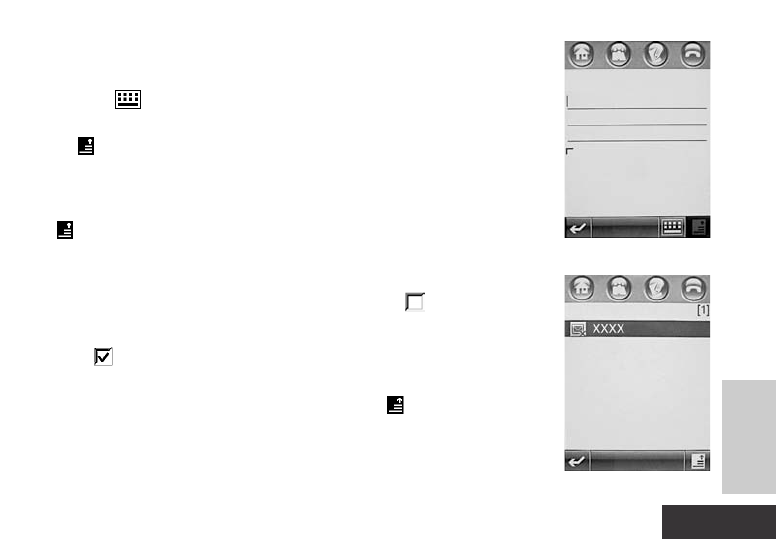
ENGLISH
61
Message Center
Message Center
3. You should enter the message content where the cursor is flashing. A
number of button symbols are also available below the editing pane:
The icon indicates Writing Pad. Tap it to select another entry
method from Pinyin, English, Numeric, and Handwriting.
Tap in the message editing screen and then you may select
Insert Quick Text to insert the preset phrase in your phone.
Signature Setup
Tap symbol in the Message Center Screen and select Signature
Editing as shown in figure 1 in the next page. Tap the direct line following
the Signature to enter your signature. If you want to attach your signa-
ture at the end of each message, you should tap the in front of Attach
Signature to All New Messages Automatically to check it (that is, it
becomes ). After that, tap Done.
Sending a Message
As you finish a short message, you should tap the symbol at the lower
part of the screen and select Sending Option to specify the condition (such
as Expire After) under which your message would be sent. After that, tap
Done to return to the edit screen.
On completing the above configuration, tap Send to send the message.
Figure 1
Figure 2
Signature Content
automatically include your
signature to new outgoing
SMS Messages
Done
Outbox
delete all

ENGLISH
Message Center
62 Message Center
Outbox
By tapping Outbox on the Message Center Screen, you can see the status of each message
that has not been sent out, as shown in Figure 2. The symbol preceding each message title
indicates the sending status of the message.
If you tap a message that failed to send, you can see its content and relevant information on its
recipient. When the message is opened, you may tap on it to modify and edit its content.
Tips You may also view the information in the Outbox in different methods.
Drafts
By tapping Drafts on the Message Center Screen, you can see all messages contained in the
Drafts folder;
You may tap any of these messages to view its content;
When the message is opened, you may enter or modify its content. When you complete your
editing, you may send the message immediately.
Trash
By tapping Trash on the Message Center Screen, you can see a list of messages con-
tained in the Trash. To read or edit a message, tap on it. If you tap Empty, all mes-
sages in the Trash will be removed and no recovery is available.
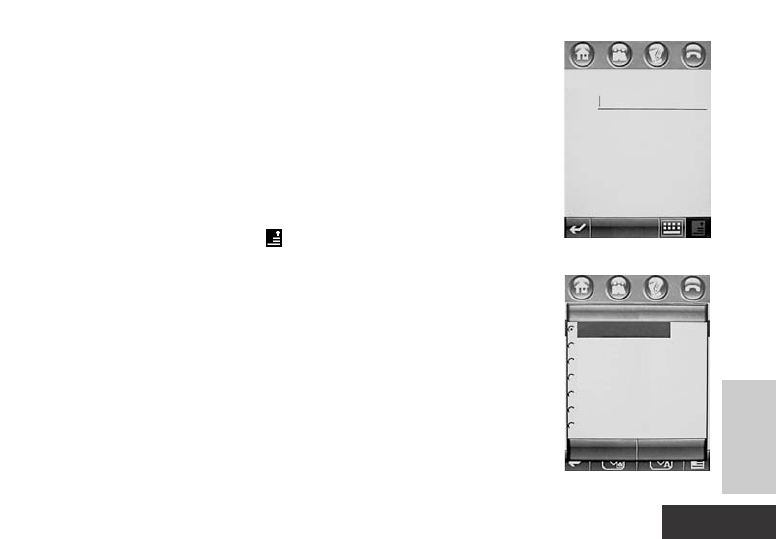
ENGLISH
63
Message Center
Message Center
SIM Card
By tapping SIM Card on the Message Center Screen, you may view all mes-
sages stored in the SIM card. You may tap any message to view its content.
Private Folder
Create a New Folder
You may create a private folder from the Message Center Screen to save
messages, in order to quicken your message viewing or retrieval. To cre-
ate a new folder, you should tap on the Message Center Screen and
select New Folder. A New Folder Screen appears as shown in figure 1.
1. Tap the direct line following Name and enter the name of the new folder;
2.
Tap Done and the new folder will be shown in the message center screen.
Moving a Message
You may move a message between different folders as necessary. For exam-
ple, you may move certain messages from the Inbox to a private folder or from
a private folder to the SIM card. Moving messages from the Inbox to the SIM
card is described as follows.
Tap Inbox on the Message Center Screen to open the message-viewing
screen. Tap and hold a message entry to pop up a menu, where you may
select Move to Folder to bring up the "Move to Folder" screen as shown in Figure
Figure 1
Figure 2
Folder Setup
Name:
Done
Move to folder:
SIM Card
WAP msg
Voice Mail
Drafts
Outbox
Sent Items
Trash
Cancel OK
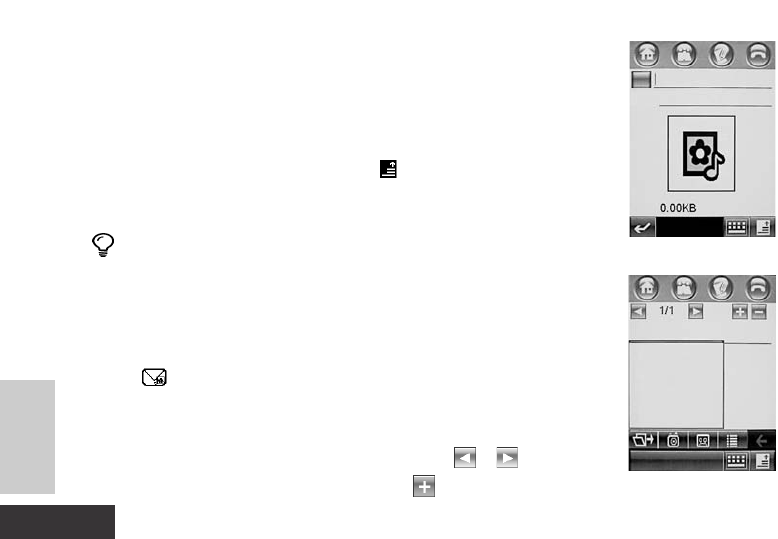
ENGLISH
Message Center
64 Message Center
2. Select SIM Card from the screen and tap OK. The messages you have
selected will be moved to the SIM card from the Inbox. When the moving is
completed, your phone returns to the message-viewing screen of the Inbox.
Deleting a Private Folder
You may delete private folders. To delete a private folder, tap it on the
Message Center Screen to enter it. Tap symbol and select Delete the
Folder from the popup menu. When a dialog box prompting you to con-
firm the deleting appears on the screen, tap OK to delete the folder.
Tips
You may delete a private folder provided it contains no message.
MMS
The MMS function allows you to insert picture, animation, or audio files
into your message, making your message more colorful and enjoyable.
Composing and Sending MMS
1. Tap symbol on the Message Center Screen to enter the MMS
function screen as shown in figure 1. Tap the animation at the center
of the screen, your phone switches to the MMS composing screen.
2. To open the previous or the next page, tap or ; to insert a
new page before the current one, tap ; to delete the current
Figure 1
Figure 2
To:
Subject:
Send
size:
Done
Insert image
Insert audio
Insert video
Insert quick text
Insert signature
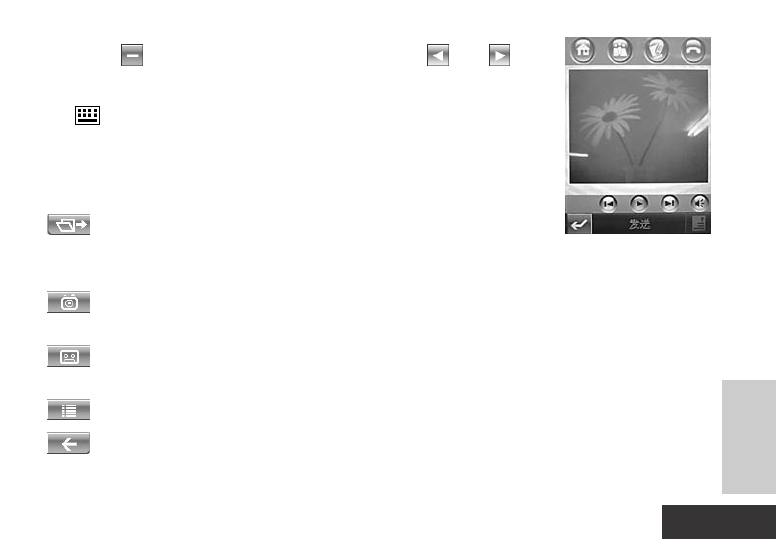
ENGLISH
65
Message Center
Message Center
page, tap . Numeric values between symbols and indi-
cate the page number of the current page and the total pages.
3. Tap to show a toolbar menu for input methods and media files.
Select a writing pad from the menu; the pad appears on the screen.
You may use the pad to enter text at the cursor as necessary. If you
select Media Files from the menu, a toolbar for medial files appears at
the screen bottom.
The symbol allows you to insert media files. Tap the symbol to
pop up a menu for media files. You may insert Image, Audio, Video, Quick Text
and/or Signature, as shown in Figure 2.
The symbol indicates the Camera function. Tap the symbol to enter Shoot
function and insert the picture into your message.
The symbol indicates the Recorder function. By tapping the symbol, you
may record a voice memo and insert it into your message.
You may setup the font, such as Font Size and Font Color.
The symbol is a Delete button. Tap it to delete the content preceding the
cursor or the content you selected.
Send
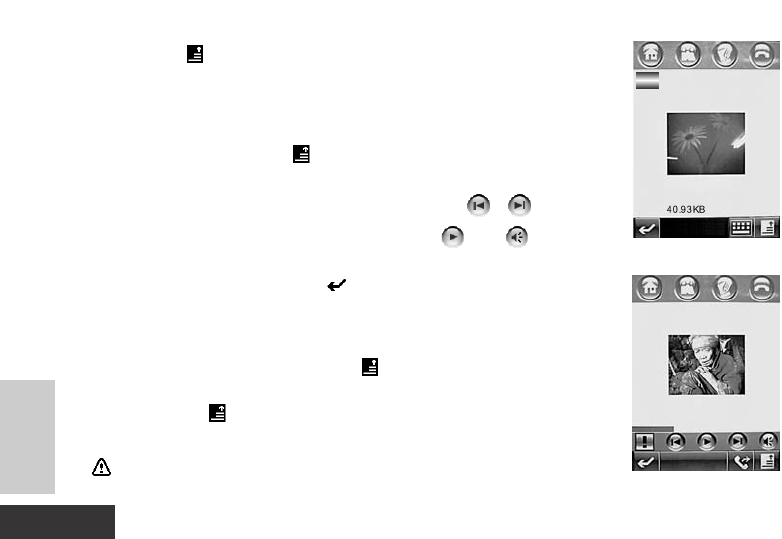
ENGLISH
Message Center
66 Message Center
4.
By tapping and selecting Page Color from the menu, you may setup the
page color for the MMS. You may also select Page Duration from the
menu to setup the display duration for the current page of the MMS.
5. When you complete your composing, you may preview your MMS that
you have compiled. Tap and select Preview to enter the Preview
screen, as shown in the right figure.
To go to the previous or the next page, you may tap or symbols; to
play the pages of your MMS continuously, press ; Tap to close the
volume of audio files.
6.
To complete the preview, tap to return the previous screen. Press
Done. The screen displays as in Figure 1 in the next page. Enter the
Subject and the recipient, the Send button is enabled. Tap Send to send
your MMS message. If you want to send a carbon copy or blind carbon
copy to other persons, you may tap and then tap Show CC/BCC from
the menu. Select Show CC or Show BCC to show the CC or BCC fields.
7. You may tap on the MMS screen. Select Save from the menu to
save the message to Drafts.
Note
You may configure the sending options for your MMS. Refer to
Sending a Message for details.
Figure 1
Figure 2
Send
size:
Reply
To:
Subject:

ENGLISH
67
Message Center
Message Center
Note
When composing a MMS, the inserted media files will have their displaying sizes automatical-
ly adjusted according to the page.
Downloading a MMS
Your phone will notify you when it receives a MMS. The screen shows with a new message! Tap
the message and the relative information on the MMS, such as the Sender, Subject, Time, and
Size, etc. will be shown. At the same time, you may download the new received MMS. If you
tap , the phone returns to the previous screen and download no MMS.
Viewing a MMS
Once you have downloaded a MMS, you may tap Inbox and select the new MMS information, as shown in figure 2.
1.The symbol is the relative information on the MMS. If you tap it, you can view the sender,
subject, time, and size.
2. Tap to play the MMS.
3. Tap Reply to reply a MMS message to the sender.
4. If you tap , you may choose to Reply by SMS, Save File, Save as an Usual Template,
Move to Folder, or Delete Message.
Attachment
When completing the MMS, you may insert attachments before you send it. Tap on the MMS
Screen and select Insert Attachment.

ENGLISH
Email
68 Email
Chapter 7 Email
With the Email function supplied with your phone, you can not only send and receive mails sup-
ported by general WAP sites, but can also enjoy the support for common mail servers, such as
POP3 and IMAP. The super large touch screen and other PDA functionalities even facilitate you
convenient mail operations.
There are some basics that you have to understand before utilizing the Email function.
Mailbox: First access a website and apply a mailbox for yourself. The mailbox is just the one
referred to as "Mailbox" in the manual. Instead of residing in your phone, the mailbox is
hosted in your network operator's computer system, or the so-called mail server(s).
Whenever you send or receive a mail, the mail server(s) transfers it.
Mail Server: A mail server is a computer system of a network operator who delivers you mail
service. For the name, contact your network operator who offers you the serv-
ice. There are two common mail server types:
POP3: A POP3 mail server receives mails for you. Whenever you access the network
and log in your mailbox, your phone automatically downloads new mails from
the POP3 server to the local Inbox of the phone. Any such mail will be deleted
on the mail server when completely downloaded. If you would rather keep the-
ses mails on the server, you should go to "Email Setup" | "Receive Setup" and
check the "Keep on Server" option.

ENGLISH
69
Email
Email
IMAP: As a mail server developed after POP3, the IMAP features on allowing client mail
systems to get access to and manage mails and mailboxes on the server.
Tips
For your specific mailbox type, contact your mail network operator.
Username: On applying an email box, you are required to specify a username. The server will
reference the username for authentication when you attempt to log in the mailbox.
Password: On applying a mailbox, you are required to specify a password. When you attempt
to log in a mailbox, your mail server will check your username and password to verify
whether you are the only valid owner of the mailbox.
Note
The username and password described herein are used to authenticate you as the
valid owner of a mailbox when you attempt to access the mailbox. They are differ-
ent from those you offer to access Internet, which are used to authenticate you for
Internet access.
Email Address: Your email address is your address on the Internet where you receive emails.
All mails for you will be delivered to your mailbox equipped with the address.
You are assigned with an email address when applying for a mailbox and can-
not make any change of it once it is created.
Tips
You have to connect your phone to the Internet before you may enjoy the email
function.
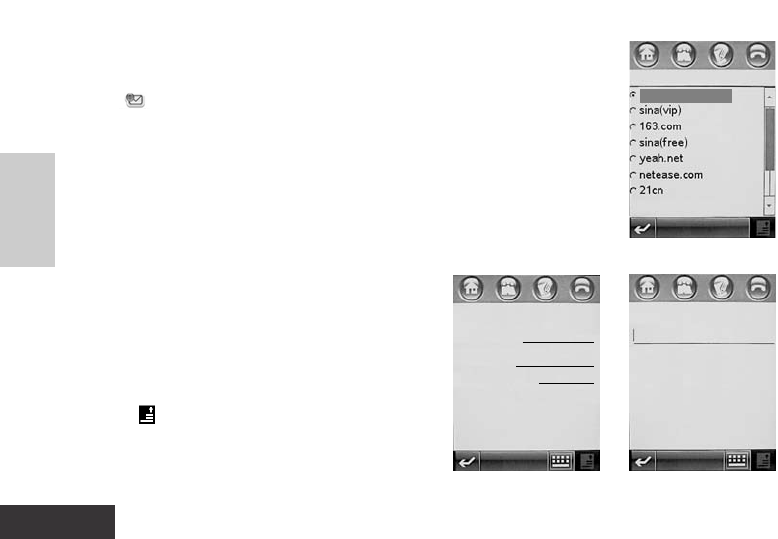
ENGLISH
Email
70 Email
Mailbox Setup
To utilize the email function, you have to configure your mailbox.
Tap on the Main Menu Screen and your phone will check the
Internet connectivity. If the connectivity is not available, refer to Network
section for details on how to set up your network. If it is available, the
phone continues to check for mailbox availability. If it finds no available
mailbox, a Mailbox Setup screen appears, as shown in figure 1, where
you may set up your mailbox either manually or automatically.
Automatic Setup
1. Select a mail network operator provided with
your phone and then tap OK. Your phone
screen will be seen as shown in figure 2.
2. Enter your Username and Password. Then
reenter your password. Tap OK.
3. Tap and select Mailbox Setup. Then reen-
ter your password Tap the mailbox name and
you may configure mail sending, receiving,
Figure 1
Figure 3Figure 2
OK
Mailbox Setup
OK OK
Mailbox:163.com
User Name:
Password:
Reenter password:
Mailbox Name:
Send Setup: Message
Receive Setup
Signature Setup
Email
Setup Manually
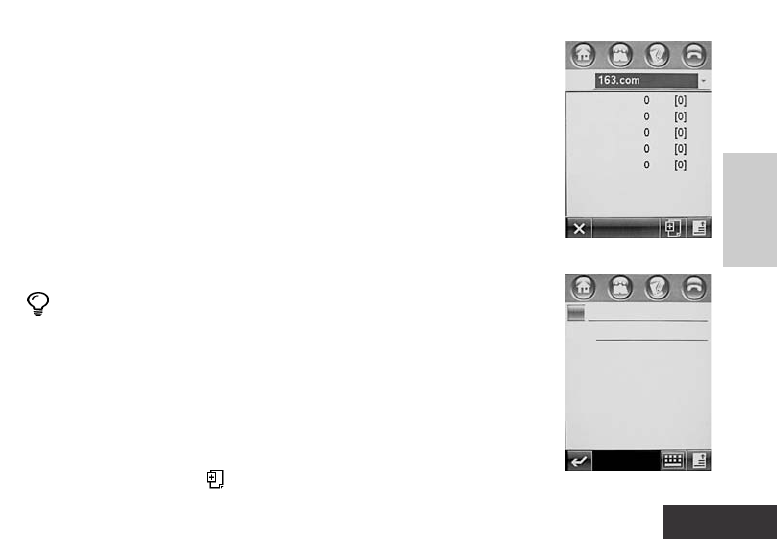
ENGLISH
71
Email
Email
and signature on the screen.
Note:
The list (as shown in Figure 1) of Mailbox Setup varies depend-
ing on your network operator. Please refer to your phone for details.
Manual Setup
1. Select Manual Setup from the screen as shown in Figure 1 and then
tap OK. Your phone displays a screen as shown in figure 3.
2. Tap the mailbox name field and enter a name for the mailbox.
3. You may configure mail sending, receiving, and signature on the screen
and tap OK.
Tips
You may create multiple mailboxes. In such a case, if you
enter no name for each mailbox on the manual setup
screen, your phone will assigns name for such mailboxes as
Mailbox n, where n is 1, 2, 3, 4 ...
Writing and Sending Emails
Once you successfully log in a mailbox, the screen will like the one
shown in Figure 1. Tap at the bottom of the screen to bring up a
Figure 1
Figure 2
Receive
Mailbox:
Inbox
Drafts
Outbox
Sent Items
Trash
Send
To:
Subject:

ENGLISH
Email
72 Email
screen for mail writing, as shown in Figure 2. Enter the mailbox address of the recipient at the
cursor as shown in Figure 2; or tap To: and select a recipient from your Address Book. Then
you may enter the Subject and mail content. Tap Send and select link method to send your mail.
You may attach Contact, Date Book, Tasks, or Other documents to your mails. In the screen as
shown in figure 2, tap and select Insert Attachment from the popup menu. Select an option
as shown above to attach these documents into your mail.
On completing a mail, you may tap at the right bottom of the screen and choose relevant
option from Save to Drafts, Insert Signature, CC, BCC or Setup Priority.
Receiving, Viewing, Reading a Mail or Sorting Mails
The function is similar to the message viewing, reading, and sorting of the Message Center.
Please refer to Message Center section for relative instructions.
Private Folder
The function is similar to the private folder of the Message Center. Please refer to previous simi-
lar instructions.

ENGLISH
73
Browser
Browser
Your phone is a new type of mobile communicator that is designed with the General Packet
Radio Service (GPRS) functionality. It allows you to access the Internet and receive/send emails
via GSM-based GPRS connections, in addition to CSD connections. You'll find your phone to be
a powerful tool that delivers convenience and brings you closer to the world. The super-large
touch screen makes your surfing on the Internet more enjoyable.
Note:
GPRS availability depends on your network operator and whether you have sub-
scribed for it.
Note:
Options for Internet access depend on the availability of these services offered by
your network operator and whether you have subscribed for these services. Check
with your network operator regarding WAP configurations.
For WAP-based Internet access, you need:
1. Subscribe for GPRS Data service from your network operator.
2 Subscribe for a WAP service from your Internet Service Provider (ISP).
3 Set up your device to enable you to connect to the Internet.
4 Activate your WAP browser to access the Internet and perform relevant operation.
Tips:
Refer to descriptions on "Network" on how to set up the network connection.
Tips:
The main data gateway of your network operator will use your phone number as
your account number.
Chapter 7 Browser
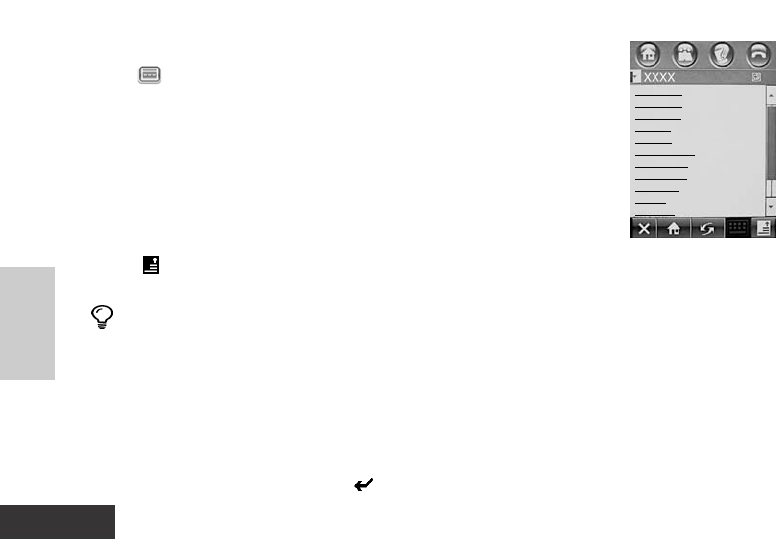
ENGLISH
Browser
74 Browser
Activating WAP Browser
1. Tap symbol in the Main Screen to enter the Browser screen;
2. If connecting to the Internet is successful, the Browser Startup screen
displays. If you have made a correct setting in the Network
Connection Setup screen, you may link to a network URL directly, as
shown in the figure.
3. After log on successfully, you may view the service item using the
scroll bar, just as you do on other list screens. Tap a service to enter
the next content level, where you may view certain content.
4. Tap menu key and you may select a number of options from the menu, including
Favorites, About, Go to Site, File, Browser Profile Setting, Security, More, and Exit.
Tips:
Different WAP page will show different contents and require different logon proce-
dures. Some WAP pages even require you to enter your username and password.
Browsing Information and Using Access Function
Making a Selection
If your homepage includes a series of options listed in order, you may view these options by
tapping the scroll bar. When you find the option you want, tap the option and enter the next level
content for browsing. Otherwise, tap to return to the previous screen.
My Moternet
Palm Beijing
Recommend
Net Home
Jewel Box
News & Weather
Tone & Picture
Chat & Friend
Game & Joy
Fashion
Animations
Browser

ENGLISH
75
Browser
Browser
Entering Information
Some web pages contain entry fields for information exchange with the website. You may enter
information in these fields just as you do for other functions of your phone.
Disconnecting from the Internet
Tap in the Browser screen and then tap Exit to disconnect from the Internet.
Note:
You can only disconnect from the Internet by tapping Exit. If you access the Internet via
a CSD connection, you cannot make phone calls or send messages whilst the connec-
tion remains. However, if you use GPRS to access the Internet, you can dial out or send
messages without disconnecting your phone from the Internet.
Downloading Files
The phone offers a powerful downloading function enabling you to download more applications and files simply and easily.
1. Launch the Browser. Log on a web page.
2. You may select a J2ME application or a file you want to download, provided that the web
page offers file and/or application downloading. Your phone must have sufficient spare mem-
ory space to store the J2ME applications or files to be downloaded; otherwise, you may have
to cancel the downloading or delete some old applications or files.
3. After you have confirmed for your downloading, a location should be specified to save the
application or file to be downloaded. Then you may start downloading.
4. When the downloading is completed, you may view them, return to the web page, or exit the browser.
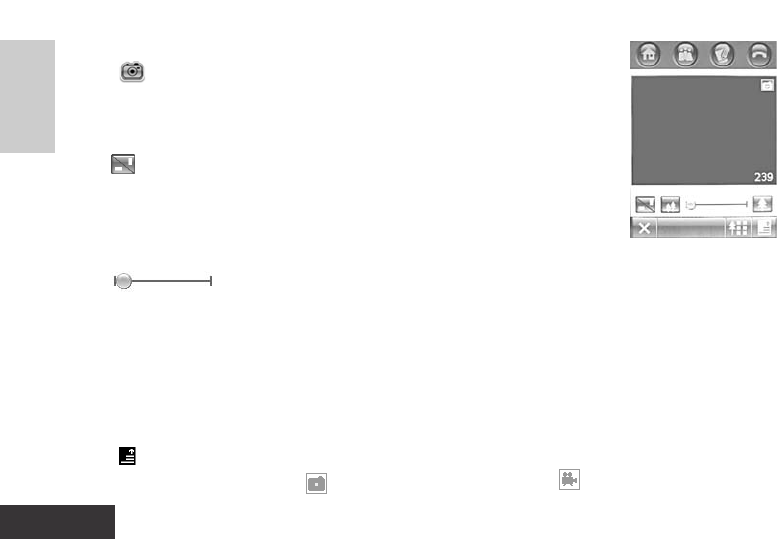
ENGLISH
Camera
76 Camera
View-Finding
Tap on the Main Menu Screen to enter the Camera function, as
shown in the right Figure.
1. The frame in the screen indicates the viewfinder.
2. The symbol is a View-Finding Button. Tap it to toggle between the
landscape view and portrait view.
3. The numeric value at the low-right of the viewfinder estimates the
remained recordable photos. Make sure there is enough free space to
store photos you are taking.
4. The symbol is a zoom control. It includes a slider that allows you to zoom in or
zoom out the object in the viewfinder. Alternatively, you may also adjust the viewfinder by
using the external Camera Volume Key on your phone.
5. Tap Capture to take a picture. Alternatively, you may also take a picture by pressing the
external Camera Softkey.
Shoot
Tap in the Viewfinder screen and select Record video from the menu. The phone will enter
Record Video mode. The icon at the top of the screen turns to .
Chapter 8 Camera
Capture
Camera
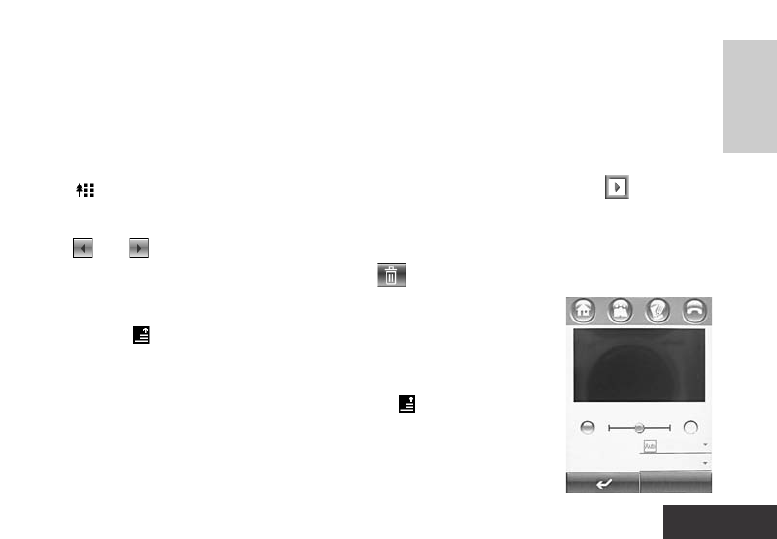
ENGLISH
77
Camera
Camera
1. Tap Record button to start taking a picture. The Done button will be shown at the bottom of
the screen.
2. Tap Done to stop shooting. The video will be saved automatically.
Preview or Delete Video or Photo
In the viewfinder screen for photographing or video recording:
1. Tap to preview the video or photo you have taken using the phone; Tap to play the
video you have recorded.
2. Tap and at the top of the screen to preview the previous or the next video or photo.
3.
If you are not satisfied with the result, you may tap to pop up a Delete dialog box, where you may
confirm your deletion to have your phone deleting the current video or photo.
4. You may tap to make your choice from the menu for certain operations.
Effects
You may take photos with different effects. Tap in the viewfinder
screen and select Effects from the popup menu; the phone's screen
enters Effects Setup Screen, as shown in the right Figure, where you
may adjust and specify the Brightness, Light, and Style of your photos.
Done
Brightness:
Light:
Style:
Auto
Off
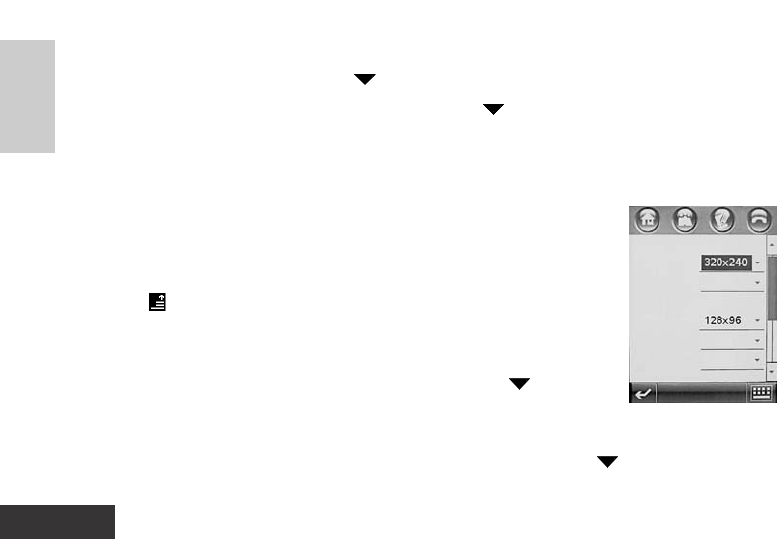
ENGLISH
Camera
78 Camera
1. By drag the Brightness Slider on the screen, you may specify the brightness of your photos.
2. To adjust the lighting environment, tap in the Light field and select an option from the popup menu.
3. You may specify different styles for your photo. Tap following the Style field and select an
option from the popup menu to change your photo's style.
When you adjust and set the Brightness, Light and Style for your photos, the image in the
viewfinder changes accordingly. Once you feel satisfied with the photo effect in the viewfinder,
you may tap Done. The screen will return to the Viewfinder screen. Now,
you may take a picture or have a shoot.
Setup Options
Tap the symbol in the viewfinder screen and select Setup from the
menu to enter the Setup screen, as shown in the Figure. To view addi-
tional setup options, drag the scroll bar.
1. You may specify the Size of your photos or video. Tap symbol fol-
lowing the Size field; Select an item from the popup menu to set up
the size of your photos.
2. You may also specify the quality of photo or video display. Tap symbol following the
Quality field and select an option from the popup menu.
Done
Photo:
Size: M( )
Quality: Best
Video:
Size: S( )
Quality: Best
Length: 5 minutes
Default Name:
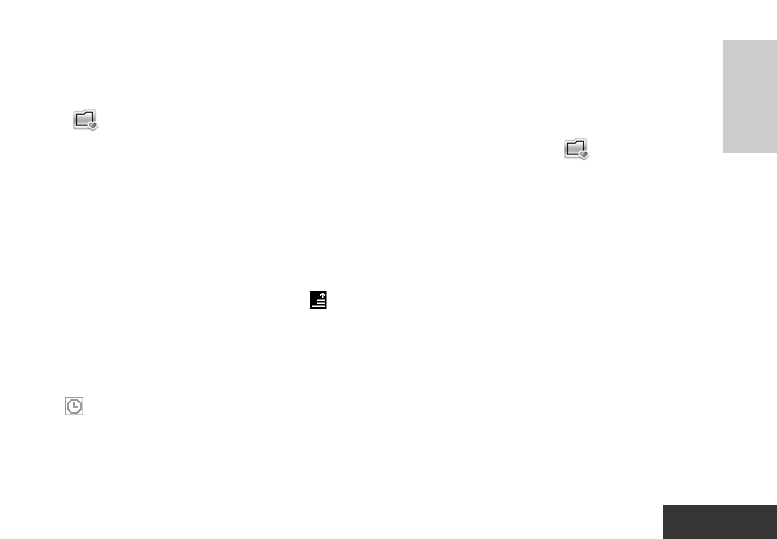
ENGLISH
79
Camera
Camera
3. You may name photos you want to photograph to facilitate future searching and browsing.
Each photo may be named in either of two formats: the Photographic Format numbered by
date and time and the User Defined prefix.
4. Tap following the Shutter Sound to select the shutter sound when taking a picture.
5. You may also specify a storage location for your photos or videos. Tap symbol following
the Save to field and select the location where your photos or videos will be saved.
When you finish the above setting, tap Done to return to the Viewfinder screen.
Delay-Timer
The Delay-timer allows your phone to photograph after a specified delay.
1. In the Viewfinder Screen, tap the symbol to select Delay-Timer On. A Delay-Timer
Indicator appears above the viewfinder. The Photograph or Shooting at the bottom of the
screen turns to Start.
2. Tap Start and a Stop button appearing at the bottom of the screen. The Delay-timer displays
as 10". At the same time, the indication of the second-counter successively decreases
until the photo is taken. If you tap Stop during the process, the timing action will stop.
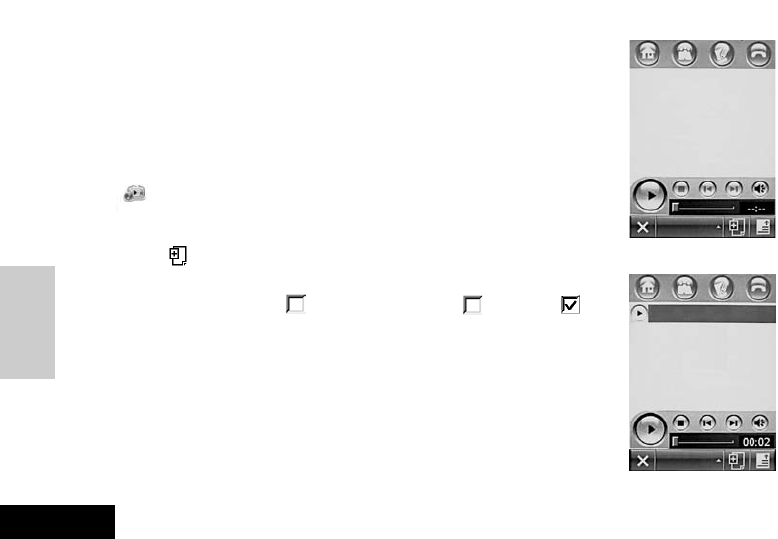
ENGLISH 80 Media Center
Media
Center
Your phone is differentiated from normal telephones by its Media Player
function. It is also supplied with a Media Library, where you may select
and play audio or video files. In addition, your phone allows you to edit
such files.
Playing Audio and Video Files
Tap on the Main Screen to show a screen as Figure 1. By tapping
on Audio, you may select Audio or Video.
By tapping you'll see a list for you to add files. Depending on the type
you selected (Audio or Video), the list shows only those files of the type
you selected. If you tap the followed by a file, the will turn to . By
tapping OK, the file you selected will be added into the playback list, as
shown in Figure 2.
Note:
A media list is shown in the manual for demonstration only. Refer
to your phone for the actual list.
Tap a file to play it.
Chapter 9 Media Center
Figure 1
Figure 2
Audio
Audio
Alert-1.mid
Flare.mid
Pizazz.mid
Sweet.mid
Media

ENGLISH
81
Media Center
Media
Center
Tap and hold a file to pop up a menu, from which you may select View Details, Remove track,
Share, or Reorder track.
Tap to play files highlighted on the list; tap to stop playing; tap or to play the
previous or the next file.
Tap to mute the sound; tap it once again to resume.
Tap to select Remove tracks, Reorder tracks, Shuffle, or Repeat.
Tips
A slider is available under the Play Button Bar on the List Screen. It indicates the
progress of file playing. The timer to the right indicates the elapsed time.

ENGLISH
Picsel
Browser
82 Picsel Browser
Picsel Browser enables on-screen reading of almost any file format. It also allows you to surf on
the Internet.
To enter the Picsel Browser function, tap from the Main Screen.
With the help of a stylus you can move a page display in any direction - by tapping the screen in
that direction, just like shifting a paper using your hands. You may also zoom in any portion of
the display by double tapping the center point of the screen (tap the screen quickly, release the
stylus, and then quickly tap the screen on the same point once again), followed by tapping on
the screen upper or lower.
To shift up or down a page, you can use the Direction key, while using the Volume key on the
left you may zoom in or out it.
Although Picsel Browser can process a variety of file formats, including PDF, Microsoft Word,
PowerPoint, and Excel, JPEG image, PNG image, Plain Text, and HTML°A display of certain
file formats may be slightly different from that on your computer. For detailed information, refer
to User's Guide.
You may call up menu options of Picsel Browser by tapping the screen at the bottom right cor-
ner. These options allow you to open a new file, adjust the screen, configure Picsel Browser
settings, or exit a file. To learn the usage of each option, tap and hold your stylus on its icon
until a tools tip detailing the option appears.
Chapter 10 Picsel Browser
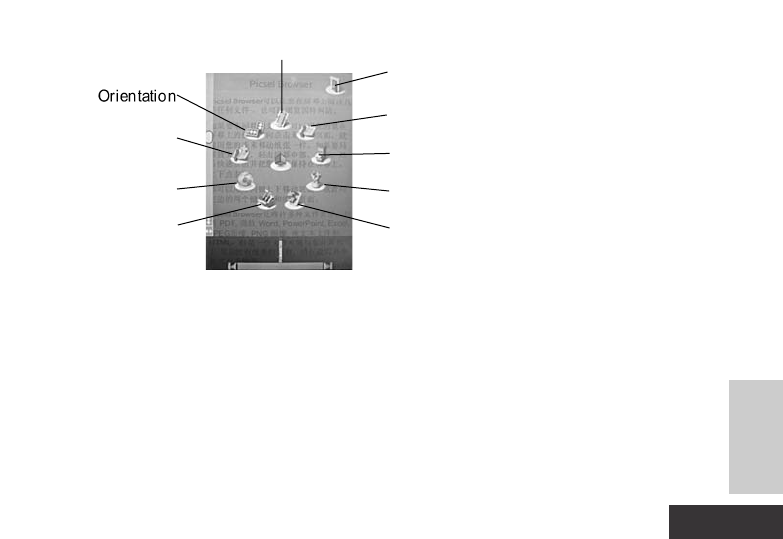
ENGLISH
83
Picsel Browser
Picsel
Browser
Refer to the figure on the next page for indication of Picsel Browser's menu options.
View
Picsel Browser is provided with a Main Menu, on which four key viewing functions are
listed to select and view files.
File Viewer
When you read this document, you are using the Picsel Browser's core function -
viewing files. You may scroll a file up and down, in an enlarged or de-magnified view,
to read all parts of it. If you are reading a file with many pages, you may move to the
previous or next page by tapping your stylus along the bottom side of the screen, just
Cancel
Bookmarks
Flowdown Layout*
Browse Table
of Contents
Historian
Reload
Current File
Bookmark Current
Page
Input URL
Open Option
Setting Dialog
*
When you select the
function, you may
resume the display to
"Normal Layout" by call-
ing up the menu item on
the left figure once
again. When the display
is resumed, the icon
also changes.
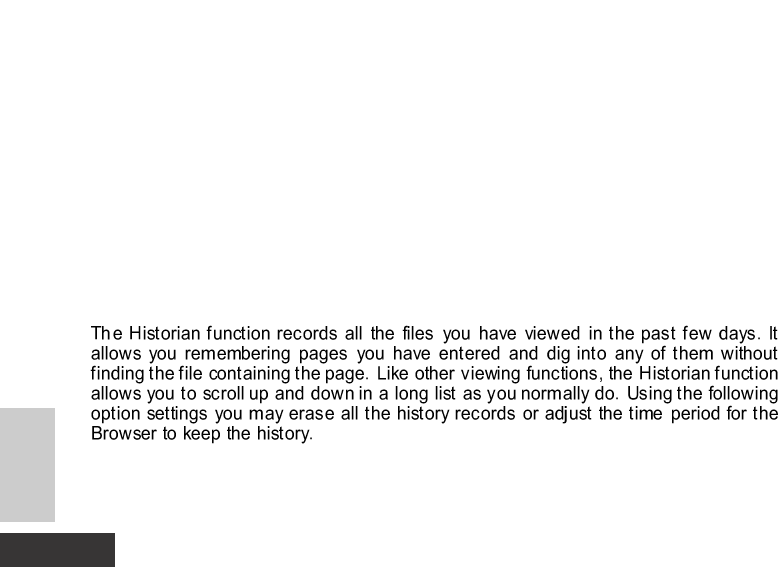
ENGLISH 84 Picsel Browser
like you turn to another page of a book. You may also rotate the screen display of a
file or toggle the display between "horizontal" and "vertical" for your preference.
Folder Explorer
The Folder Explorer function allows you to view files saved on your device or memory
card just like you do with those on a desktop computer. You may open a folder to find
more files, or reorganize the list of these files on the sorting order and display mode
using several special menu functions. (To learn how an icon functions, put your stylus
on it until a tools tip appears.) To open and read a file, select it and tap the File Viewer
option. If a folder contains a list too long to be shown on a single screen, you may
scroll it up and down as you normally do.
Historian
Bookmarks
The Bookmarks function enables you to record your favorite files and websites so that
you can access them conveniently later on. You may add a file to the list using a File
Picsel
Browser
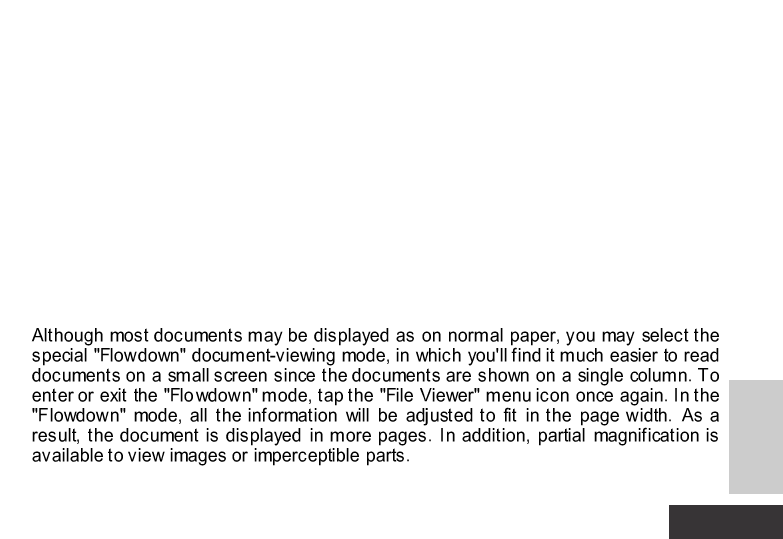
ENGLISH
85
Picsel Browser
Picsel
Browser
Viewer menu option, and remove it from the list using a Bookmarks menu option.
Special menu options are also offered to sort your favorite files in a convenient order.
Special Functions
You'll find it more enjoyable to work with Picsel Browser offering several unique func-
tions. You may rotate the screen display, toggle between horizontal and vertical dis-
plays, or select a size for your display. All these allow you reading files more conve-
niently.
You may shift the current page by tapping on the screen just like moving a piece of
paper. When you draw a horizontal line along the bottom side of the screen, you turn
to the previous or the next page - as if you are flipping a book. A portion of the display
may be zoomed in or out for your preference, by double tapping the screen (on a
same point) and then tap the screen as you move your stylus up and down.
When you view a webpage, you may use the "Track Link" mode, in which you can

ENGLISH
Picsel
Browser
86 Picsel Browser
track links or complete a table. By pressing the key on the right side of your mobile
you can see a border surrounding each selectable item. You may navigate through
these boxes and select one using the Central Key. Each type of content will operate in
an appropriate manner: If you select a text box, a menu, or something alike, the
selected box changes in color, reminding you to make further selections. If you want to
cancel, press the Central Key repeatedly. Similarly, you may double tap a link to open
its target page.
Preferred Setting
Picsel Browser is supplied with several options that you may set up from the Main
Menu as you prefer. Most of these options are only those of your choice, for example,
days before a record is removed from the history list. However, other options may
determine whether the software application would run properly.
If a "Proxy" is needed to connect to your Internet service, you may select it from the
option setting of Picsel Browser or the network setting of your device. To define a
proxy, you should specify both its address and port.
The internationalized Picsel Browser can recognize documents in many languages.
However, although a range of "language codes" is available to store characters in dif-
ferent regions, not all these codes may be distinctly decoded from files. You should
select the default setting for ambiguous documents as the preferred character set for
your language. If you use an improper character set, the text would be shown as
meaningless characters.
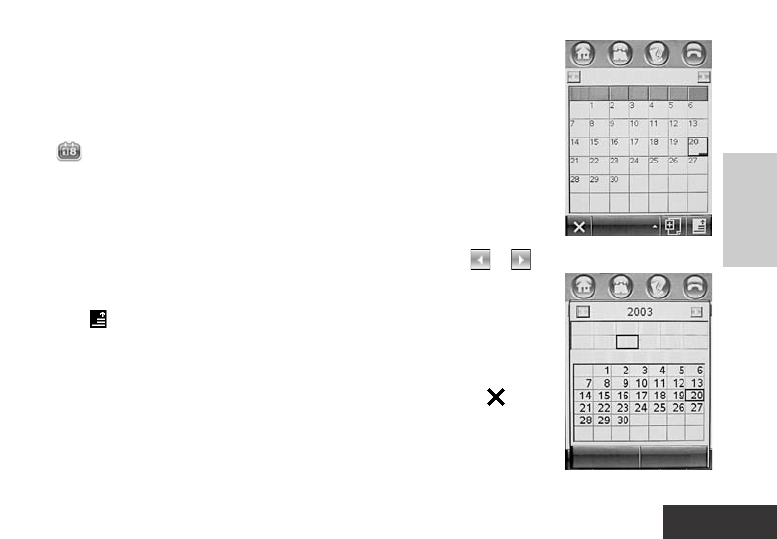
ENGLISH
87
Calendar
Calendar
Your Calendar allows you to make and record arrangements. When it's
time for an arranged event, your phone plays a reminder alarm alerting
you to complete it, provided that you have enable the alarm. You may
also use the share function to send your arrangements to other phones,
or synchronize the data with other devices.
Tap on the main screen to enter the Calendar function. A Month
View screen appears as shown in Figure 1.
Month View
1. To view your arrangement for the previous or next month, tap or .
2. To view your arrangement for a day, tap the box marked with the date.
3. Press and select Jump to day from the popup menu. Your phone
shows a calendar screen (see Figure 2), on which you may select a
date and tap OK to view your arrangement for that date.
4. To return to the main screen from the Month View screen, tap .
Day View
To list your arrangement for a day, tap the box marked with the date on
Chapter 11 Calendar
Figure 1
Figure 2
Month
Sep. 2003
Cancel OK
S M T W T F S
Jan Feb Mar Apr May Jun
Jul Aug Sep Oct Nov Dec
S M T W T F S
Calendar
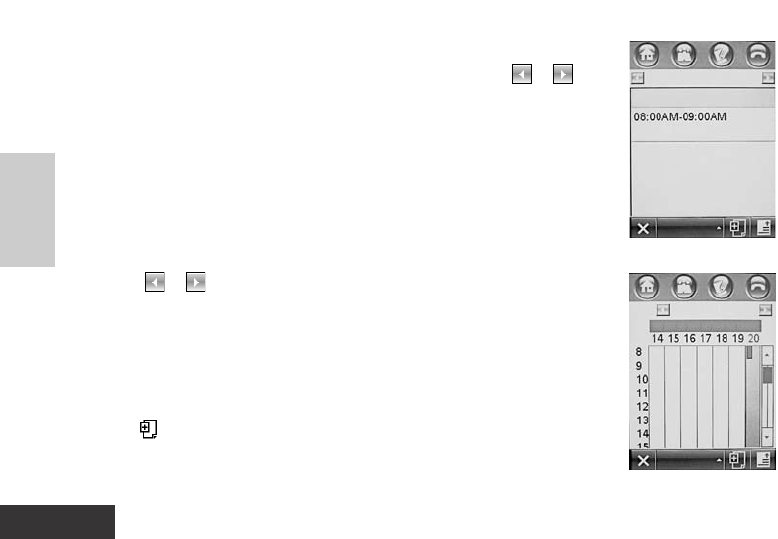
ENGLISH
Calendar
88 Calendar
the Calendar screen, as shown in Figure 1.The events in gray shadows
you see on the day view list are full day events. By tapping or , you
may scroll the screen to the view of the previous or the next day. To view
details on an event, tap it. If you tap and hold an event, a popup menu
appears. You may select an option from the menu to activate a certain
function.
Week View
To view your arrangement for a week, tap Month on the Calendar screen
and select Week from the popup menu, as shown in Figure 2. By
tapping or , you may scroll the screen to the view of the previous
or the next week. If you tap and hold the area for a day you want to view,
your phone shows a list of events arranged for the day.
Adding a New Event
To add a new event:
1. Tap on the Calendar/Day View/Week View screen; your phone
shows a list detailing the events arranged for the day.
2. Tap the direct line following each field to enter details of the event;
Figure 1
Figure 2
Day
Sat. 20-09-2003
Meeting
Attend Class
Sep
Week 38
Week
S M T W T F S
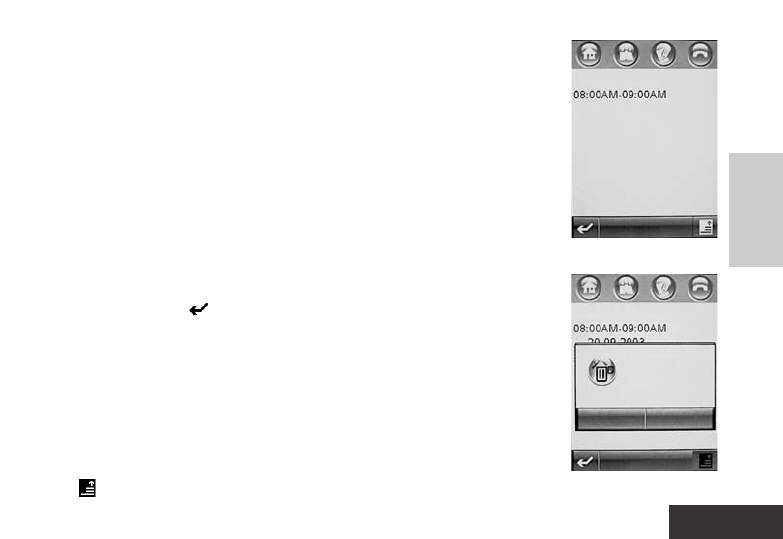
ENGLISH
89
Calendar
Calendar
3. When you complete your entry, tap Done. A new event is added into
your date book.
Editing an Event
On the screen listing your events:
1. Tap the title of an event. Your phone shows details on the event, as
shown in Figure 1.
2. Tap Edit. Your phone opens a screen to edit the event. To modify an
item, tap the direct line following the field.
3. When you complete your entry, tap Done. To return to the list of
events screen, tap .
Deleting an Event
To delete an event, tap and hold the event, select Delete from the popup
menu, and tap OK. Alternatively, you may operate as follows on the list
of events screen:
1. Tap an event you want to delete. Your phone shows its details.
2. Tap and select Delete event. A prompt box appears as in Figure 2.
Figure 1
Figure 2
Attend Class
Sat 0-09-2003
School
Edit
Attend Class
Edit
Cancel OK
Permanently
delete this event?
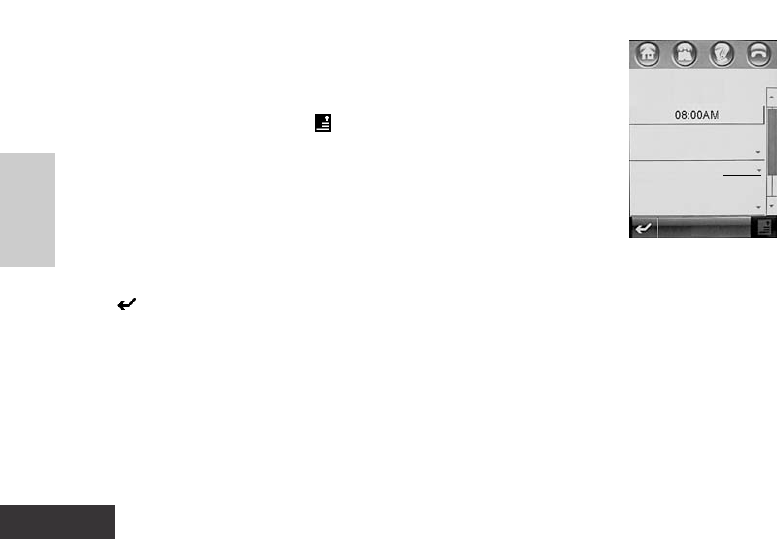
ENGLISH
Calendar
90 Calendar
3. Tap OK to delete the event.
Calendar Setup
To set up your Calendar, tap from Calendar/Day View/Week View
screen and select Setup from the menu, as shown in the right figure.
You may configure the starting time of an event, the time period after
which an event would be deleted, lunar calendar, Open View, or
Reminder Snooze.
Tap the direct line of a setting field to select relative information. When you complete your entry,
tap Done to save your setting. To return to the previous screen without saving your changes,
tap .
Setup
Event Start Time:
Remove Event After:
Never Remove
Lunar Calendar: off
Open View:
Month View
Done
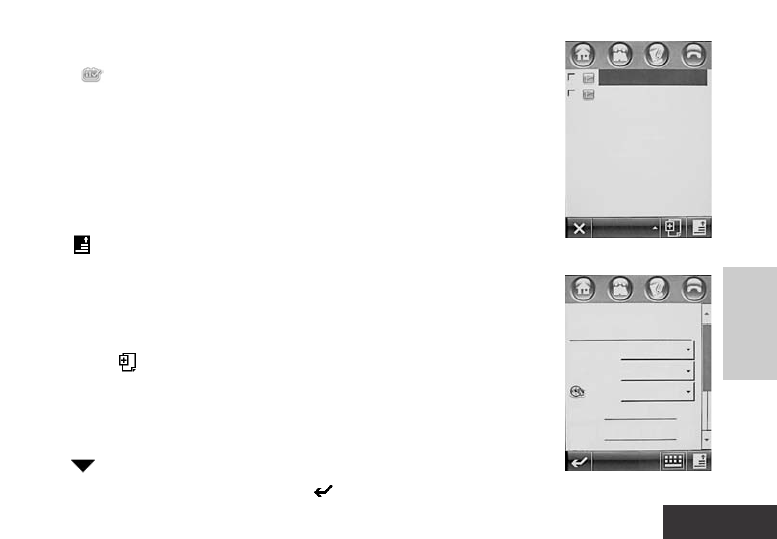
ENGLISH
91
Tasks
Tasks
Viewing Tasks
Tap icon on the Main Screen. Your phone shows a list of tasks (see Figure 1).
1. Tap a task item and you can see its details;
2. Tap and hold a task item. You may select Share, Delete, or Edit from
the popup menu and take appropriate operations;
3.
Tap All Tasks at the screen bottom. You may select an option from the
popup menu. Your phone would list your tasks according to your selection.
4. Tap on the tasks screen. You may select an option from the popup
menu to sort and view your tasks by the due date or the priority, or
delete the entire list of tasks you see on the screen.
Creating, Editing, and Saving a Task
You may tap from the tasks screen to create a new task; or select an
existing task and tap Edit. In both cases, you will enter a screen to edit
the details of the new or existing task, as shown in Figure 2.
1. You may tap the direct line following a field to enter information, or
tap to select an option from a drop list.
2. Tap Done to complete your editing; or tap to return to the previous screen.
Chapter 12 Tasks
Figure 1
Figure 2
Meeting
Shopping
All Tasks
Done
Title:
Meeting
Priority: Normal
Due Date: None
Alarm: Choose Time
Time:
Date:
Tasks
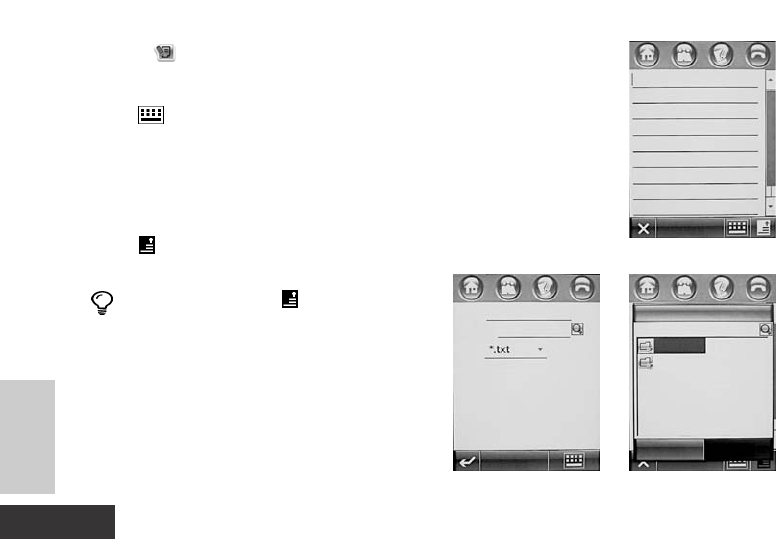
ENGLISH
Note Pad
92 Note Pad
Chapter 13 Note Pad
Tap icon on the main screen to enter the note pad editing mode, as
shown in Figure 1.
1. Tap to select an entry mode; then enter the content you want to
record.
2. Tap Done to enter a name, Save in, and type for the notepad entry, as
shown in Figure 2.
3. Tap Done to save the notepad entry.
4. Tap to pop up a menu. Select New to cre-
ate and edit a new notepad file.
Tips
You may tap and select Open,
as shown in Figure 3. Then you
may select a saved file to open and
read it.
Figure 1
Figure 3Figure 2
Done
Done Cancel Open
Name: Diary
Save in: Phone
Type:
Open
Phone
myCamera
myVoice
NotePad
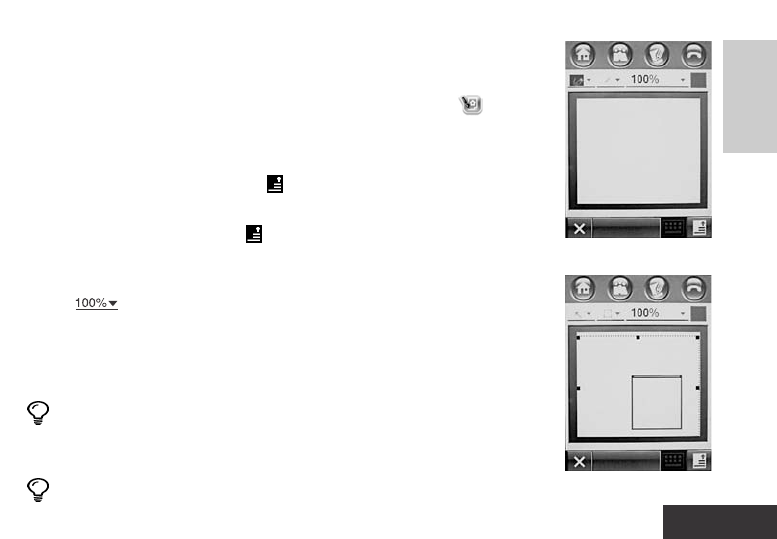
ENGLISH
93
Paint
Paint
Your phone is supplied with the Drawing Pad function which offers your
enhanced support for image editing, enabling you to create your favorite
pictures just as you will.
1. To open the Drawing Pad screen and edit an image, tap from the
main screen, as shown in Figure 1.
2.
Use tools on the tools bar appeared on top of the screen to draw a picture.
To edit an existing image file, tap and select Open; locate the picture you
want to edit and open it; use tools on the tools bar to edit the picture.
3. By tapping the Menu key , you may select New, Undo, Open,
Share, Insert Stamp, Select All, Choose Canvas, or Delete from the
popup menu and perform appropriate operations.
4. Tap to select a display ratio for your picture from the popup
menu, such as 50%, 100%, 150%, 200%, or Fit to Page.
5. Tap Done to enter a name, save in, and type on the screen.
6. Tap Done to save the picture and return to the image editor screen.
Tips
If you tap and hold an area selected on the picture, you may
select Copy, Cut, or Paste from the popup menu and per-
form operations you need, as shown in Figure 2.
Tips
Proceed with the same steps to edit a picture in your camera.
Chapter 14 Drawing
Figure 1
Figure 2
Done
Done
Cut
Copy
Paste
Drawing Pad
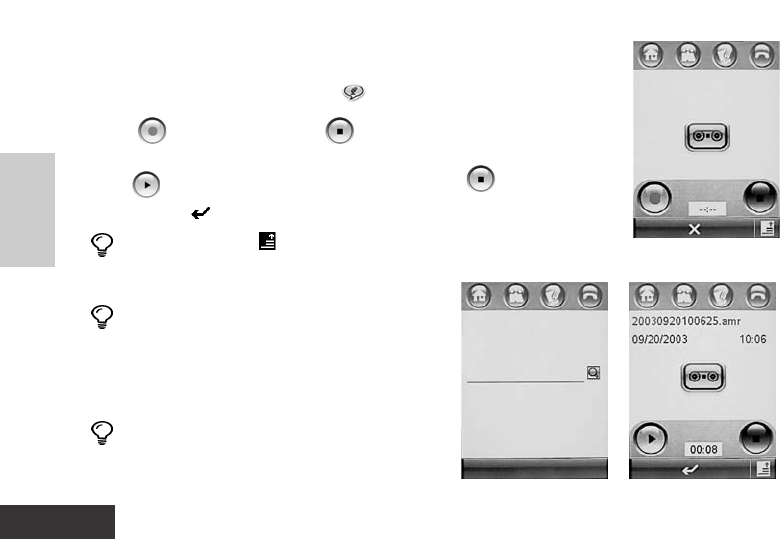
ENGLISH
Recorder
94 Recorder
You may use your phone to record talks of both parties during a call, or
record a voice note when no other recording tools are available.
1.
To activate the recorder function, tap icon from the main screen, as shown in Figure 1.
2. Tap to start recording; tap to stop recording. The voice file you
record will be automatically saved into My Document.
3.Tap to play the voice file you just recorded; tap to stop playing.
4. By tapping , you may start recording a new voice note.
Tips
If you tap on the screen shown in Figure 1, you may
specify a location to save the voice file you recorded by tap-
ping Setup, as shown in Figure 2.
Tips
When you are playing a voice file, the
date and time you see on top of the
screen are the date and time when you
created the file, while the time you see at
the bottom of the screen is the length of
the voice file, as shown in Figure 3.
Tips
When you are making a call, you may tap
the Record button to start recording the
talks of both parties. To stop recording,
tap the button once again.
Chapter 15 Recorder
Figure 1
Figure 3Figure 2
Setup
Default voice name:
Date and Time
Location:
MyVoice
Done
Recorder
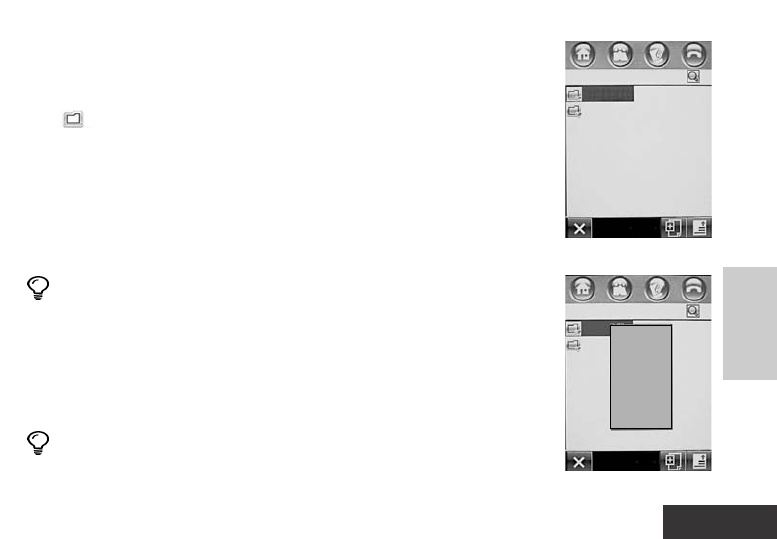
ENGLISH
95
My Document
My Document
The function enables you to manage your file simply and easily. You may
manually create a number of private folders to store and manage files
and applications.
Tap on the Main Screen to enter the File Manager screen.
Your phone is supplied with a number of predefined folders, as shown in
Figure 1.
Note:
Figures in the manual illustrate files and private folders to demon-
strate the functions of the file manager. These files and folders may dif-
ferent from your phone. Refer your phone for details.
Tips
A single folder cannot include two or more subfolders or
files that have the same folder or file name.
Editing Files and Folders
Tap and hold a file or folder that you want to edit. A drop list menu
appears as shown in Figure 2.
Tips
The menu items you see when pressing and holding a file
are different from those when you press and hold a folder.
Chapter 16 My Document
Figure 1
Figure 2
Phone
myCamera
myVoice
Phone
Phone
Phone
myCamera
myVoice
Copy
Cut
Move To
Rename
Delete
Properties
File Manager
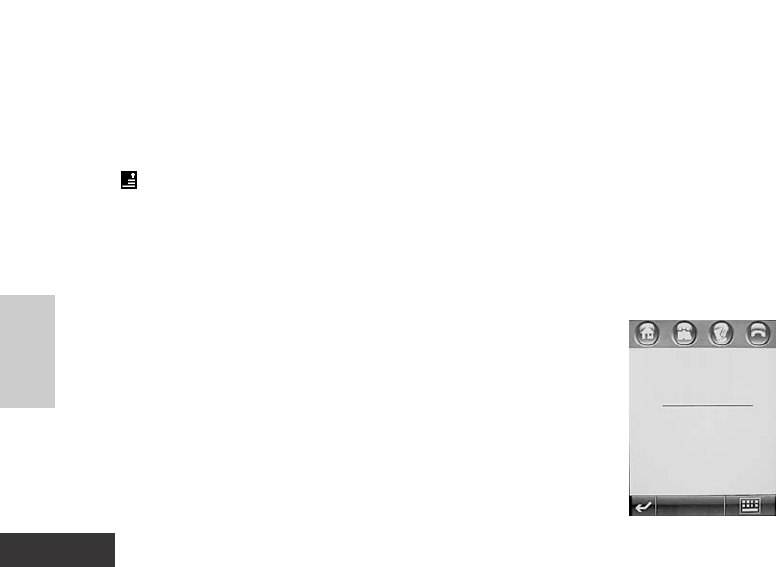
ENGLISH
My Document
96 My Document
By tapping Open With, you pop up a dialog box where you may select the format to open a file
or folder. When you have made your choice, press OK.
If it is possible, you may tap Install to install the file you selected.
You may tap Copy or Cut to copy or cut the file or folder to the clip board. If you tap the Menu
Key and select Paste, files or folders (if any) contained on the clip board will be pasted to the
current folder. If you paste a file or folder that you cut to the clip board previously, the file or fold-
er is removed from its original location.
Tap "Move to" to move the file or folder to a position you specified
Tap Rename to enter the Rename Screen, where you may choose an entry method and
rename it.
Tap Delete to open a "confirm to delete" dialog box. If you tap OK on the
box, the file or the entire folder and all files contained in the folder will be
deleted. However, if you tap Cancel on the box, you return to the previ-
ous screen.
Tap Share, a dialog box appears for you to select a share path. Select a
path and tap OK. The file will be transferred to other devices.
Tap Properties, File Properties or Folder Properties displays on the
New Personal Folder
In:Phone
Name: Animation
Done
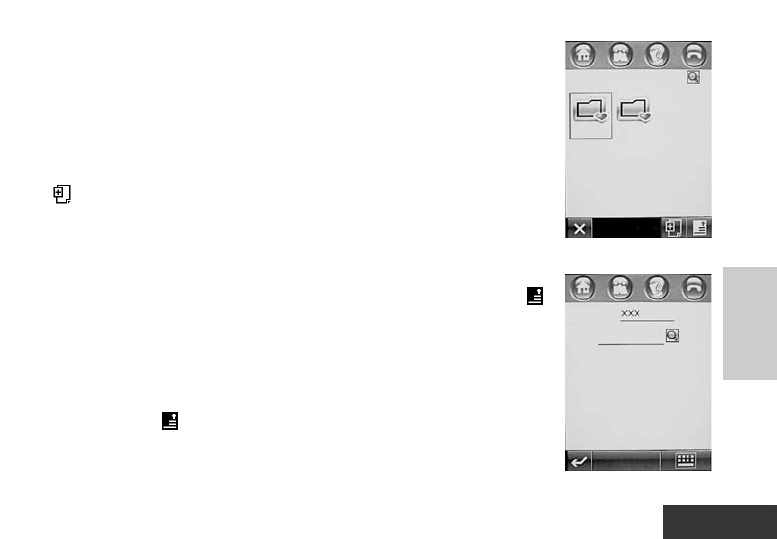
ENGLISH
97
My Document
My Document
screen. The Properties of a file include File Name, Type, Open With,
Size, and Last Modified (date); the Properties of a folder include Folder
Name, Location, Use Size, and Contains (how many subfolders and files
it contains).
Creating a New Folder
Tap in My Document, you may create a new folder in the current fold-
er, as shown in Figure 2 on the right. Enter a name and tap Done.
Viewing by
If you are viewing files or folders in a list, you may tap the Menu Key
and select Thumbnail to show them as thumbnails, as shown in Figure 1
on the next page.
Sorting
Tap the Menu Key and select Sort by. You may sort files or folders by
Name, Size, Time, or Type.
Figure 1
Figure 2
Phone
Done
Phone
myCamera
myVoice
Search Name:
Look in: Phone
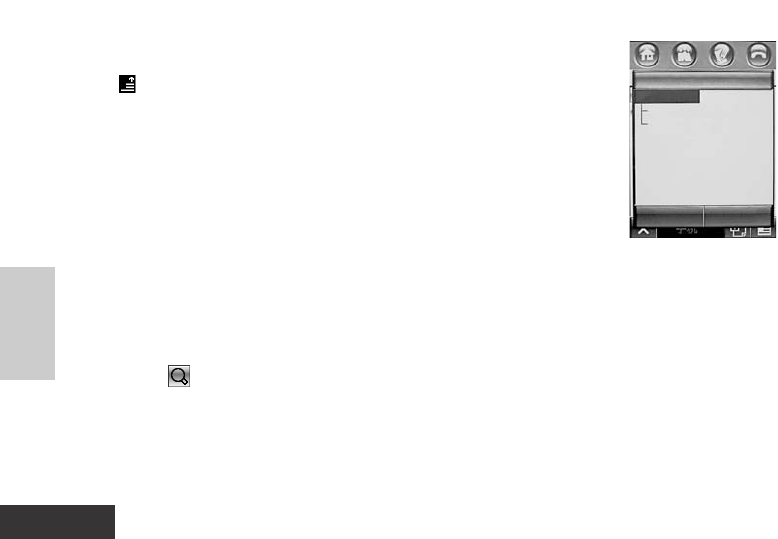
ENGLISH
My Document
98 My Document
Searching
Tap and select Search from the menu to enter the Search Screen, as
shown in Figure 2, where you may enter Name of the file to be searched,
select a scope from Search From for the file to be searched, and tap
Done to initiate searching.
If the file is found, the file will be listed. By tapping the filename, you may
open the file; if you tap and hold the filename, you may see the file path.
However, if no such a file is found, "There are no match file to display."
displays on the screen. If you tap Dismiss, you return to the My Document screen. You may
also tap Try again to return the File Search screen, where you may edit your searching condi-
tion to look for another file.
Folder Tree
By tapping symbol on the My Document screen, you may view a folder tree, as shown in the
right Figure.
Cancel
Select Folder
Phone
myCamera
myVoice
OK

ENGLISH
99
Share
Share
Share of information of your phone with other phones or computers is available, by sharing
address book entries, Calendar events, tasks, notepad entries, voice notes, voices, or images
and sending or receiving messages via Bluetooth, Infrared, Email, or MMS.
Receiving Data
1. Your phone is ready to receive data once a transmission link is established via Bluetooth,
Infrared, MMS, or Email. When you receive a message, the phone alerts you to operate as
the phone's instructions.
2. Once you successfully complete the receiving, you may Edit, Save, or Delete the file(s) you
just receive.
3. If the receiving is terminated accidentally, the word "Failed to receive"
appears on the screen.
Sending Data
Select data you would send. Tap Share from the popup menu. A dialog
box appears for you to select a share path, as shown in the right figure.
Select a type as you want and then tap OK.
Tips
If you select Bluetooth or Infrared, a connection screen
appears once you tap OK. To send the data, you have to
establish a connection on the screen. However, if you select
Email or MMS, a corresponding function screen will show up, where you may edit
and send the email or MMS.
Chapter 17 Share
Cancel
Share Via:
Bluetooth
IrDA
MMS
Email
OK
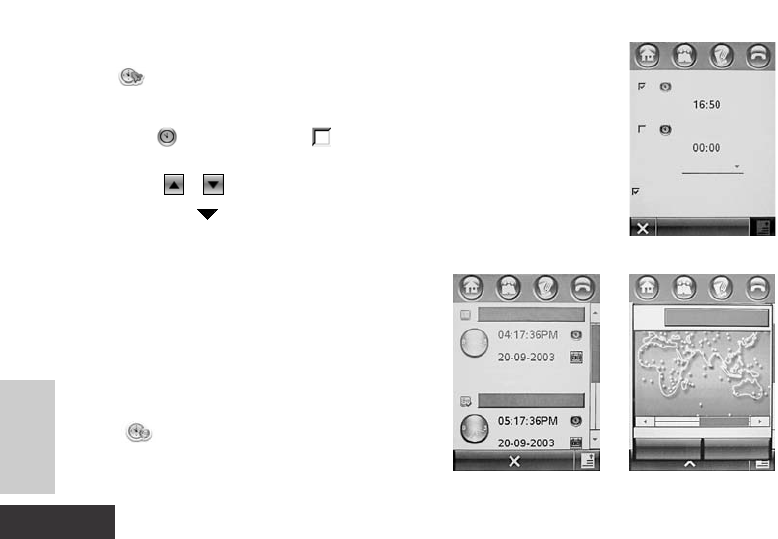
ENGLISH 100 Alarm Clock and Worldwide Clock
Alarm Clock and
Worldwide Clock
Alarms
Tap on the Main Screen to enter the alarm clock function, as shown
in Figure 1.
1. Check symbol preceding . Tap the time under the clock to show
the Alarm Clock Setup Screen, where you may set a time by
tapping or . When you complete your setting, tap OK.
2. Tap symbol following Snooze to pop up a drop list menu, where
you may set a snooze period for the alarm clock. The alarm clock will
alert again once the period is over.
3. If you check Alarm when power off, your
phone will automatically switch on and alert
when it's time to alert. After the alert, the
phone will automatically switch off.
WorldTime
Tap on the Main Screen to show the
WorldTime screen, as shown in Figure 2.
Chapter 18 Alarm Clock and WorldTime
Figure 1
Figure 3Figure 2
Done
Alarm 1
Alarm 2
Snooze: 10 min
Alarm when power off
Cancel OK
Beijing
Beijing
Tokyo
City
Clock
WorldTime

ENGLISH
101
Alarm Clock and Worldwide Clock
Alarm Clock and
Worldwide Clock
1. Tap the City field following to display a time zone chart, as shown in Figure 3. Tap the City
field to show a list of cities. Select a city and tap OK to return to the time zone chart. Tap OK
once again; your phone displays a screen listing worldwide times. You may also tap a time
zone on the chart to pop up another city list - a list of cities contained in the zone. Also select
a city from the list.
2. You may reset time and date for a certain city. Tap followed by the name of the city to turn
it into . Proceed with your setting by tapping the time or date field under the city name. Tap
Date; your phone displays a calendar for you to reset the date.
3. You may add a new city by tapping and selecting Add New City. On the Add New City
screen, enter the city name and its time zone. Finally, tap Done.
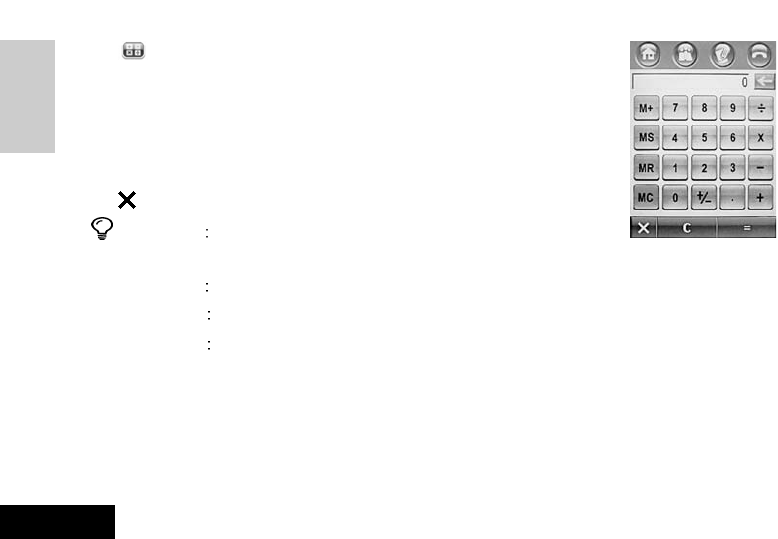
Tap on the Main Screen to enter the calculator function, as shown in
the right figure.
Tap numeric and calculation keys to perform a calculation;
Tap "=" to show the result;
Tap "C" to clear the calculation;
Tap to return to the Main Screen.
Tips
M+ Store the sum of the calculation result on the Display
M+ field and the number that already stored;
MS Clear the number that already stored and store the current calculation result;
MR Display on the Display field the number stored;
MC Clear the number that already stored.
Chapter 19 Calculator
ENGLISH 102 Calculator
Calculator
Calculator
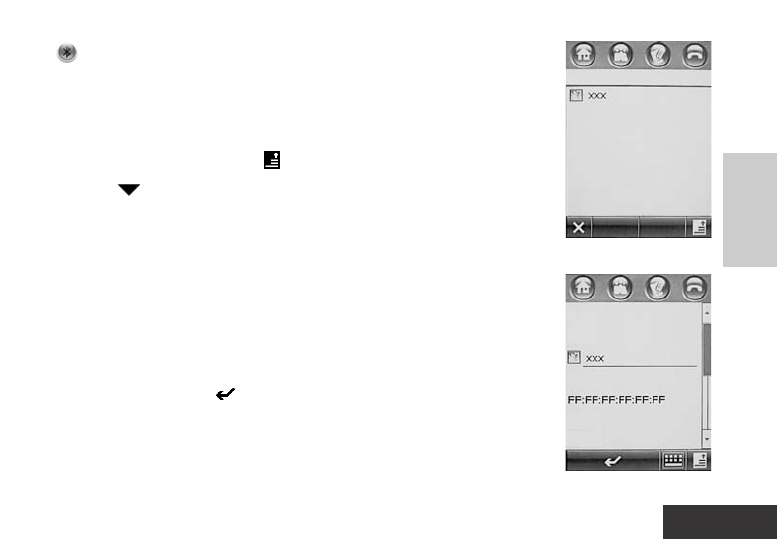
ENGLISH
103
Bluetooth
Bluetooth
Tap on the Main Screen to open a Device List screen, as shown in
Figure 1.
Turning on Bluetooth
1. On the Device List screen, tap and select Setup.
2. Tap icon following the Power and select On to turn on the
Bluetooth function.
3. To complete your setting, tap Done.
Viewing, Adding, and Setting Bluetooth Devices
1. If you have added one or more Bluetooth devices on the Device List
Screen, you may tap a device name to view its details, as shown in
Figure 2. You may edit any detailed item of the device. To return to the
Device List Screen, tap .
2. Tap and hold a device name. From the popup menu, you may select
Create Bond, Connect, Delete, or Lock/Unlock for appropriate opera-
tions.
Chapter 20 Bluetooth
Figure 1
Figure 2
Find Me Search
Device List
Device Information:
Name:
Address:
Type:
Phone
Bluetooth
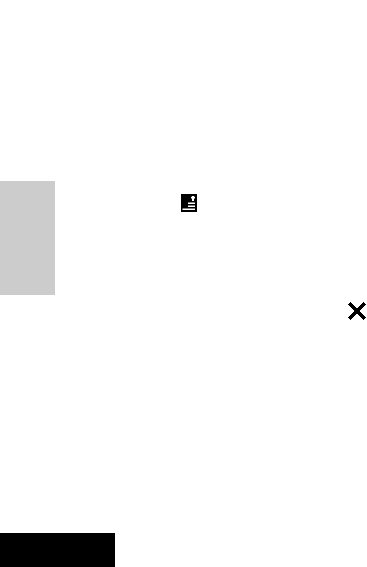
3. If you have added no device or want to add a new device, you may tap Search at the screen
bottom. Your phone will search for new devices/types. When the searching is completed, the
results are listed. Select a device and enter the Bluetooth bonding password. If the bonding
is successful, your phone returns to the Device List Screen, where name of the newly bound
device will be shown.
4. If you tap and select Delete All, all devices on the list will be deleted. To set up a connec-
tion, tap Setup.
5. By tapping Find me, you may determine whether your phone is within the range specified for
info transmission employing the Bluetooth technology.
6. To exit the Bluetooth function, tap .
Using Bluetooth for Information Transmission
With Bluetooth, you may transmit/receive and share V-files or V-documents, such as Vcard and
V-Calendar, between your phone and computers or other devices.
Sending a Message
If connection to a Bluetooth device is ready:
1. Tap and hold the file message you want to send. Select Share to show the Types of Share
list;
ENGLISH
Bluetooth
104 Bluetooth
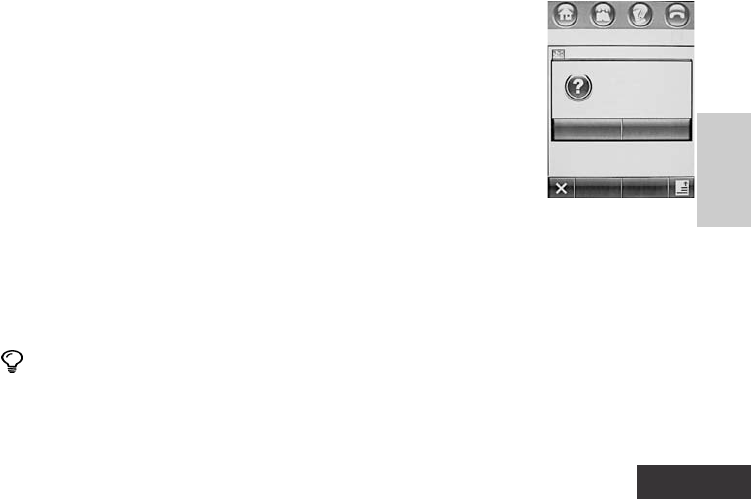
ENGLISH
105
Bluetooth
Bluetooth
2.
Select Bluetooth from the List. The screen shows a Device List. Select the
recipient from the Device List. If the recipient does not available in the
Device List, select Search and choose the device from the searching result;
3.
Tap Send. Sometimes you may need to enter the password as appropriate
to initiate the message transmission. On completing the transmitting, your
phone shows "Transmission to [xxx]";
4. Tap OK to return to the file screen.
Receiving a Message
If connection to a Bluetooth device is ready, your phone will alert you as
soon as a message is received. Take a V-file for example, as shown in the right figure, you
may operate as follows:
1. Tap OK. If necessary, your phone displays a Password Entry Screen. Enter the password for
device connection and tap OK;
2. If you enter a correct password, your phone will indicate the message transmission status.
On completing, you may view the message just received from the Indication Screen.
Tips
If you have just received a document, you may select a location from the Indication
Screen for storage. Enter the correct password whenever necessary. When the
receiving is successful completed, you may directly view the message you just
received.
Find Me
Search
Device List
Accept a file from
A768?
Cancel OK
A768
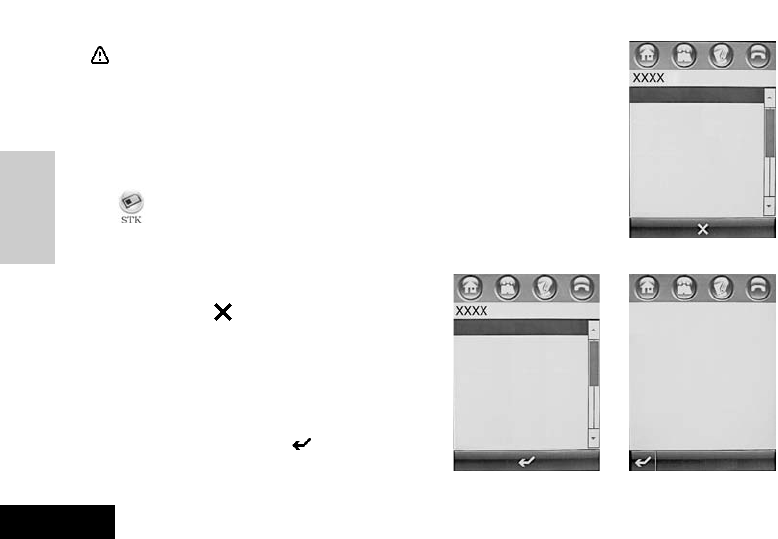
Note
The function is dependent on whether your network service
provider offers the services and whether you have sub-
scribed for such services. If you insert a STK-enabling SIM
card and turn on the function on your phone, you may enter
the STK function by tapping the STK symbol on the Main
Menu Screen, provided that the system is not busy.
Tap on the Main Screen to enter the SIM Function Screen, as shown
in Figure 1. Name of available functions are listed on the screen and you
may view them using the scroll bar. Tap a service name to enter the specif-
ic function screen of the service. To return to the
Main Screen, tap .
Each service may be one type of display and
service operation modes as follows:
Figure 2 illustrates the option list of the next
function layer. You may choose from the options
that offer services; or tap to return to the
screen of the previous layer.
Chapter 21 STK Application
ENGLISH
STK Application
106 STK Application
Figure 1
Figure 3Figure 2
OK
Send my feeling
e-mail Mobile E-mail
Look for your
Ask the way
Daily words
Tel-fare
Daily word libraries
Public info
Call me back as soon as possible
Sorry, I have to be late
I'll not be home for dinner today
See you right there
Bon voyage
Happy holidays
Miss you very much
Good lucky
Call me back as soon as possible

ENGLISH
107
STK Application
STK Application
You may view details on a service on a screen as shown in Figure 3. Tap to return to the
screen of the previous layer.
You may be required to enter certain information to use these services, using handwriting or
other entry methods. For details on specific entry methods, refer to relevant instruction.
Tips
The functions, options, and content of each specific function are given in the fig-
ures for information purpose only. Refer to your phone for details.

ENGLISH
Network
108 Network
Network
Tips
Certain content and terms in the section may involve computer or Internet tech-
nologies, which cannot be detailed in the manual. For detailed information on such
technologies, contact your network operator.
Tips
To access the Internet, you need network support and should subscribe for the service.
Tips
Your phone number will be used as your account number by the main data gate-
way of your network operator.
Your phone is generally configured with all the relevant parameters.
Your phone may be used to access the Internet using the high-speed GPRS or standard CSD
channel.
To configure your phone, please contact your network operator for the following parameters:
1. The telephone number to dial when accessing the Internet;
2. The username and password you have to enter for authentication when accessing the
Internet;
3. The type of line you will use to access the Internet: Modem or ISDN;
4. Data rate for your Internet access.
Chapter 22 Network
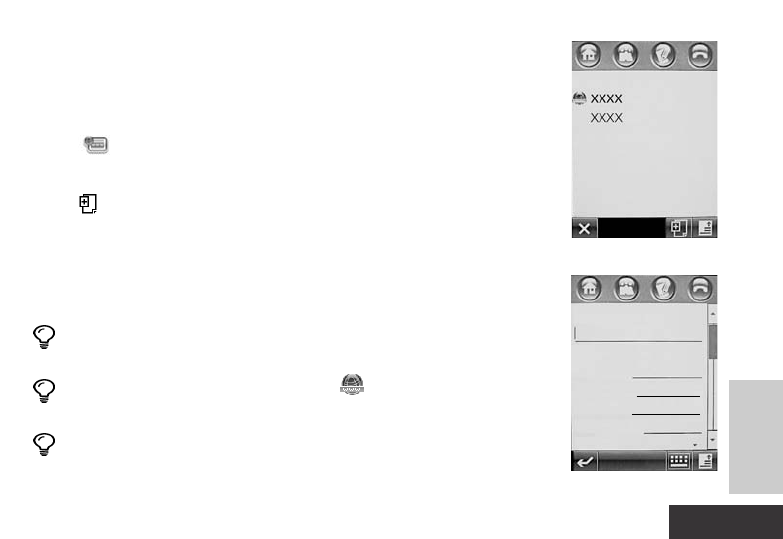
ENGLISH
109
Network
Network
Your phone supports multiple Internet accounts. You may choose an
access method. Configuration for each method is stored in a profile.
Profiles
1. Tap on the main screen to open a screen as shown in Figure 1, in
which you may configure your network connection settings.
2. Tap to create a new profile for your network connection, as shown
in Figure 2.
3. Enter the parameters you have obtained from your network operator
into corresponding fields;
4. Tap OK to complete your setting.
Tips
Your list of network connections may vary depending on
your network operator. Refer to your phone for details.
Tips
The profile marked with icon is the default connection
(See Figure 1).
Tips
To set a profile as the default one: Tap and hold the profile;
Select Set as default from the popup menu.
Figure 1
Figure 2
Disconnect
Internet Profile:
Profile Name:
GPRS Setting:
APN:
User name:
Password:
Re Enter password:
Timeout: off
OK
Network
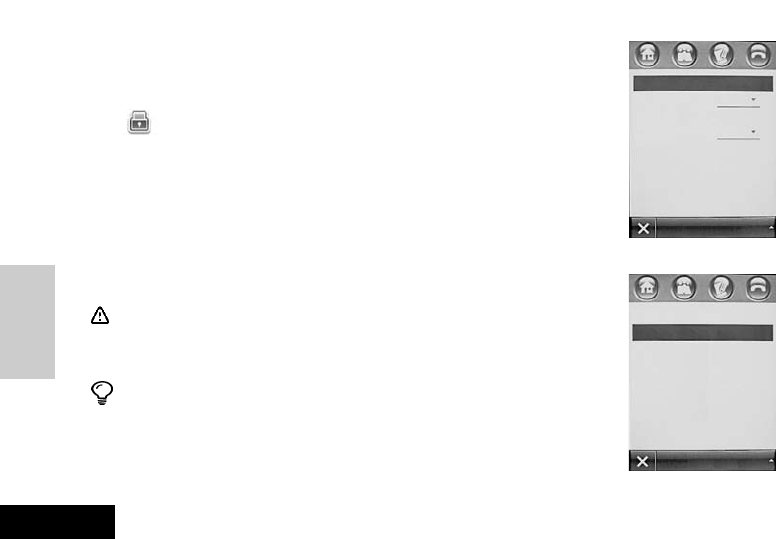
Your phone is supplied with various security functions allowing you to set
up (or modify) a number of passwords and options, in order to protect
the phone from unauthorized use or limit certain functions.
Tap in the Main Screen to enter the Security Setup Screen, as
shown in Figure 1.
You may configure your phone on fixed dialing, whether the PIN code is
required, call barring, or phone lock.
Tap Security Setup and select password. Your phone displays a screen
for you to change a number of codes, including the SIM code and the
call barring code, as shown in Figure 2.
Note
The availability of the fixed dialing function depends on the
type of your SIM card and whether your network operator
offers such a function.
Tips
The call barring service controls the use of your phone by
barring certain outgoing and incoming calls. The availability
of the service depends on whether your network supports it
and whether you have subscribed for it.
Chapter 23 Security
ENGLISH
Security
110 Security
Figure 1
Figure 2
Fixed Dialing (Off)
PIN Request: Off
Call Barring
Phone Lock: Off
Security
Change Passwords:
SIM PIN 1 Code
SIM PIN 2 Code
Call Barring Code
Phone unlock Code
Security Code
password
Security
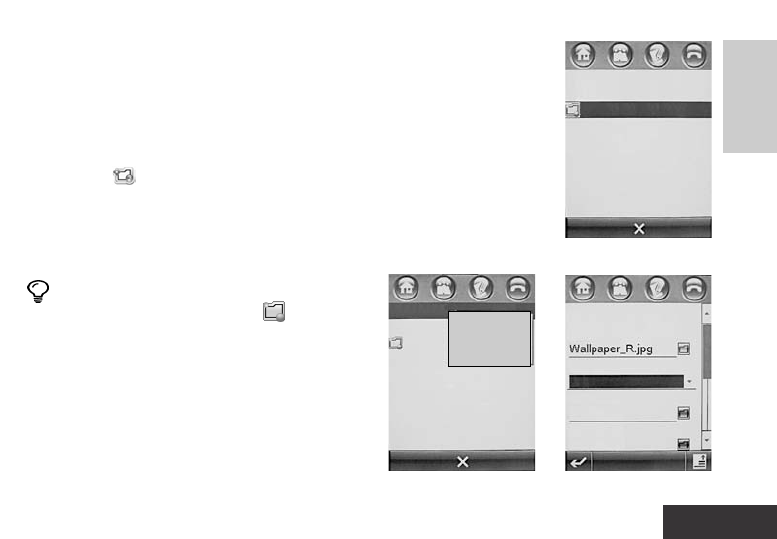
ENGLISH
111
Theme
Theme
Chapter 24 Theme
The Theme setting enables you to select a favorite theme for your phone. A
theme includes a user-defined wallpaper, font size, ring tone for incoming
lines, message alert, normal ring tone, startup screen, and shutdown screen.
Your phone is provided with three themes.
Selecting a theme
1. Tap icon to open the theme screen, as shown in Figure 1.
2. Tap the theme you need and select Set to Current from the popup
menu, as shown in Figure 2. The settings in the theme would over-
write relevant parameters of your phone.
Tips
The current selected theme is
marked with an icon .
Configuring a theme
Tap a theme on the theme setup screen to open
another screen, on which you may configure
details on the theme, as shown in Figure 3. To
view even more setting items, slide the scroll
bar. When you complete items you want to
change, tap Done to save it.
Figure 1
Figure 3Figure 2
Maldives Blue
Atlanta Green
Caribbean Red
Done
Maldive Blue
Atlanta Green
Caribbean Red
Set to Current
Reset to Default
Edit
Caribbean Red
Wallpaper
Text Size
Medium
Incoming Call Line 1
Fire howling
Incoming Call Line 2
Three-in-one
Theme
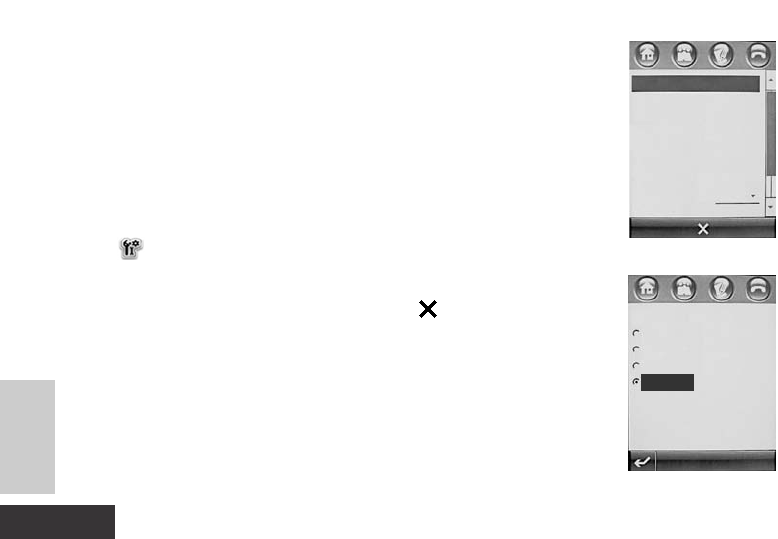
ENGLISH
Setup
112 Setup
Your phone is supplied with the capability allowing you to use a number
of its functions once you insert a SIM card. To satisfy your further
requirements for communication or application modes, you may cus-
tomize these settings.
Each category of settings contains a number of setting items, for which
you may select an option or enter a value. The following paragraphs
details all the setting, items for each setting, and values or options for
each item, which allow you to control your phone in an automatic manner.
Tap from Main Screen to enter the Setup Screen, as shown in Figure
1. By tapping the scroll bar, you may access all the settings you want to
view or change. To return to Main Screen, tap .
The following paragraphs details all the settings, setting items, values or
options, and default values of the items.
Language
The function allows you to select a language for your phone's display. By
tapping Language, you may enter the language selecting screen and
select a language from the selection box as shown in Figure 2.
When you complete your selection, tap Done. The language you select
Chapter 25 Setup
Figure 1
Figure 2
Language
Date and Time
Sound Volume
Input setting
Screen Calibration
Backlight Setup
Voice command
Receive IrDA On
Power Management
Done
Select a Language:
English
Simplified Chinese
Traditional Chinese
Automatic
Setup
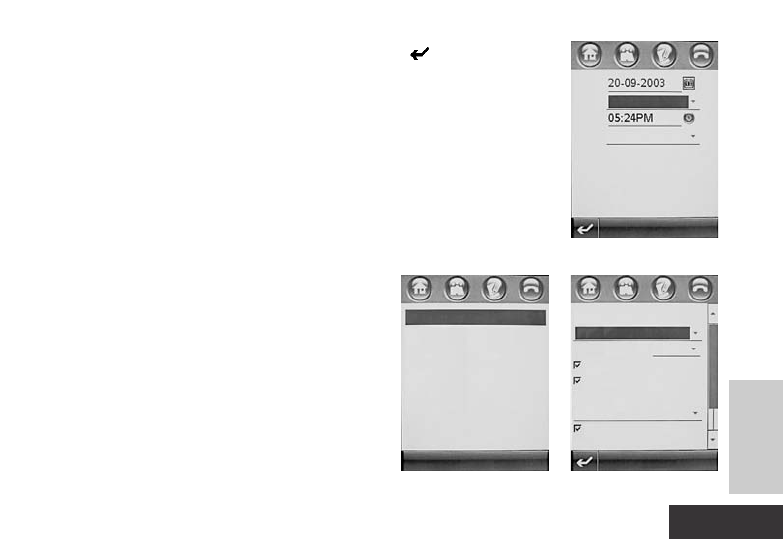
ENGLISH
113
Setup
Setup
would be the one for your phone's display. If you tap , the current lan-
guage setting would remain unchanged.
Date and Time
Tap Date and Time from the Setup Screen, as shown in Figure 1. You may
specify the time and/or the date. Tap Done to return to the Setup Screen.
Sound Volume
Tap Sound Volume from the Setup Screen to enter the Sound volume
setup screen, as shown in Figure 2.
If you tap on an item, you may access a setup
screen for the item.
You may specify the system volume, ring vol-
ume, and/or speaker volume.
Input Setting
Tap Input Setting on the Setup Screen. Your
phone displays a list of items for entry setup, as
shown in Figure 3. You may configure your
favorite entry method, handwriting habit, and/or
handwriting speed.
Figure 1
Figure 3Figure 2
Done
System Volume
Ring Tone Volume
Speaker Volume
Touch Screen
Notifications Alert
Done
Done
Date
Time
dd-mm-yyyy
12 hour clock
Primary Input Method:
Handwriting
Write Hand: Right
Word Completion
User Dictionary
Writing Speed:
Medium
Water Mark
Chinese Handwriting:
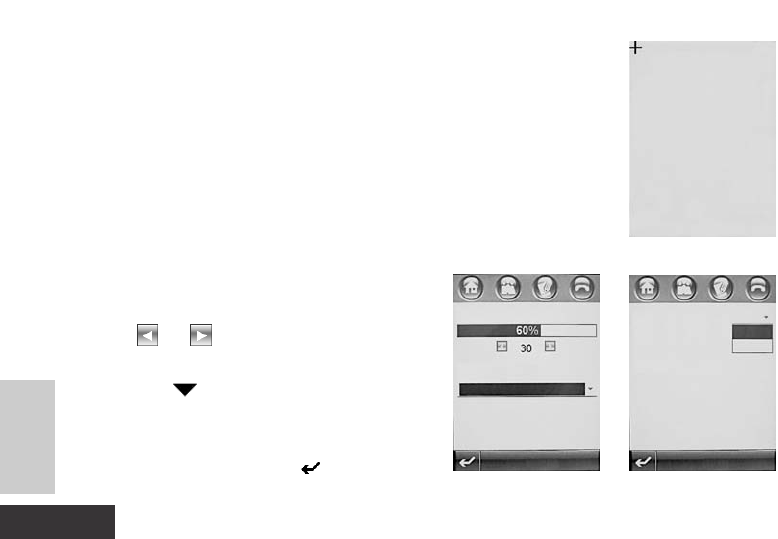
ENGLISH
Setup
114 Setup
Touch Calibration
You should calibrate the touch screen whenever you find the phone
responds incorrectly when you use the stylus to touch a certain position
on the touch screen.
1. Tap Touch Calibration from the Setup Screen to enter the screen for
touch screen calibration, as shown in Figure 1.
2. Follow screen instructions and tap the center of the symbol using your
stylus until you see a message indicating the touch screen has been
calibrated.
Backlight Setup
Tap Backlight Setup from the Setup Screen to
enter the screen as shown in Figure 2.
1. Tap and to adjust the brightness of the
backlight;
2. Tap the symbol under the LCD Sleep
Time to adjust the duration for the backlight;
3. When you complete your setting, tap Done to
save your settings; or tap to return to the
Setup Screen without saving your changes.
Figure 1
Figure 3Figure 2
Done
Tap the center of the target
to align screen
Done
Backlight:
LCD Sleep time
10 Min
Talking phone On
On
Off
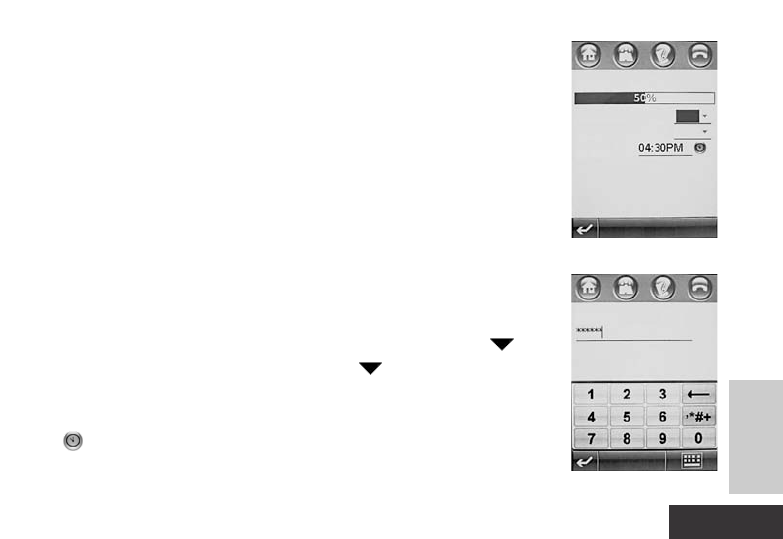
ENGLISH
115
Setup
Setup
Voice Command
Tap Voice Command from the Setup Screen to enter the screen for voice
command setup, where you may turn on or off the reciting function, as
shown in Figure 3. If you turn on the function, your phone would recite
any message you are viewing.
Receive IrDA
The setting allows you to turn on or off the infrared receiving function.
Power Management
Tap Power Management from the Setup Screen to enter the screen for
power management, as shown in Figure 1. The progress bar under
Battery Meter indicates the remaining power of your battery.
You may turn On or Off the power saving mode by tapping the sym-
bol following Battery Save. By tapping the symbol following Auto
Power off, you may turn On or Off the Auto Power off function. If the
function is turned on, you may tap the direct line following off Time or
icon to specify the idle time before you phone is automatically pow-
ered off.
Figure 1
Figure 2
Done
Battery Meter
Battery Save On
Auto Power off On
Off Time
OK
Security Code:
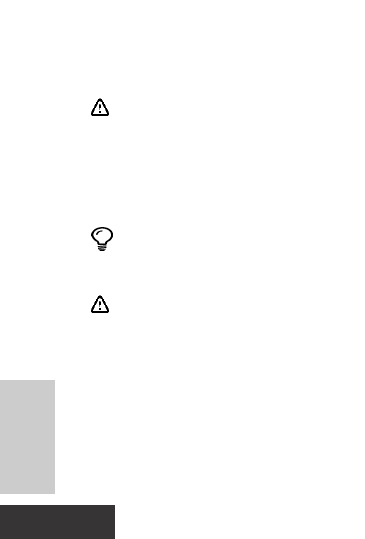
ENGLISH
Setup
116 Setup
Master Reset
Reset all user-defined settings to their factory default.
Note
Be careful to use the function!
If you tap Master Reset, your phone prompts you to enter the security code. When you enter
the code, the screen would appear as in Figure 2. Tap OK. If the code is correct, a dialog box
appears for you to confirm your master resetting. To proceed with the function, tap OK; other-
wise, tap Cancel.
Tips
The default security code of your phone is 000000.
Master Clear
Note
Be careful to use the function!
The function fulfills all the functions of Master Reset. Moreover, it will clear all the information
you have entered, including the Address Book entries. The default security code of your phone
is 000000. If you tap Master Clear, your phone prompts you to enter the security code. When
you enter the code, the screen would appear as in Figure 2 on the previous page. Tap OK. If the
code is correct, a dialog box appears for you to confirm your master clearing. To proceed with
the function, tap OK; otherwise, tap Cancel.

ENGLISH
117
Voice Instruction
Voice Instruction
Voice Instruction allows you to operate on your phone using voice instructions. When you speak
the instruction for a certain function to your phone, it will perform the function.
Tips
To use the Voice Instruction function, you have to load voice recognition whenever
you turn on your phone.
Loading Voice Recognition
To use the Voice Instruction function, you have to load voice recognition
first. Press and hold the Select key on the left side of your phone. Your
phone loads voice recognition when a "Loading" prompt box appears on
the screen, as shown in the right figure. After a while, you'll see a mes-
sage prompting you that the loading (loading of voice recognition) has
been completed successfully. Now you may use the Voice Instruction
function. If the screen indicates that the loading fails, you should try to
load voice recognition once more.
Using Voice Recognition
When the voice recognition has been successfully loaded, press and hold the Select key on the
left side of your phone until the phone alerts you with a tone. Speak a voice instruction to the
phone and then release the Select key. Your phone will perform just as you instructed. The
Voice Instruction function is designed with two modes: Name/Instruction mode and Digit mode.
The default mode is Name/Instruction. However, the Digit Dialing function uses the Digit mode.
The "Dialpad" instruction would start the Digit mode and open a dialpad. In the Digit mode, you
Chapter 26 Voice Instruction
Hide
Loading VR. Please
wait...
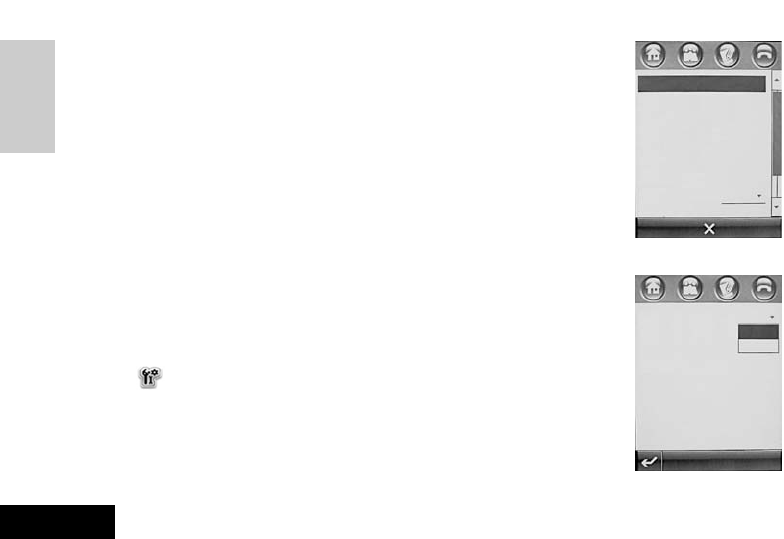
may speak a phone number while pressing and holding the Select key on
the left side of your phone. When you release the Select key, your phone
displays the number it recognized on the dialpad and recites it.
Note: Your phone remains in the Digit mode for a few seconds after each
number recognition. Then it returns to the Name/Instruction mode auto-
matically.
Refer to "List of Voice Instruction and Functions" for available voice
instructions and their corresponding functions.
Reciting
When the voice recognition is loaded, you may specify the message recit-
ing function to have your phone automatically reciting the words of any
message you opened.
To open the Reciting function:
1.
Tap on the Main Screen to enter a setup screen, as shown in Figure 1.
2.
Tap the Voice Command item to enter the screen for voice recognition setup.
3. Tap the drop list box following Talking phone and select On, as shown
in Figure 2.
4. Tap Done to turn on the message reciting function.
ENGLISH
Voice Instruction
118 Voice Instruction
Figure 1
Figure 2
Language
Date and Time
Sound Volume
Input setting
Screen Calibration
Backlight Setup
Voice command
Receive IrDA On
Power Management
Talking phone: On
On
Off
Done
Setup
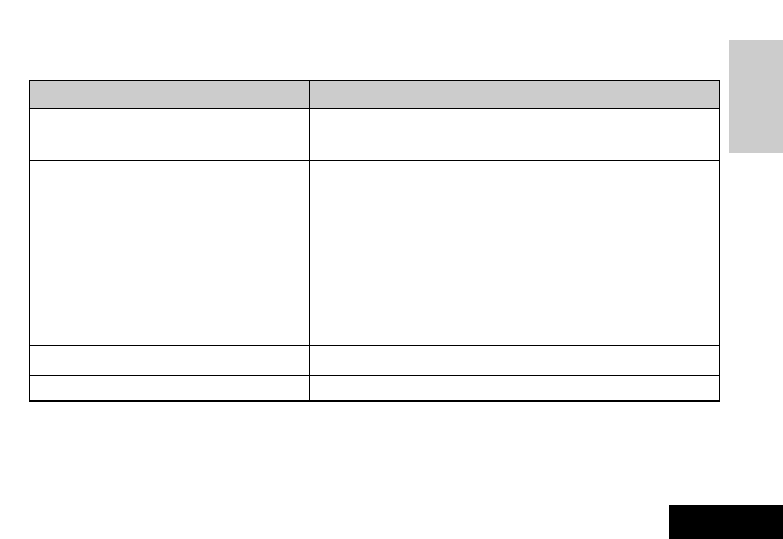
ENGLISH
119
Voice Instruction
Voice Instruction
List of Voice Instruction and Functions
Voice Instruction Function
Name + Mobile(CellPhone,Call)/ The corresponding number will be highlighted. Press
the Select key to dial the number.
Open Digit Dial/Open DialPad You should perform the voice instruction for digit dial-
ing. When the instruction is completed, you may press
the Select key on the left side of your phone once
again and speak a number. Release the softkey. Your
phone would recite the number you speak. If you have
inputted a correct number, press the Select key to dial
it; otherwise, press the Select key and repeat the num-
ber within 10 seconds of your phone's reciting. If it
exceeds 10 seconds, you should repeat the Open
Dial-up/Dial-up instruction.
Go Back Your phone exits the current function screen.
Redial Your phone recites the number you last dialed.
Work(Office) / Home
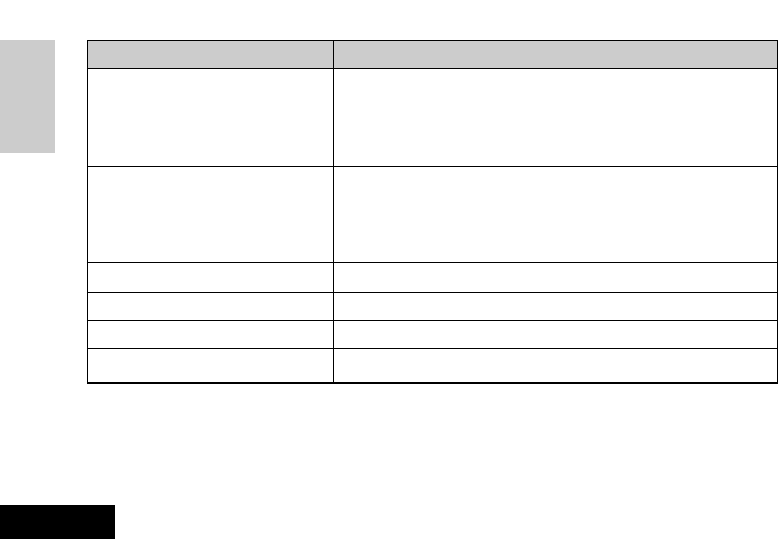
ENGLISH
Voice Instruction
120 Voice Instruction
Voice Instruction Function
Check New Messages/
When your phone alerts you that there is a new incoming short
message, you may press and hold the softkey to perform the com-
mand. You phone would tell you the number of messages you
receive and the name or number of each sender. (Short messages
you have viewed are excluded from the number.)
Check Missed Calls
When your phone alerts you that there is a new incoming call, you
may press and hold the softkey to perform the command. You
phone would tell you the number of incoming calls and the name
or number of each caller. (Missed calls you have viewed are
excluded from the number.)
Check Time
Your phone recites the current time displayed on the screen.
Check Battery
Your phone recites the remained battery power in percentage.
Check Signal
Your phone recites the signal strength in percentage.
Go to Homepage/Homepage
Return to the Main Screen.
Note: Keep holding the Select key on the left side of your phone when performing the above voice instruc-
tions. Do not release the key until the command has been performed successfully. If your phone cannot rec-
ognize the voice instruction you speak, it will prompt you to repeat your operation.
All the above instructions except "Go to Homepage/Homepage" and "Exit" may be performed when your
phone cover is closed and an earphone is connected.
SMS
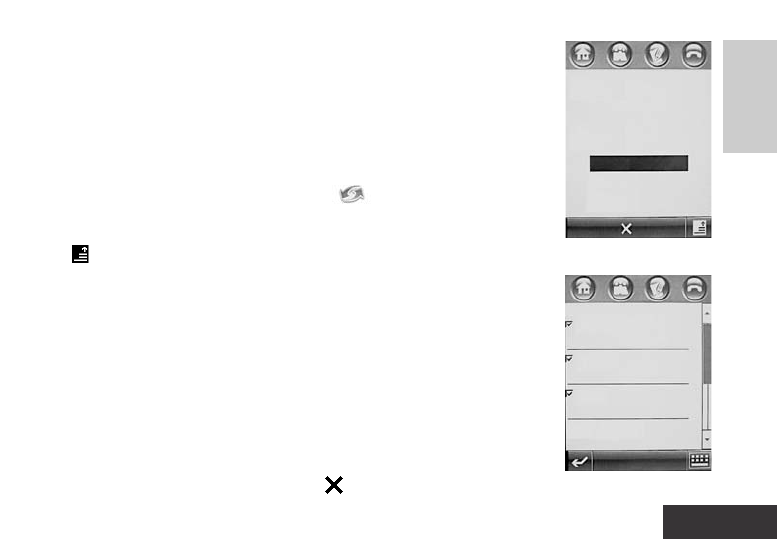
ENGLISH
121
Synchronization
Synchronization
Your phone is supplied with data synchronization capability, which allows
you to perform data update and transfer between data stored in your
phone's Phone Address Book, SIM Address Book, Calendar, and Tasks
with that stored in other phones, your computers, or other devices.
You may perform data synchronization by connecting your phone to
other devices via data cables, Infrared connections, or OTA.
In the Main Screen of your phone: Tap the symbol to enter the syn-
chronization function, as shown in the right Figure 1.
1.
Tap to pop up a menu containing OTA Sync Setup. If you want to use the
OTA method, you should configure the OTA synchronization. Select OTA Sync
Setup to show a screen in Figure 2. Enter the content and tap OK.
2. Select a connection type from the list under the Sync Via.
3. Your phone displays "Synchronizing..." If you tap Cancel right now or
a failure occurs during the synchronization, a Sync Failed dialog box
appears; if the synchronization is finished successfully, a detailed list
displays on the screen.
4. Tap OK; your phone returns to the Synchronization Function Screen.
5.
In the Synchronization Function Screen, tap to return to the Main Screen.
Chapter 27 Data Synchronization
Figure 1
Figure 2
Last Sync:
Synchronize Via:
OK
USB Cable
IR Link
OTA
Data Paths:
Address Book:
Calendar:
Tasks:
Server URL:
Sync

ENGLISH 122 Modem
Modem
Note:
The following description covers meaningless characters on the screen display during mobile
synchronization.
Mobile PIM (Phonebook, Datebook, and To Do List): UTF8, GB2312, and BTG5 are available for
coding of Chinese characters. Whether Chinese characters may be decoded properly is depend-
ent on the language settings on both your mobile and your PC.
To transfer Simplified Chinese characters from your mobile to your PC, you must select Simplified
Chinese for the language setting of the mobile. If your PC runs on an English OS, the language
should be changed to Simplified Chinese by operating as follows: Start Settings Control
Panel Regional Options Language Settings for the System Simplified Chinese (Default).
Follow the same steps for Traditional Chinese.
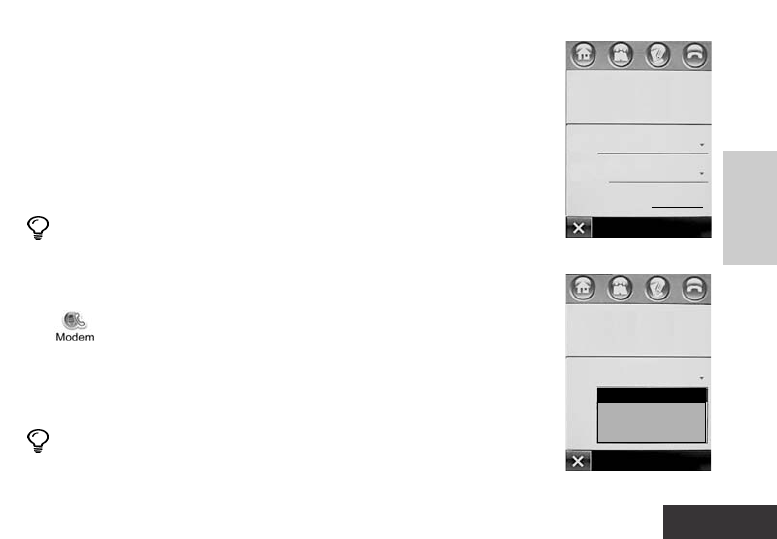
ENGLISH
123
Modem
Modem
Your phone is embedded with a modem, which may be used for Internet
access to browse information or download data in a wireless and mobile
manner, by connecting your phone to a computer with cables or via
Bluetooth/Infrared.
It is easy to make use of the modem. If you want to access the Internet
via data call, you may configure the "mobile" modem just as you do for
setting a standard modem on a normal computer.
Tips
To connect your phone to a computer via Bluetooth or
Infrared, make sure your computer supports Bluetooth or
Infrared transmission and has been installed with correct
drivers.
Tap on the Main Screen to enter the Modem Setup Screen, as
shown in the Figure 1.
1. Tap the combo box following Use to select a transmission method as
necessary, such as USB Cable, RS-232 Cable, IR Link, or Bluetooth.
Tips
If you decide to employ a serial cable for data transmission
make sure the baud rate is defined.
Chapter 28 Modem
Figure 1
Figure 2
Find Device
Modem Status:
Not ready
Use: USB Cable
Baud rate: 115200
:
OK
Modem Status:
Not ready
Use: USB Cable
Baud rate: 115200
USB Cable
RS-232 Cable
IR Link
Bluetooth

ENGLISH
Center
124 Center
2. When completing your configuration, tap Find Device. The modem status is indicated as
Ready; tap Disconnect, the status becomes Not ready.
3. Once data transmission between your phone and your computer is normal via a USB cable,
data cable, Bluetooth, or Infrared, you may access the Internet from the computer via the
phone just as you do with a normal modem.
Tips
If you employ Bluetooth to establish the connection, you will be prompted to enter
your password. Enter the correct password as required by your phone.
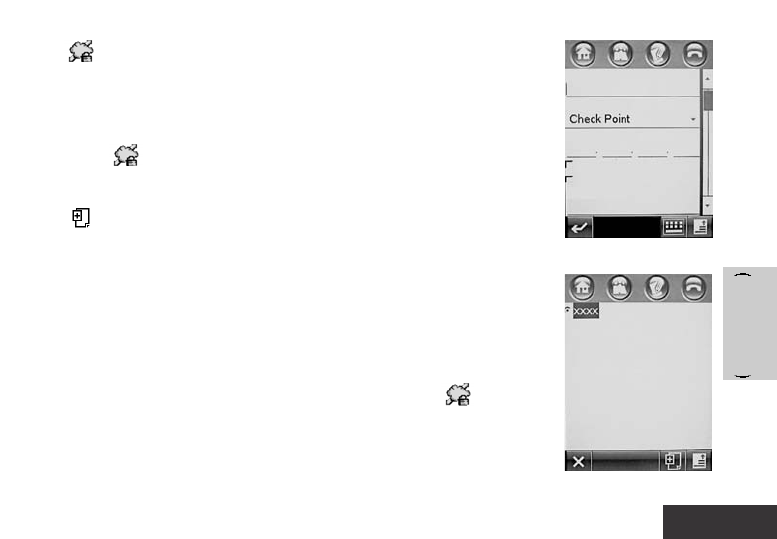
ENGLISH
125
VPN (Virtual Private Network)
VPN
Virtual Private Network
Tap on the Main Screen to open a screen for authentication, on
which you may tap Agree to access the VPN function.
Creating New Policy
If you tap without any policy, your phone displays no policy. In
such a case, do as follows:
1. Tap to open the New Policy Screen, as shown in Figure 1. To view
additional options, scroll down the Scroll Bar;
2. Enter information for each option to specify the policy. When you finish
setting, tap Done to save your setup. The Policy List appears on the
screen, as shown in Figure 2.
Logging into the VPN
If you have created one or more policies, you may tap to show
the Policy List.
1. Tap and hold a policy to pop up a menu, from which you may select
Edit to edit the policy, or Delete to delete the policy;
Chapter 29 VPN (Virtual Private Network)
Figure 1
Figure 2
Done
Policy Name
Gateway Type
Gateway IP Address:
Split Tunnelling
Perfect Forward Secrecy
User name
Log in
movian VPN
movian VPN
movian VPN
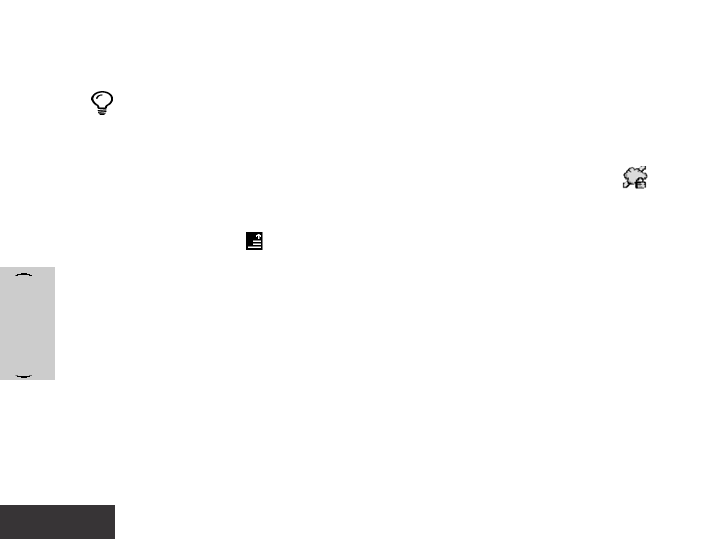
ENGLISH
VPN
Virtual Private Network
126 VPN (Virtual Private Network)
2. Select a policy from the Policy List as desired. Tap Log in and enter the password to log in
the VPN. When the logging in is successful, your phone returns to the Main Screen;
Tips
You should get ready your network connection before logging in the VPN. Refer to
the chapter on network for details.
3. To disconnect your phone from the VPN on which you have logged: Go to the Main Screen
(provided that your phone has been connected to the VPN); tap the VPN symbol to
show the Policy List; a Disconnect button appears at the bottom; tap Disconnect;
4. Tap the Menu Key to pop up a menu, from which you may select Edit or Delete to edit or
delete the policy you have selected.
movian VPN
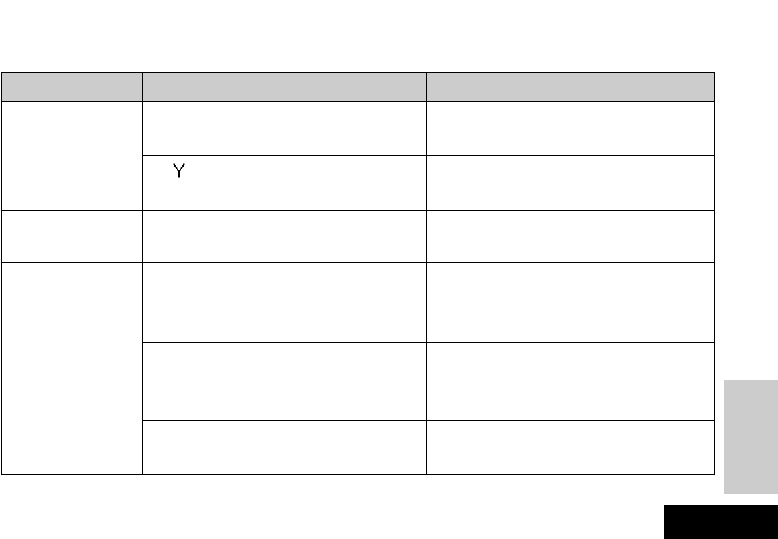
ENGLISH
127
Troubleshooting
Troublesho
oting
Check the following questions if you have problems with operating your phone.
Problems Reasons Solutions
Chapter 30 Troubleshooting
I cannot access
the Internet prop-
erly using the
Browser or
Email.
My phone seems
to be slow when I
touch the screen.
I cannot receive
calls and mes-
sages satisfacto-
rily.
•
Your network operator does not
offer the service or you have not
subscribed for the service.
•
ou have not configured the serv-
ice properly.
•
You have not calibrated your
touch screen properly.
•
You are using your phone in an
area with poor network coverage
(out of reach of radio signals),
such as a place near a tall build-
ing or in a basement.
•
You are using your phone during
busy period of the network when
the line is busy, such as on-duty
or off-duty period.
•
Your phone is far from any base
station of your network.
Contact your network operator on
how to subscribe for and use the
service.
Refer relevant chapters in the User's
Guide for detailed description on the
Browser and Email.
Calibrate your touch screen. Refer to
the description in the User's Guide on
how to calibrate it.
Avoid using your phone in such
places.
Avoid using your phone in such peri-
ods.
Contact your network operator for a
service coverage chart.
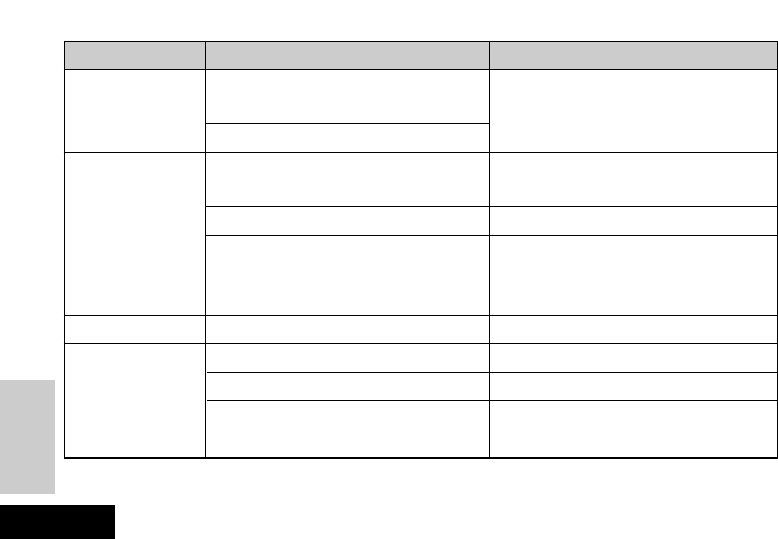
Problems Reasons Solutions
•
It is a regional problem due to
poor network trunk quality.
•
Line quality is poor in certain areas.
•
The standby time of your battery
varies depending on the system
configuration of your network.
•
You need to replace the battery with a new one.
•
The standby time will be shortened when
your phone cannot receive signals, when
it continuously emits radio signals to
search for a base station, consuming a
lot of your battery's power.
•
Your battery is exhausted.
•
SIM card damaged.
•
You have inserted the SIM card incorrectly.
•
Metallic surface of your SIM card
is dirty.
ENGLISH
Troublesho
oting
128 Troubleshooting
I hear echo or
noise.
My battery didn't
last as long as I
expected.
I cannot turn on my phone.
SIM card error
Hung up and dial once again. The
trunk may distribute a better line for
your call.
Turn off your phone in areas with
poor network coverage.
Replace a new battery.
Move to an area with more strength-
ened signals or turn off your phone
temporarily.
Recharge your battery.
Contact your network operator.
Make sure the SIM card is inserted properly.
Clean metallic contacts of your SIM
card using clean cloth.
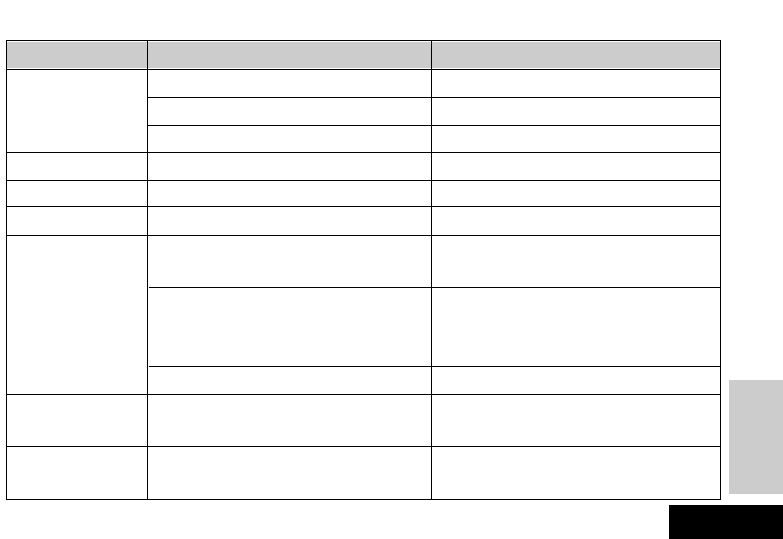
Problems Reasons Solutions
ENGLISH
129
Troublesho
oting
I cannot connect
my phone to the
network.
I cannot transmit
messages.
I cannot make a phone call.
PIN error
I cannot charge
my battery.
I cannot enter new
entries into my
Address Book
I cannot config-
ure certain func-
tions.
•
SIM card invalid
•
Out of the GSM coverage
•
Signal is weak
•
Your network operator does not
offer the service.
•
The call barring function has been enabled.
•
You have entered three incorrect PIN codes in series.
•
The voltage is out of the rated
range of the charger.
•
You use a nonstandard charger.
•
Poor contact
•
The Address Book or the dynamic
memory is full.
•
Your network operator does not
offer these functions or you have
not subscribed for them.
Contact your network operator.
Contact your network operator for details on the service area.
Move to an area with strengthened signals and try again.
Contact your network operator.
Disable the call barring function.
Contact your network operator.
Use voltage falling within the rated
range of the charger.
Use a battery charger designed for the
mobile phone. For example, SPN5052X
series (X may be A, B, etc.).
(For exaple,
Make sure the plug is securely connected.
Delete some of your Address Book
entries or remove some other data.
Contact your network operator.
Troubleshooting

ENGLISH
Specific
Absorption Rate
130 Specific Absorption Rate
This model phone meets the international requirements for expo-
sure to radio waves.
Your mobile phone is a radio transmitter and receiver. It is designed and manufactured not to
exceed limits for exposure to radio frequency (RF) energy. These limits are part of comprehen-
sive guidelines and establish permitted levels of RF energy for the general population. The
guidelines are based on standards that were developed by independent scientific organizations
through periodic and thorough evaluation of scientific studies. The guidelines include a substan-
tial safety margin designed to assure the safety of all persons, regardless of age and health.
The exposure standard for mobile phones employs a unit of measurement known as the
Specific Absorption Rate, or SAR. Under the guidelines for your phone model, the SAR limit is
2.0 W/kg*. Tests for SAR are conducted based on CENELEC** testing procedure, using stan-
dard operating positions with the phone transmitting at its highest certified power level in all
tested frequency bands. Although the SAR is determined at the highest certified power level,
the actual SAR of the phone while operating can be well below the maximum value. This is
because the phone is designed to operate at multiple power levels so as to use only the power
required to reach the network. In general, the closer you are to a base station, the lower the
power output of the phone.
Before a phone model is available for sale to the public, it is tested to confirm compliance with
Chapter 31 Specific Absorption Rate

ENGLISH
131
Specific Absorption Rate
Specific
Absorption Rate
the guidelines. The tests are performed in positions and locations that conform to a uniform
testing methodology determined by an expert standards body. The highest SAR value for this
model phone when tested for use at the ear is 0.639 W/kg***.
It shall be noted that the SAR level may vary when the phone is modified. In all cases, the
phone has been designed by strictly observing a guideline.
The SAR limit for mobile phones used by the public is recommended by ICNIRP as 2.0 watts/kilogram
(W/kg) averaged over ten grams of tissue. The limit incorporates a substantial margin for safety to give
additional protection for the public and to account for any variations in measurements.
CENELEC is a European standard body.
Additional information for the mobile phone model includes a range of Motorola Testing Agreement,
Assessment Procedure, and Testing Method.

ENGLISH
Appendix
132 Appendix
Chapter 32 Appendix
GNU GENERAL PUBLIC LICENSE
Version 2, June 1991
Copyright (C) 1989, 1991 Free Software Foundation, Inc.
59 Temple Place - Suite 330, Boston, MA 02111-1307, USA
Everyone is permitted to copy and distribute verbatim copies
of this license document, but changing it is not allowed.
Preamble
The licenses for most software are designed to take away your freedom to share and
change it. By contrast, the GNU General Public License is intended to guarantee your
freedom to share and change free software--to make sure the software is free for all
its users. This General Public License applies to most of the Free Software
Foundation's software and to any other program whose authors commit to using it.
(Some other Free Software Foundation software is covered by the GNU Library
General Public License instead.) You can apply it to your programs, too.
When we speak of free software, we are referring to freedom, not price. Our General
Public Licenses are designed to make sure that you have the freedom to distribute
copies of free software (and charge for this service if you wish), that you receive

ENGLISH
133
Appendix
Appendix
source code or can get it if you want it, that you can change the software or use
pieces of it in new free programs; and that you know you can do these things.
To protect your rights, we need to make restrictions that forbid anyone to deny you
these rights or to ask you to surrender the rights. These restrictions translate to certain
responsibilities for you if you distribute copies of the software, or if you modify it.
For example, if you distribute copies of such a program, whether gratis or for a fee,
you must give the recipients all the rights that you have. You must make sure that
they, too, receive or can get the source code. And you must show them these terms
so they know their rights.
We protect your rights with two steps: (1) copyright the software, and (2) offer you this
license which gives you legal permission to copy, distribute and/or modify the soft-
ware.
Also, for each author's protection and ours, we want to make certain that everyone
understands that there is no warranty for this free software. If the software is modified
by someone else and passed on, we want its recipients to know that what they have is
not the original, so that any problems introduced by others will not reflect on the origi-
nal authors' reputations.
Finally, any free program is threatened constantly by software patents. We wish to

ENGLISH
Appendix
134 Appendix
avoid the danger that redistributors of a free program will individually obtain patent
licenses, in effect making the program proprietary. To prevent this, we have made it
clear that any patent must be licensed for everyone's free use or not licensed at all.
The precise terms and conditions for copying, distribution and modification follow.
TERMS AND CONDITIONS FOR COPYING, DISTRIBUTION AND MODIFICATION
0. This License applies to any program or other work which contains a notice placed
by the copyright holder saying it may be distributed under the terms of this General
Public License. The "Program", below, refers to any such program or work, and a
"work based on the Program" means either the Program or any derivative work under
copyright law: that is to say, a work containing the Program or a portion of it, either
verbatim or with modifications and/or translated into another language. (Hereinafter,
translation is included without limitation in the term "modification".) Each licensee is
addressed as "you".
Activities other than copying, distribution and modification are not covered by this
License; they are outside its scope. The act of running the Program is not restricted,
and the output from the Program is covered only if its contents constitute a work
based on the Program (independent of having been made by running the Program).
Whether that is true depends on what the Program does.

ENGLISH
135
Appendix
Appendix
1. You may copy and distribute verbatim copies of the Program's source code as you
receive it, in any medium, provided that you conspicuously and appropriately publish
on each copy an appropriate copyright notice and disclaimer of warranty; keep intact
all the notices that refer to this License and to the absence of any warranty; and give
any other recipients of the Program a copy of this License along with the Program.
You may charge a fee for the physical act of transferring a copy, and you may at your
option offer warranty protection in exchange for a fee.
2. You may modify your copy or copies of the Program or any portion of it, thus form-
ing a work based on the Program, and copy and distribute such modifications or work
under the terms of Section 1 above, provided that you also meet all of these condi-
tions:
• a) You must cause the modified files to carry prominent notices stating that you
changed the files and the date of any change.
• b) You must cause any work that you distribute or publish, that in whole or in part
contains or is derived from the Program or any part thereof, to be licensed as a
whole at no charge to all third parties under the terms of this License.
• c) If the modified program normally reads commands interactively when run, you
must cause it, when started running for such interactive use in the most ordinary

ENGLISH
Appendix
136 Appendix
way, to print or display an announcement including an appropriate copyright notice
and a notice that there is no warranty (or else, saying that you provide a warranty)
and that users may redistribute the program under these conditions, and telling the
user how to view a copy of this License. (Exception: if the Program itself is interac-
tive but does not normally print such an announcement, your work based on the
Program is not required to print an announcement.)
These requirements apply to the modified work as a whole. If identifiable sections of
that work are not derived from the Program, and can be reasonably considered inde-
pendent and separate works in themselves, then this License, and its terms, do not
apply to those sections when you distribute them as separate works. But when you
distribute the same sections as part of a whole which is a work based on the Program,
the distribution of the whole must be on the terms of this License, whose permissions
for other licensees extend to the entire whole, and thus to each and every part regard-
less of who wrote it.
Thus, it is not the intent of this section to claim rights or contest your rights to work
written entirely by you; rather, the intent is to exercise the right to control the distribu-
tion of derivative or collective works based on the Program.
In addition, mere aggregation of another work not based on the Program with the

ENGLISH
137
Appendix
Appendix
Program (or with a work based on the Program) on a volume of a storage or distribu-
tion medium does not bring the other work under the scope of this License.
3. You may copy and distribute the Program (or a work based on it, under Section 2)
in object code or executable form under the terms of Sections 1 and 2 above provided
that you also do one of the following:
• a) Accompany it with the complete corresponding machine-readable source code,
which must be distributed under the terms of Sections 1 and 2 above on a medium
customarily used for software interchange; or,
• b) Accompany it with a written offer, valid for at least three years, to give any third
party, for a charge no more than your cost of physically performing source distribu-
tion, a complete machine-readable copy of the corresponding source code, to be
distributed under the terms of Sections 1 and 2 above on a medium customarily
used for software interchange; or,
• c) Accompany it with the information you received as to the offer to distribute corre-
sponding source code. (This alternative is allowed only for noncommercial distribu-
tion and only if you received the program in object code or executable form with
such an offer, in accord with Subsection b above.)
The source code for a work means the preferred form of the work for making modifica-

ENGLISH
Appendix
138 Appendix
tions to it. For an executable work, complete source code means all the source code
for all modules it contains, plus any associated interface definition files, plus the
scripts used to control compilation and installation of the executable. However, as a
special exception, the source code distributed need not include anything that is nor-
mally distributed (in either source or binary form) with the major components (compil-
er, kernel, and so on) of the operating system on which the executable runs, unless
that component itself accompanies the executable.
If distribution of executable or object code is made by offering access to copy from a
designated place, then offering equivalent access to copy the source code from the
same place counts as distribution of the source code, even though third parties are
not compelled to copy the source along with the object code.
4. You may not copy, modify, sublicense, or distribute the Program except as express-
ly provided under this License. Any attempt otherwise to copy, modify, sublicense or
distribute the Program is void, and will automatically terminate your rights under this
License. However, parties who have received copies, or rights, from you under this
License will not have their licenses terminated so long as such parties remain in full
compliance.
5. You are not required to accept this License, since you have not signed it. However,

ENGLISH
139
Appendix
Appendix
nothing else grants you permission to modify or distribute the Program or its derivative
works. These actions are prohibited by law if you do not accept this License.
Therefore, by modifying or distributing the Program (or any work based on the
Program), you indicate your acceptance of this License to do so, and all its terms and
conditions for copying, distributing or modifying the Program or works based on it.
6. Each time you redistribute the Program (or any work based on the Program), the
recipient automatically receives a license from the original licensor to copy, distribute
or modify the Program subject to these terms and conditions. You may not impose any
further restrictions on the recipients' exercise of the rights granted herein. You are not
responsible for enforcing compliance by third parties to this License.
7. If, as a consequence of a court judgment or allegation of patent infringement or for
any other reason (not limited to patent issues), conditions are imposed on you
(whether by court order, agreement or otherwise) that contradict the conditions of this
License, they do not excuse you from the conditions of this License. If you cannot dis-
tribute so as to satisfy simultaneously your obligations under this License and any
other pertinent obligations, then as a consequence you may not distribute the
Program at all. For example, if a patent license would not permit royalty-free redistrib-
ution of the Program by all those who receive copies directly or indirectly through you,

ENGLISH
Appendix
140 Appendix
then the only way you could satisfy both it and this License would be to refrain entirely
from distribution of the Program.
If any portion of this section is held invalid or unenforceable under any particular cir-
cumstance, the balance of the section is intended to apply and the section as a whole
is intended to apply in other circumstances.
It is not the purpose of this section to induce you to infringe any patents or other prop-
erty right claims or to contest validity of any such claims; this section has the sole pur-
pose of protecting the integrity of the free software distribution system, which is imple-
mented by public license practices. Many people have made generous contributions
to the wide range of software distributed through that system in reliance on consistent
application of that system; it is up to the author/donor to decide if he or she is willing to
distribute software through any other system and a licensee cannot impose that
choice.
This section is intended to make thoroughly clear what is believed to be a conse-
quence of the rest of this License.
8. If the distribution and/or use of the Program is restricted in certain countries either
by patents or by copyrighted interfaces, the original copyright holder who places the
Program under this License may add an explicit geographical distribution limitation

ENGLISH
141
Appendix
Appendix
excluding those countries, so that distribution is permitted only in or among countries
not thus excluded. In such case, this License incorporates the limitation as if written in
the body of this License.
9. The Free Software Foundation may publish revised and/or new versions of the
General Public License from time to time. Such new versions will be similar in spirit to
the present version, but may differ in detail to address new problems or concerns.
Each version is given a distinguishing version number. If the Program specifies a ver-
sion number of this License which applies to it and "any later version", you have the
option of following the terms and conditions either of that version or of any later ver-
sion published by the Free Software Foundation. If the Program does not specify a
version number of this License, you may choose any version ever published by the
Free Software Foundation.
10. If you wish to incorporate parts of the Program into other free programs whose dis-
tribution conditions are different, write to the author to ask for permission. For software
which is copyrighted by the Free Software Foundation, write to the Free Software
Foundation; we sometimes make exceptions for this. Our decision will be guided by
the two goals of preserving the free status of all derivatives of our free software and of
promoting the sharing and reuse of software generally.

ENGLISH
Appendix
142 Appendix
NO WARRANTY
11. BECAUSE THE PROGRAM IS LICENSED FREE OF CHARGE, THERE IS NO
WARRANTY FOR THE PROGRAM, TO THE EXTENT PERMITTED BY APPLICA-
BLE LAW. EXCEPT WHEN OTHERWISE STATED IN WRITING THE COPYRIGHT
HOLDERS AND/OR OTHER PARTIES PROVIDE THE PROGRAM "AS IS" WITH-
OUT WARRANTY OF ANY KIND, EITHER EXPRESSED OR IMPLIED, INCLUDING,
BUT NOT LIMITED TO, THE IMPLIED WARRANTIES OF MERCHANTABILITY AND
FITNESS FOR A PARTICULAR PURPOSE. THE ENTIRE RISK AS TO THE QUALI-
TY AND PERFORMANCE OF THE PROGRAM IS WITH YOU. SHOULD THE PRO-
GRAM PROVE DEFECTIVE, YOU ASSUME THE COST OF ALL NECESSARY SER-
VICING, REPAIR OR CORRECTION.
12. IN NO EVENT UNLESS REQUIRED BY APPLICABLE LAW OR AGREED TO IN
WRITING WILL ANY COPYRIGHT HOLDER, OR ANY OTHER PARTY WHO MAY
MODIFY AND/OR REDISTRIBUTE THE PROGRAM AS PERMITTED ABOVE, BE
LIABLE TO YOU FOR DAMAGES, INCLUDING ANY GENERAL, SPECIAL, INCI-
DENTAL OR CONSEQUENTIAL DAMAGES ARISING OUT OF THE USE OR
INABILITY TO USE THE PROGRAM (INCLUDING BUT NOT LIMITED TO LOSS OF
DATA OR DATA BEING RENDERED INACCURATE OR LOSSES SUSTAINED BY

ENGLISH
143
Appendix
Appendix
YOU OR THIRD PARTIES OR A FAILURE OF THE PROGRAM TO OPERATE WITH
ANY OTHER PROGRAMS), EVEN IF SUCH HOLDER OR OTHER PARTY HAS
BEEN ADVISED OF THE POSSIBILITY OF SUCH DAMAGES.
END OF TERMS AND CONDITIONS
How to Apply These Terms to Your New Programs
If you develop a new program, and you want it to be of the greatest possible use to
the public, the best way to achieve this is to make it free software which everyone can
redistribute and change under these terms.
To do so, attach the following notices to the program. It is safest to attach them to the
start of each source file to most effectively convey the exclusion of warranty; and each
file should have at least the "copyright" line and a pointer to where the full notice is
found.
one line to give the program's name and an idea of what it does.
Copyright (C) yyyy name of author
This program is free software; you can redistribute it and/or modify it under the terms
of the GNU General Public License as published by the Free Software Foundation;
either version 2 of the License, or (at your option) any later version.

ENGLISH
Appendix
144 Appendix
This program is distributed in the hope that it will be useful, but WITHOUT ANY WAR-
RANTY; without even the implied warranty of MERCHANTABILITY or FITNESS FOR
A PARTICULAR PURPOSE. See the GNU General Public License for more details.
You should have received a copy of the GNU General Public License along with this
program; if not, write to the Free Software Foundation, Inc., 59 Temple Place - Suite
330, Boston, MA 02111-1307, USA.
Also add information on how to contact you by electronic and paper mail.
If the program is interactive, make it output a short notice like this when it starts in an
interactive mode:
Gnomovision version 69, Copyright (C) year name of author Gnomovision comes with
ABSOLUTELY NO WARRANTY; for details type 'show w'. This is free software, and
you are welcome to redistribute it under certain conditions; type 'show c' for details.
The hypothetical commands 'show w' and 'show c' should show the appropriate parts
of the General Public License. Of course, the commands you use may be called
something other than 'show w' and 'show c'; they could even be mouse-clicks or menu
items--whatever suits your program.
You should also get your employer (if you work as a programmer) or your school, if

ENGLISH
145
Appendix
Appendix
any, to sign a "copyright disclaimer" for the program, if necessary. Here is a sample;
alter the names:
Yoyodyne, Inc., hereby disclaims all copyright interest in the program 'Gnomovision'
(which makes passes at compilers) written
by James Hacker.
signature of Ty Coon, 1 April 1989
Ty Coon, President of Vice
This General Public License does not permit incorporating your program into propri-
etary programs. If your program is a subroutine library, you may consider it more use-
ful to permit linking proprietary applications with the library. If this is what you want to
do, use the GNU Library General Public License instead of this License.
OFFER TO CUSTOMERS
Until September 30, 2006 you may request from Motorola the source code for any
Portions of this product which are licensed under the GNU General Public license by
writing to the following address:
Beijing Design Center, PCS

ENGLISH
Appendix
146 Appendix
Motorola (China) Electronics Ltd.
No. 2 Dong San Huan Nan. Lu
Chao Yang District
Beijing, P.R. China
100022
Tel. 010-65642288
Fax: 010-65642299